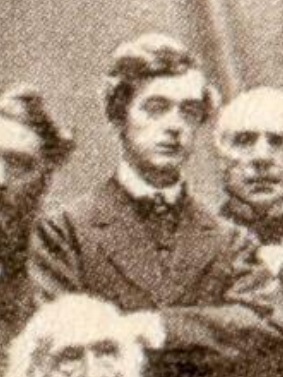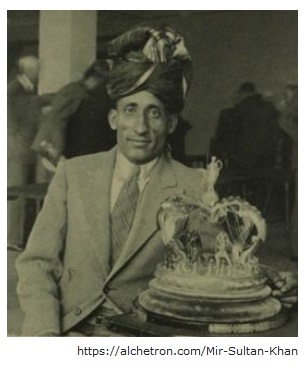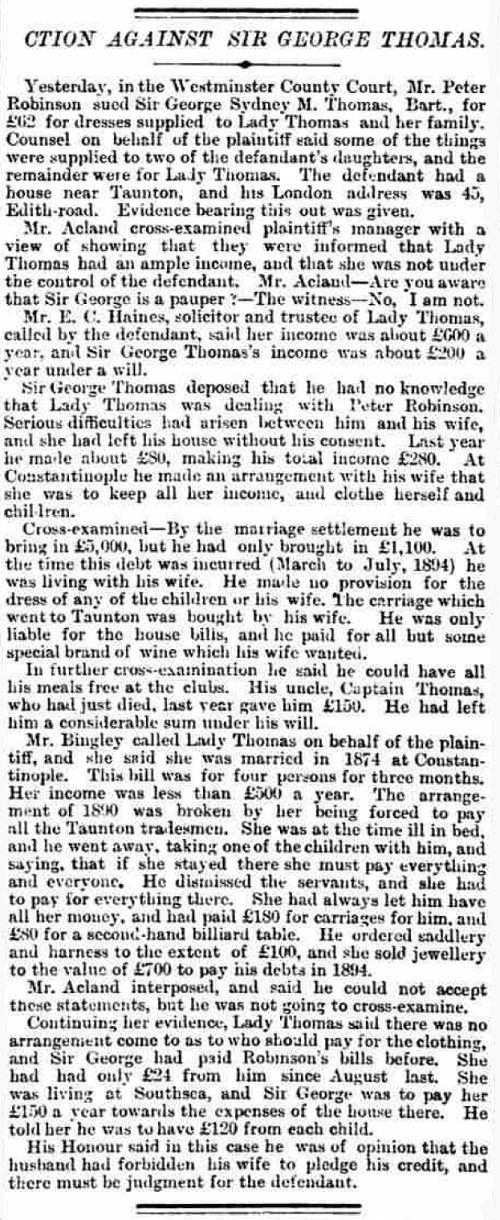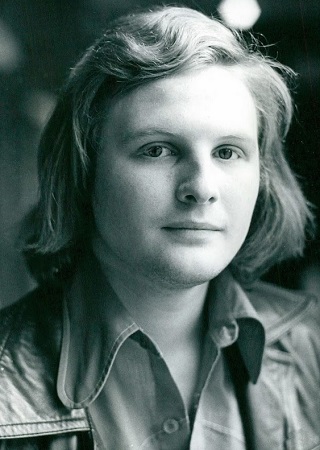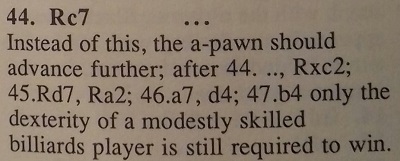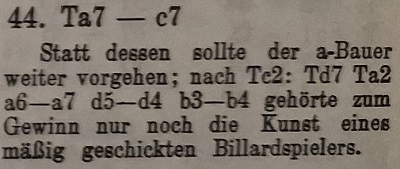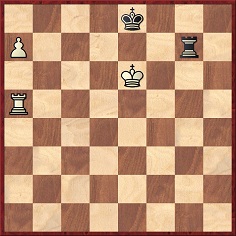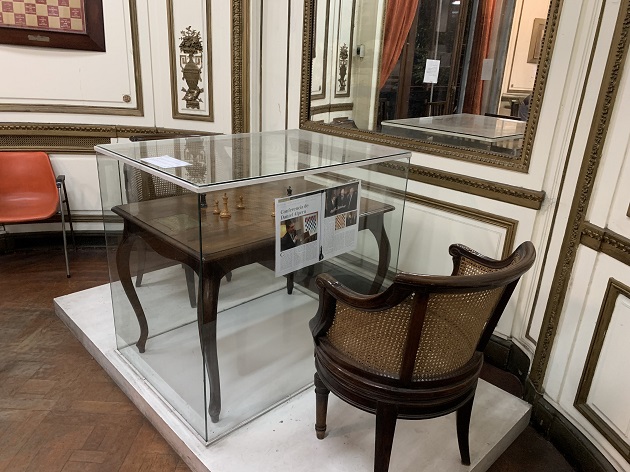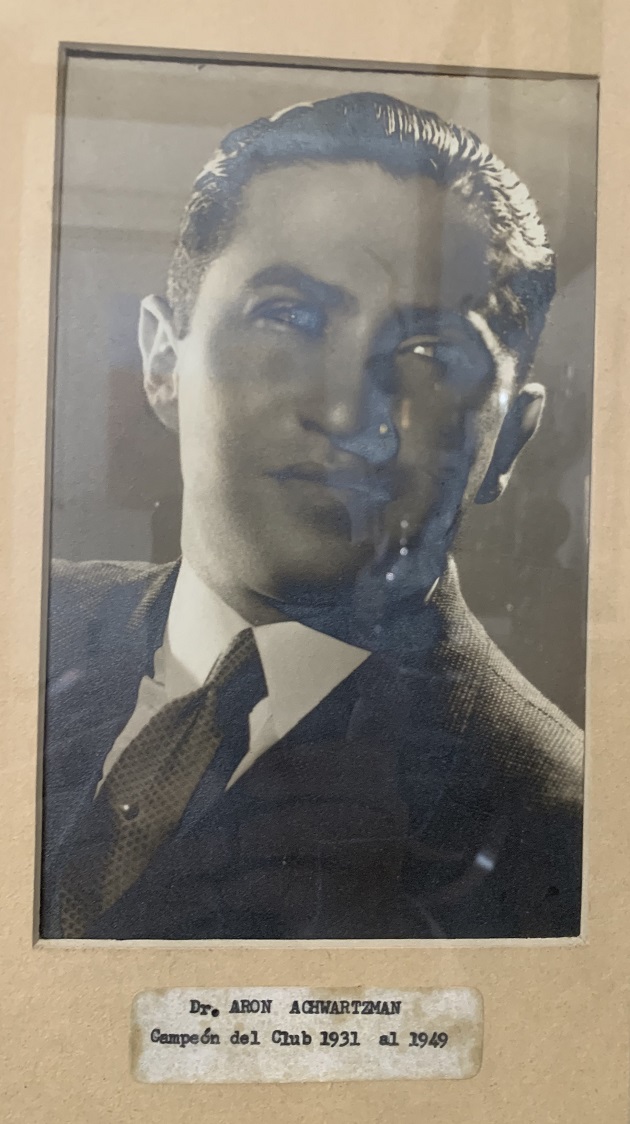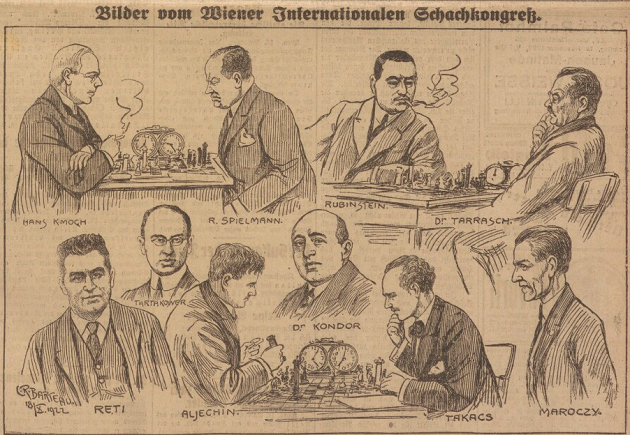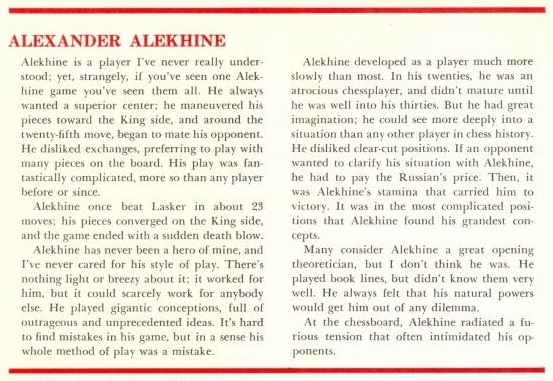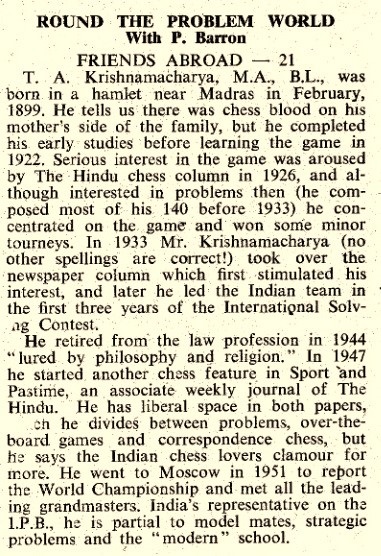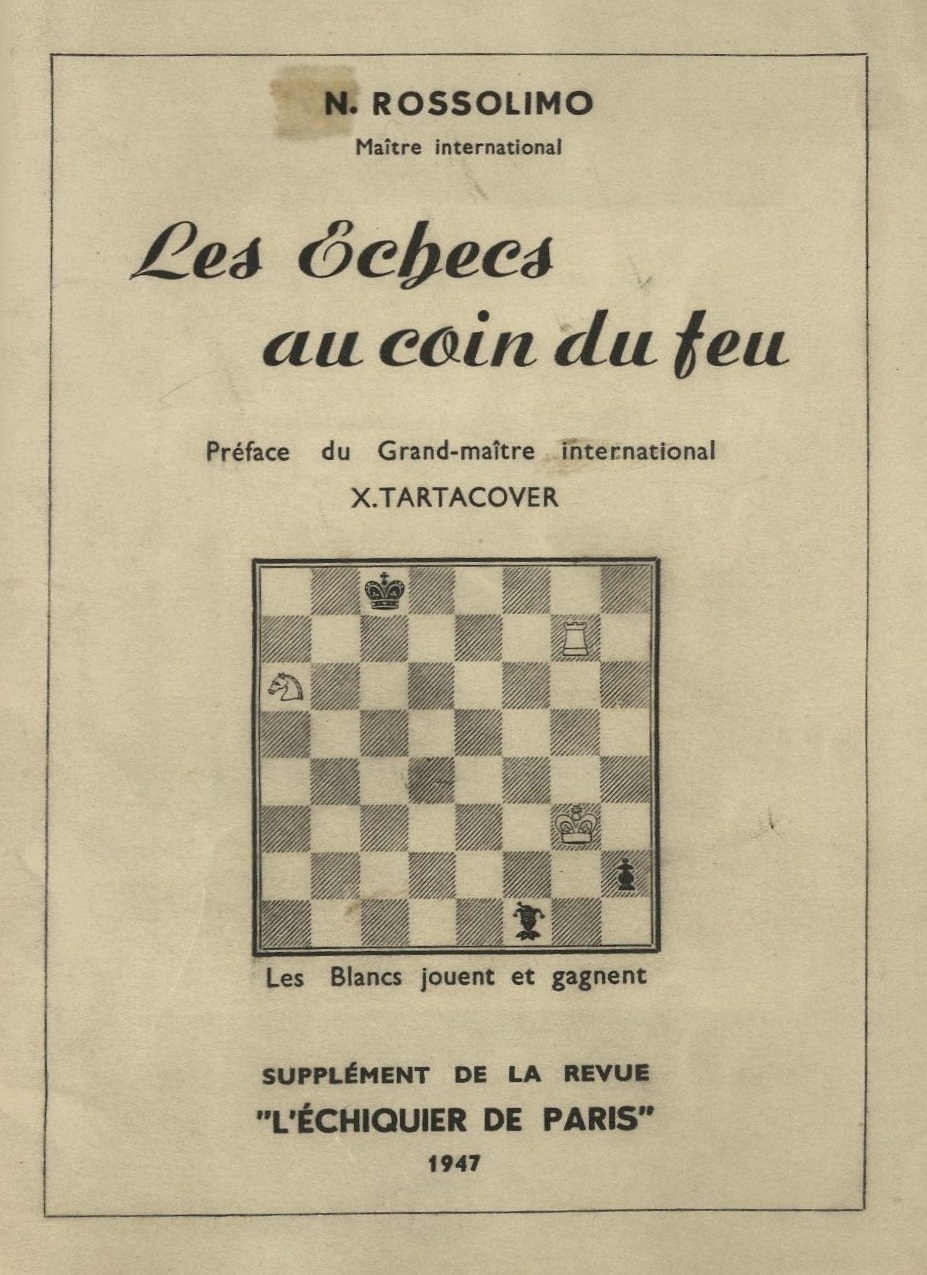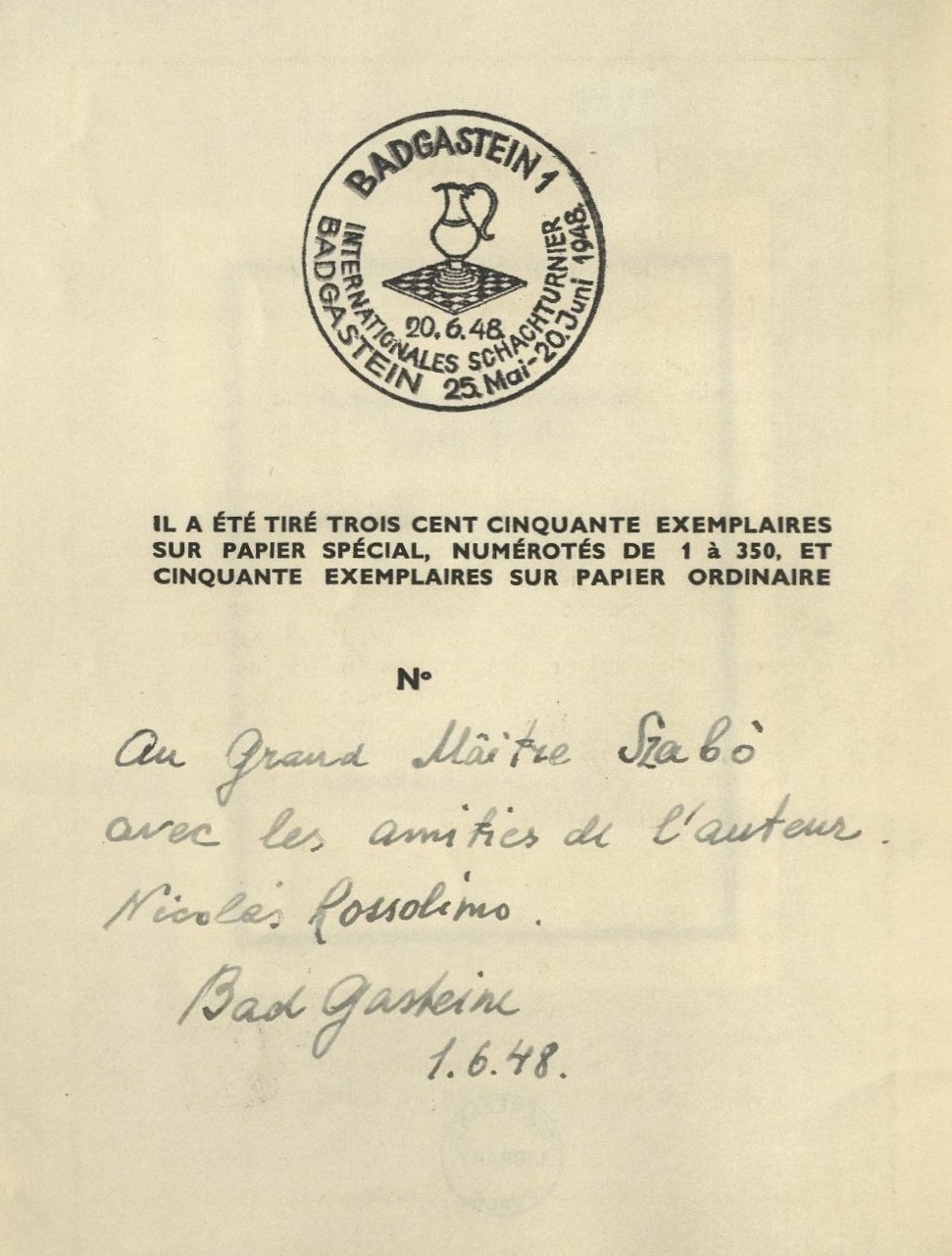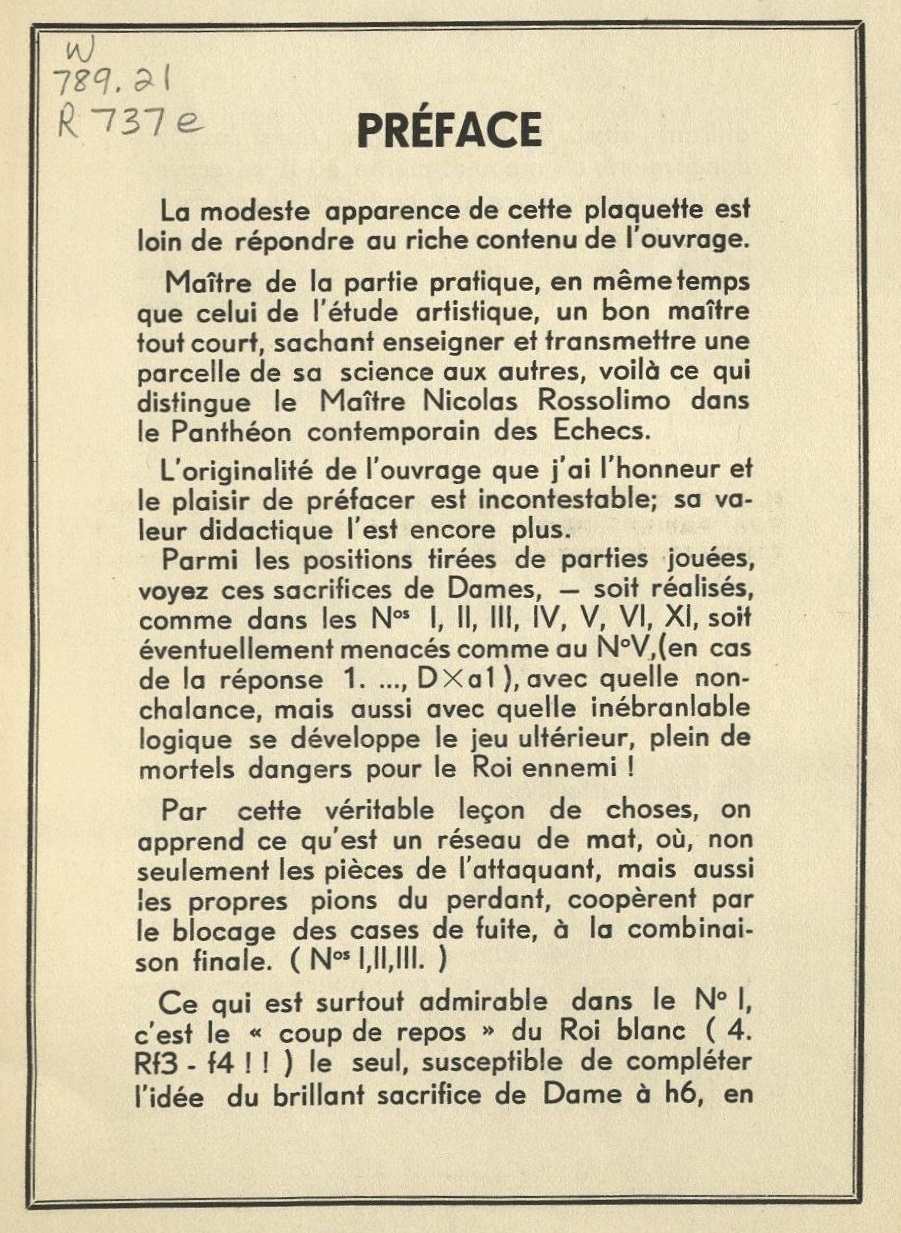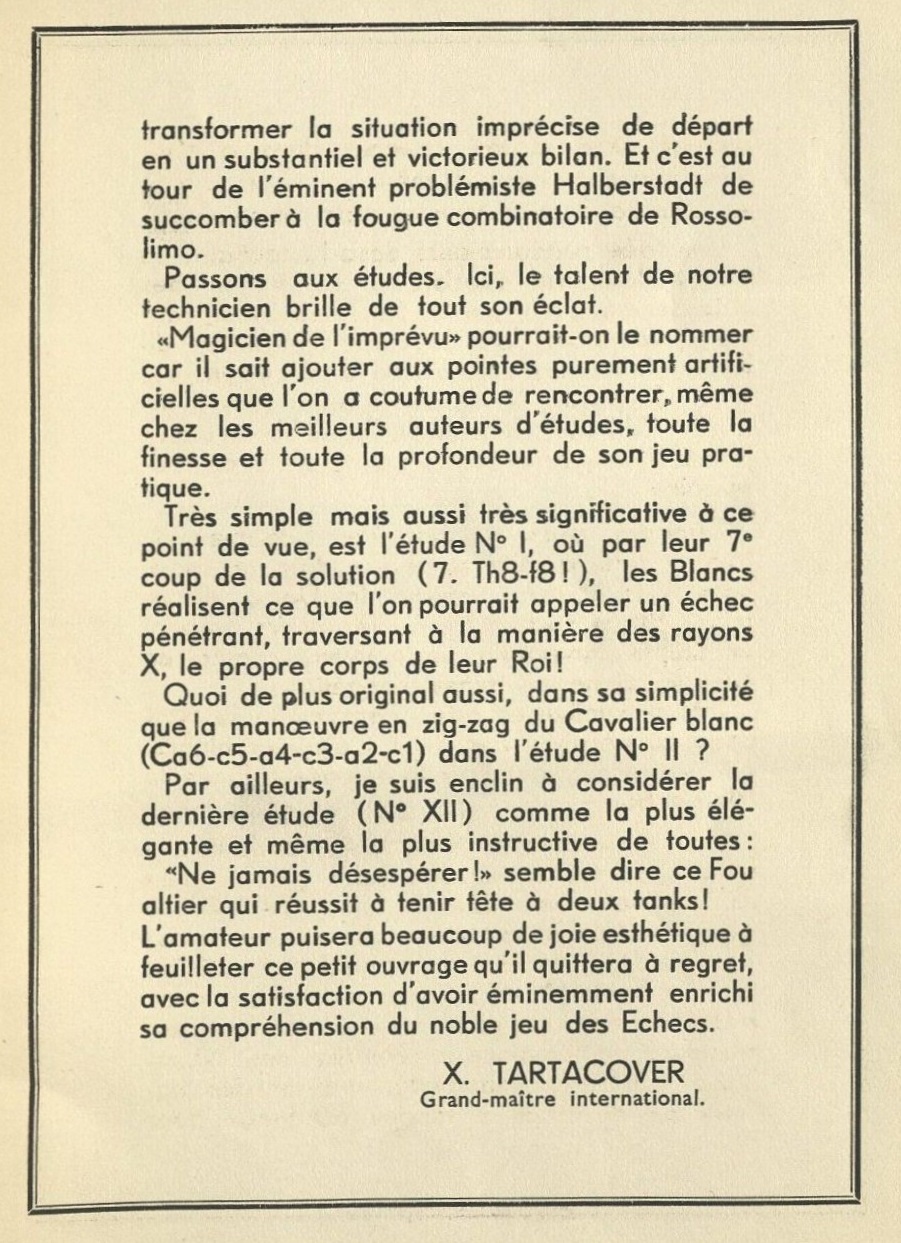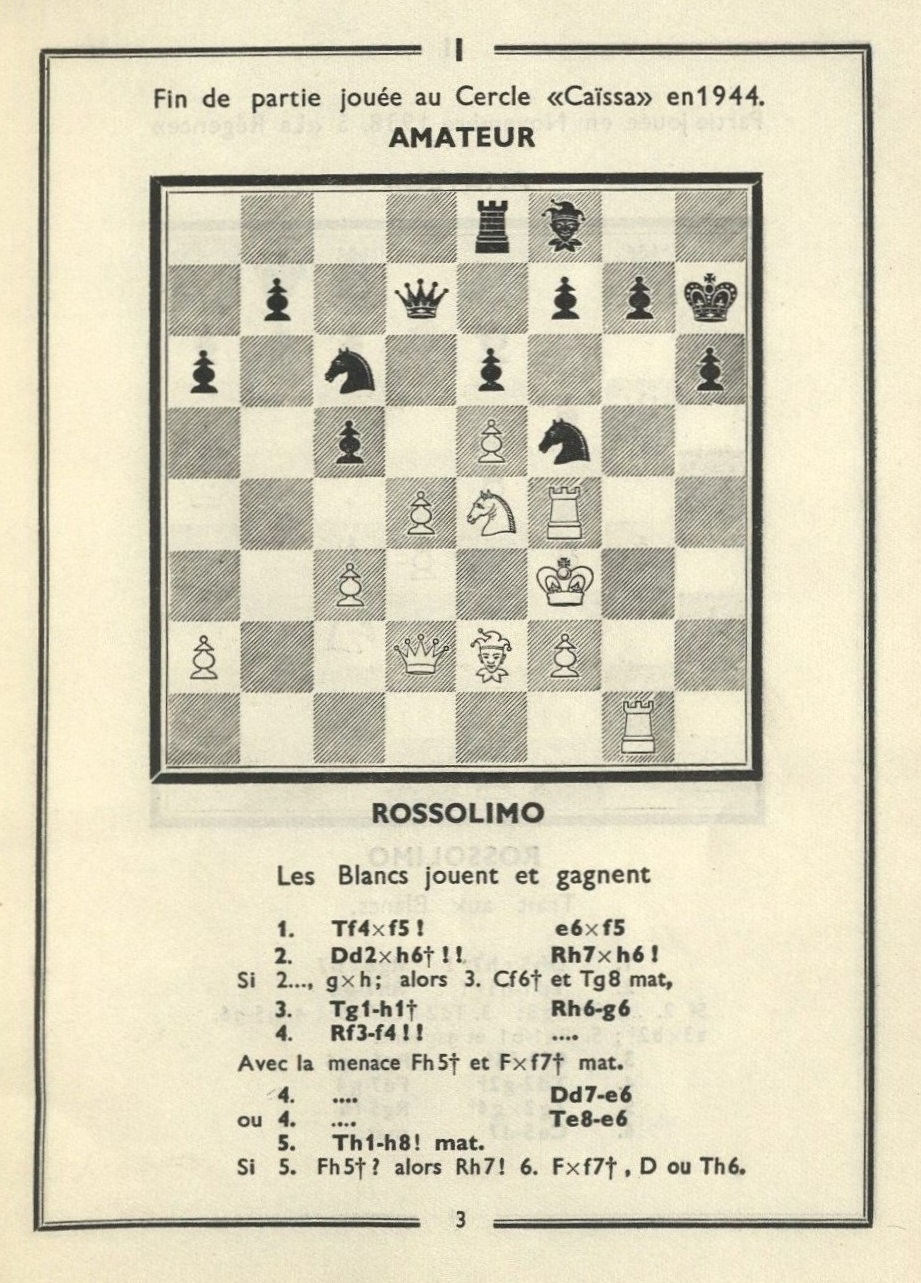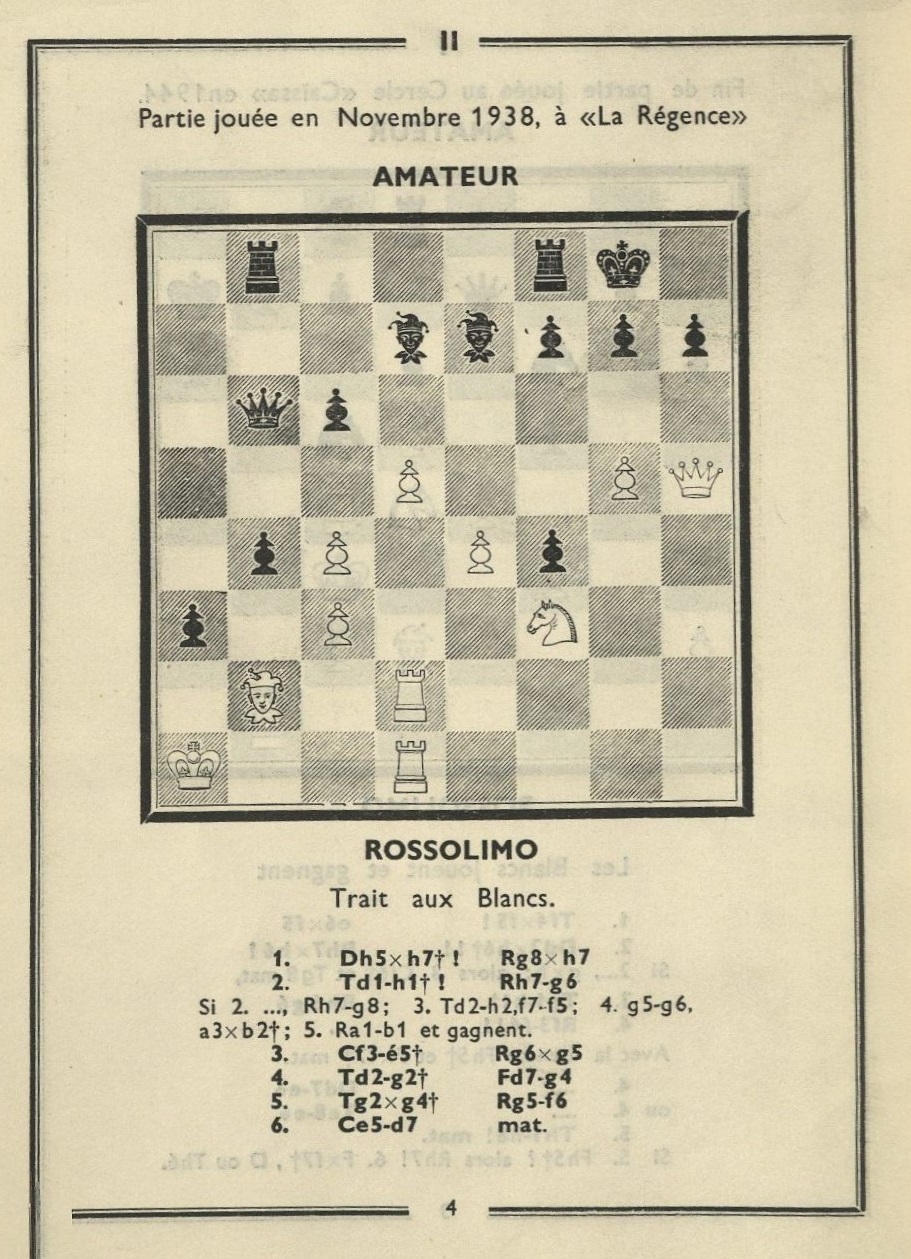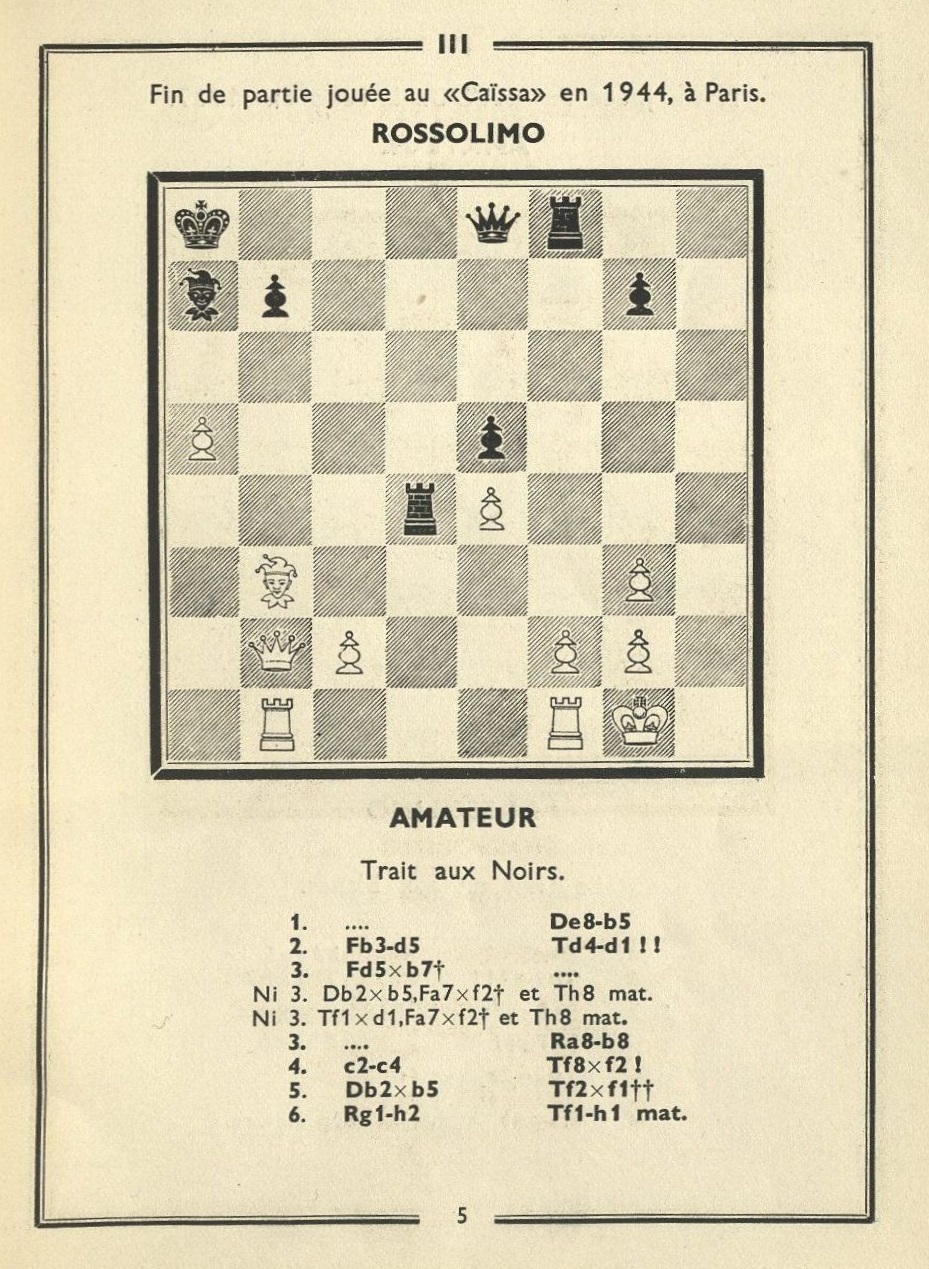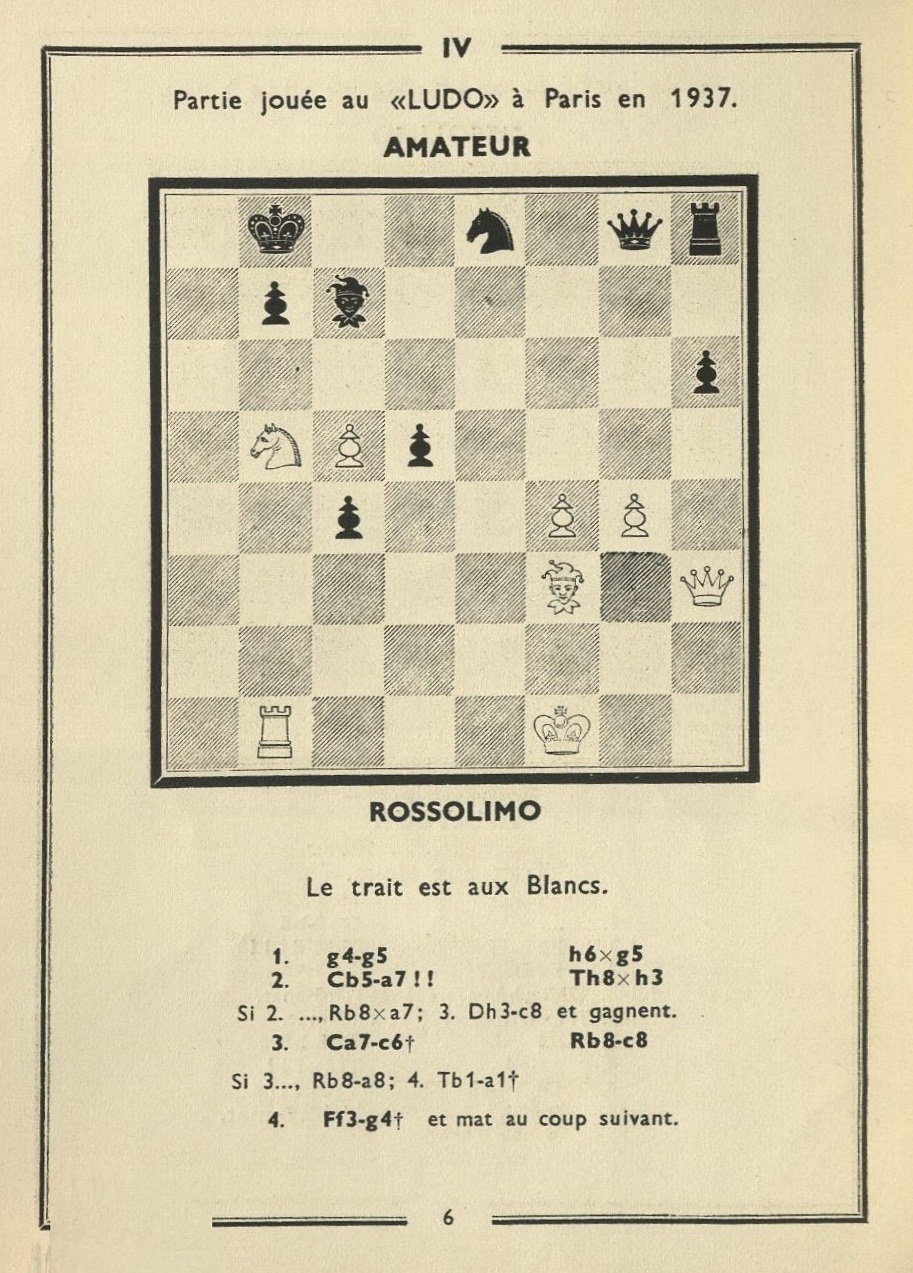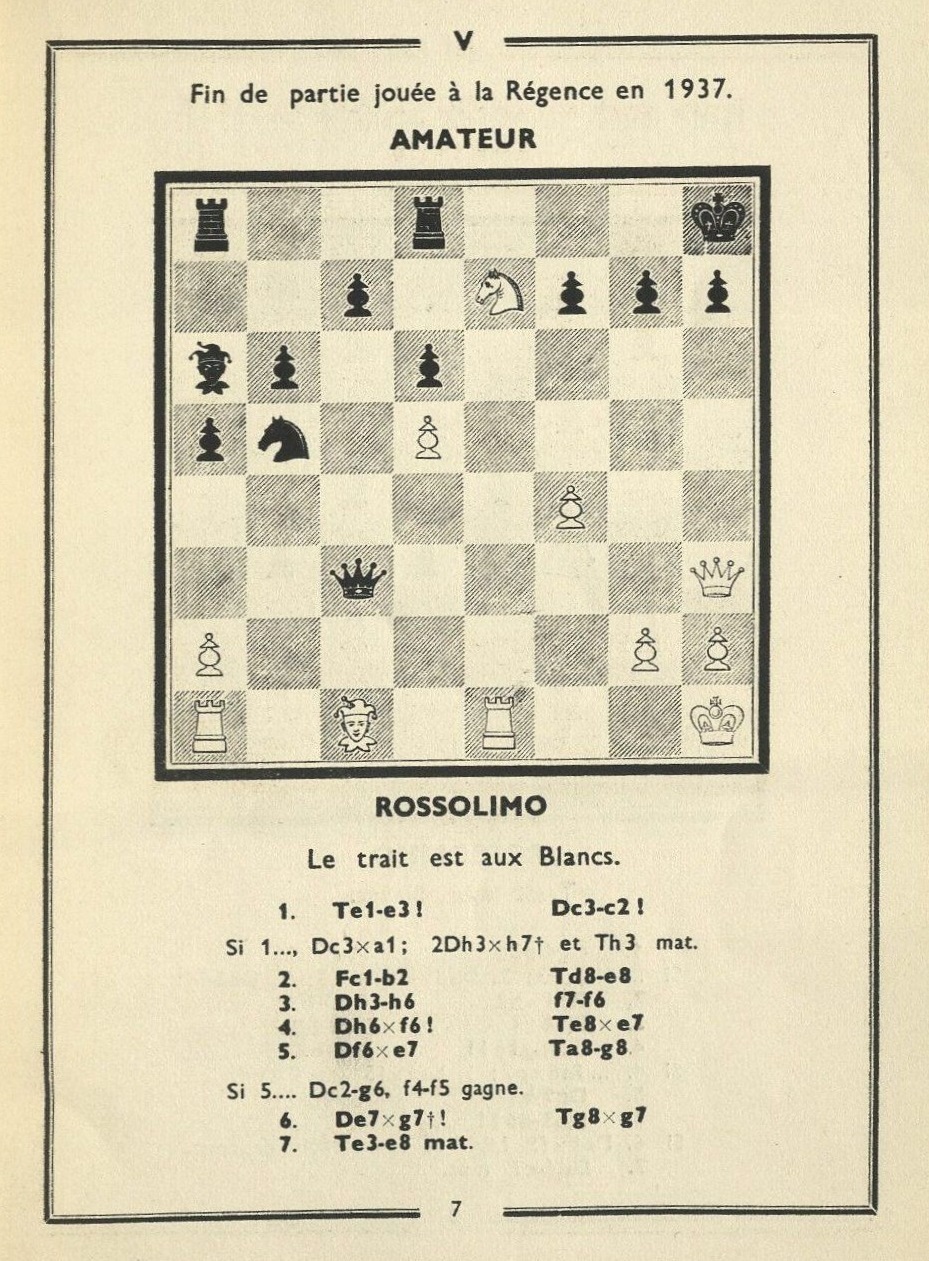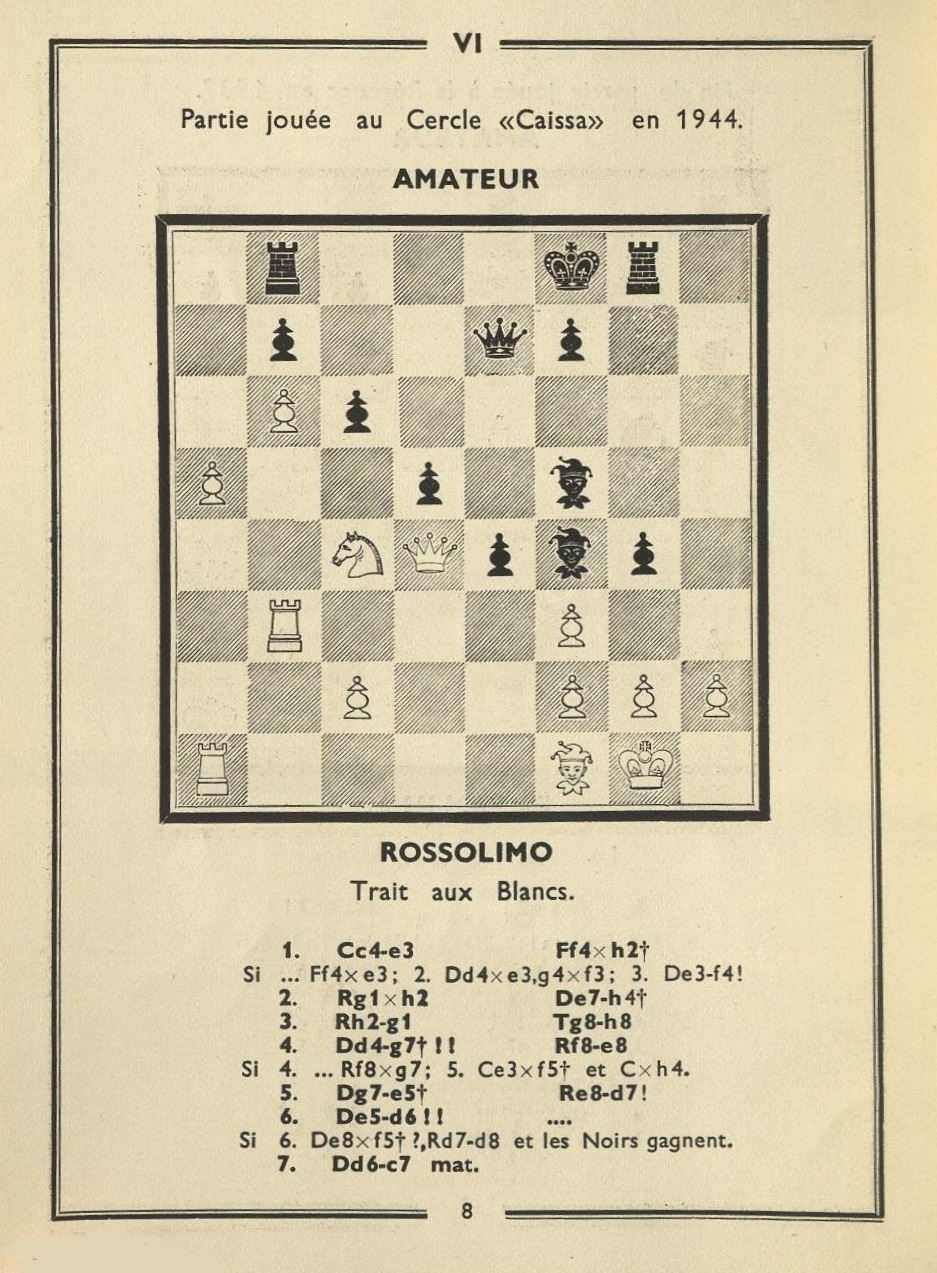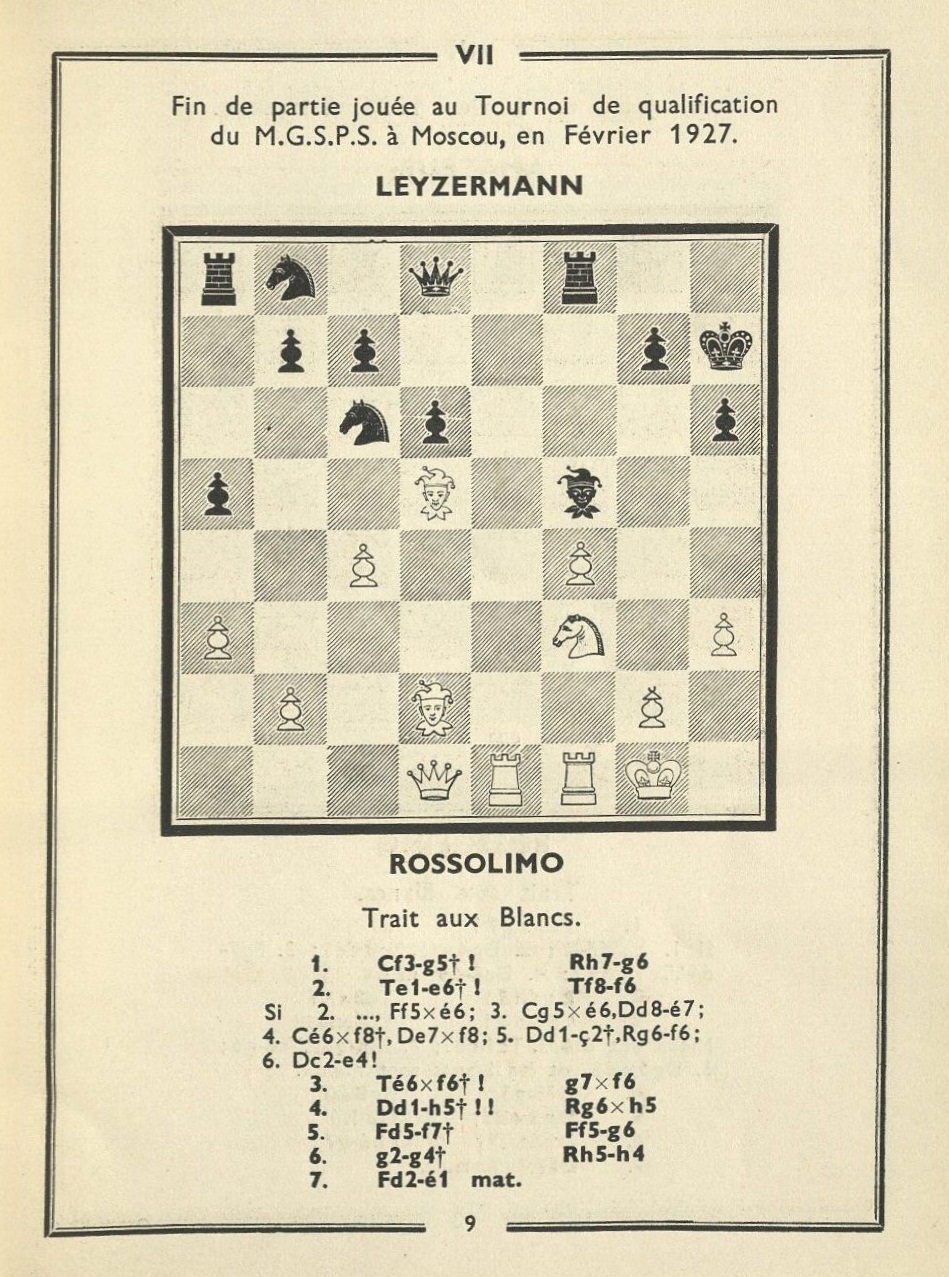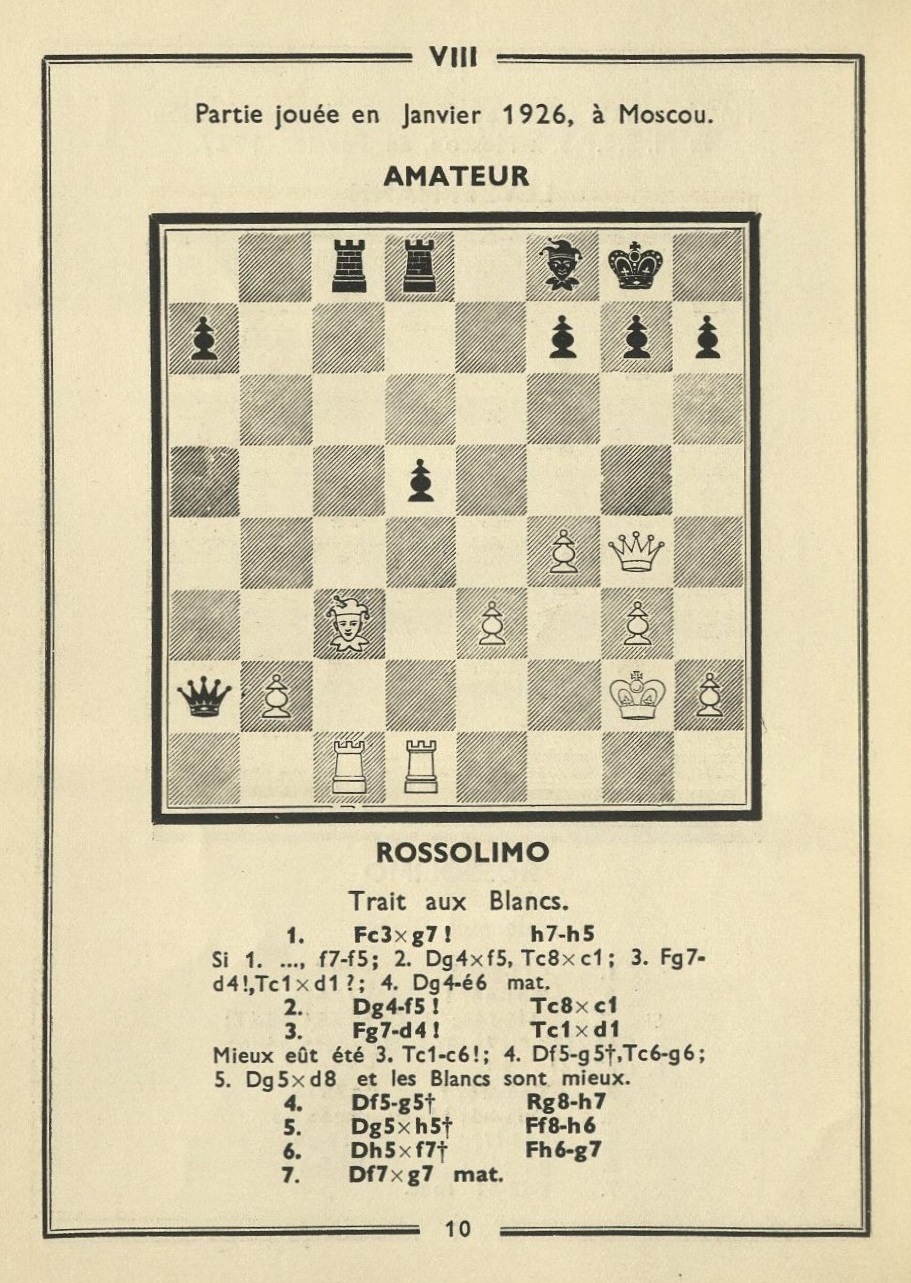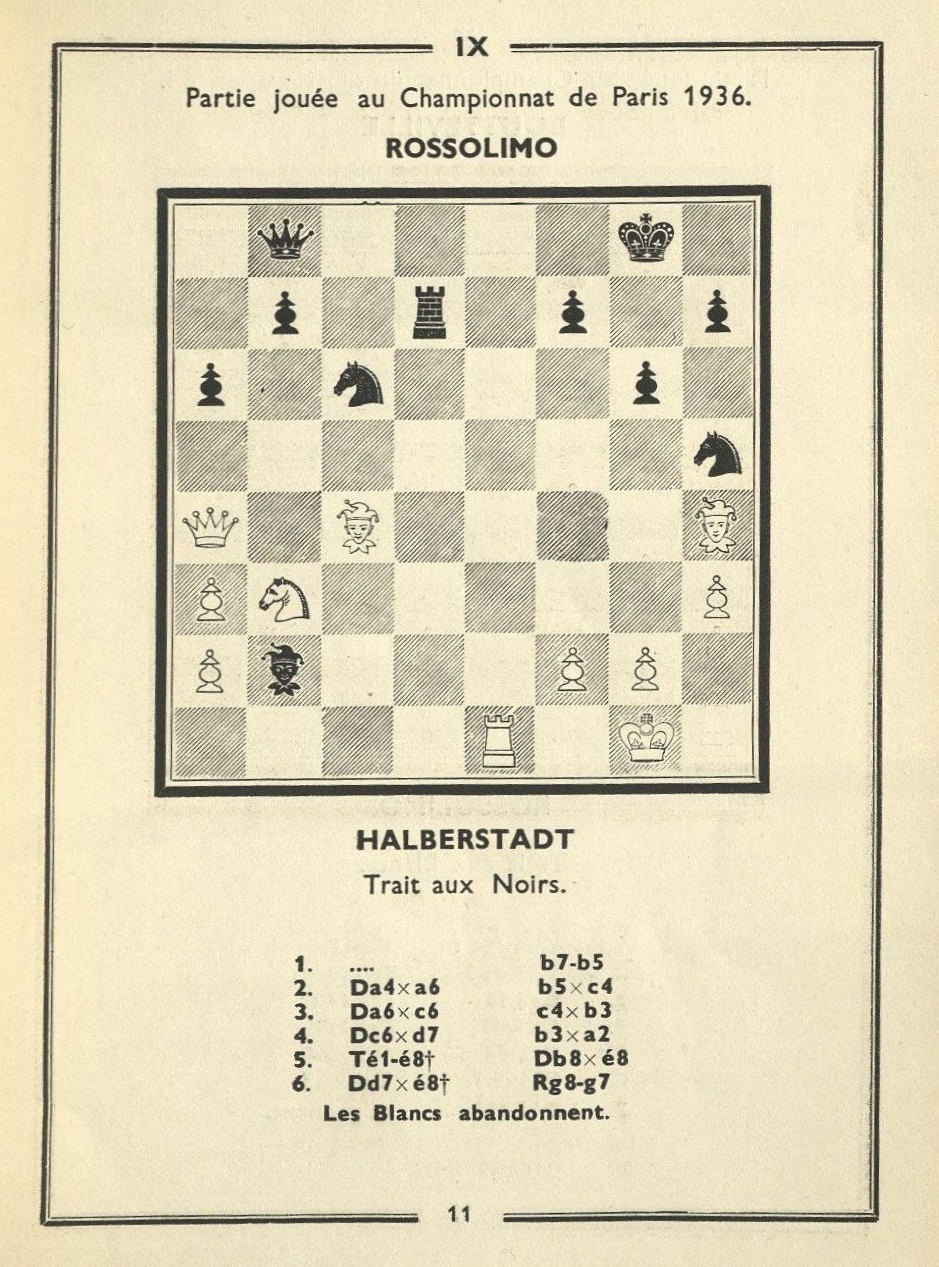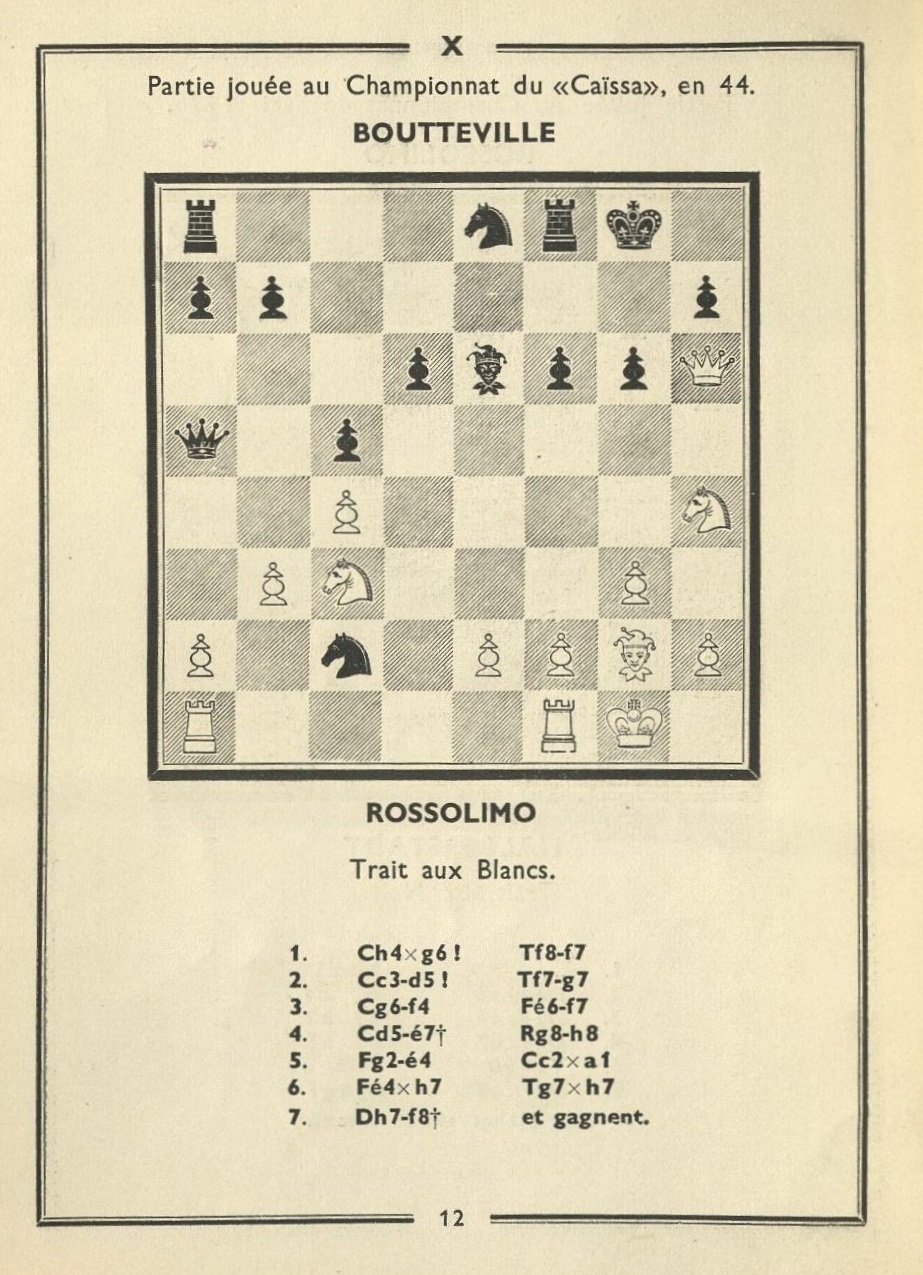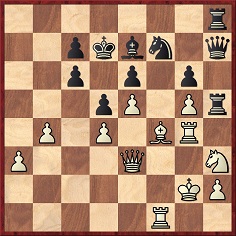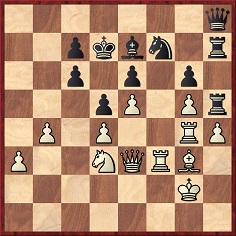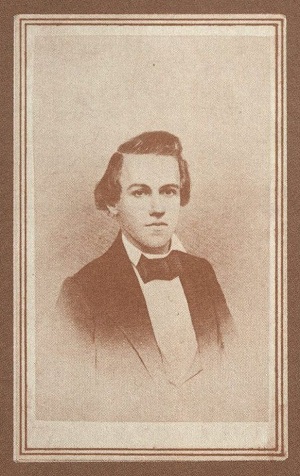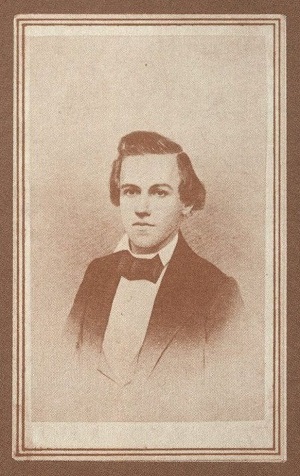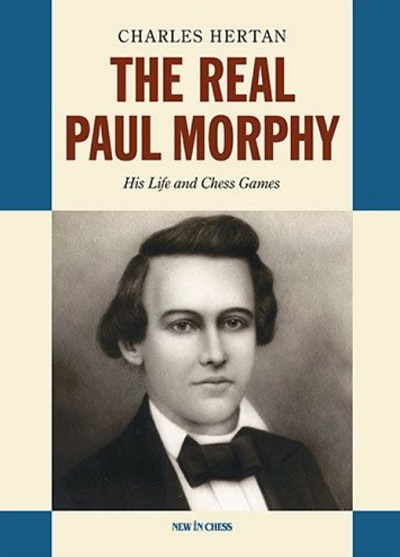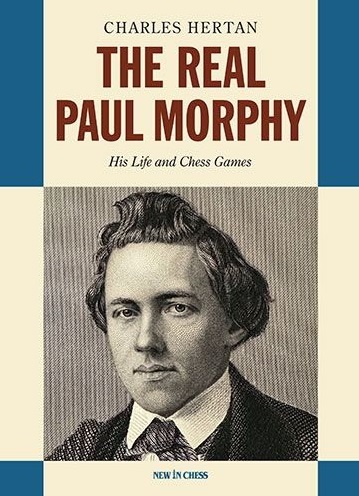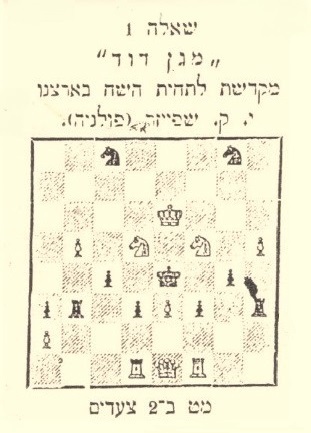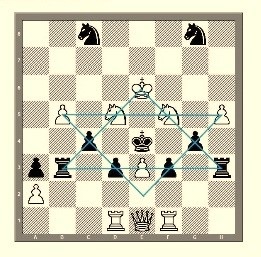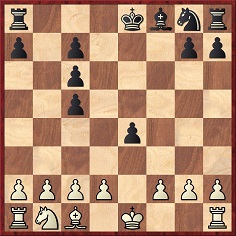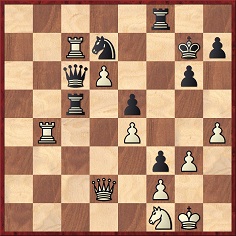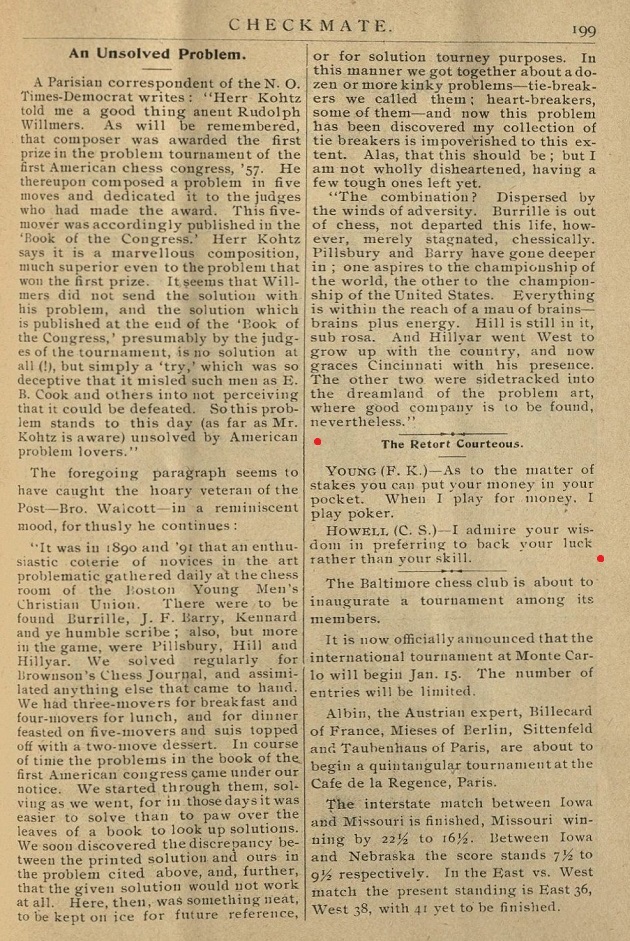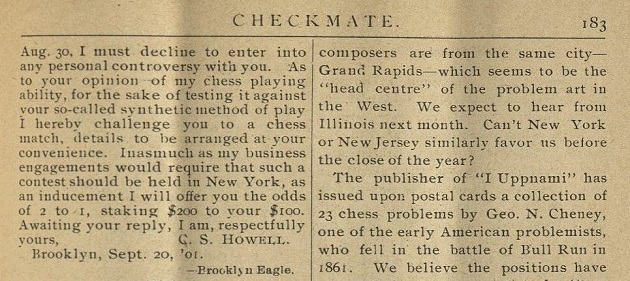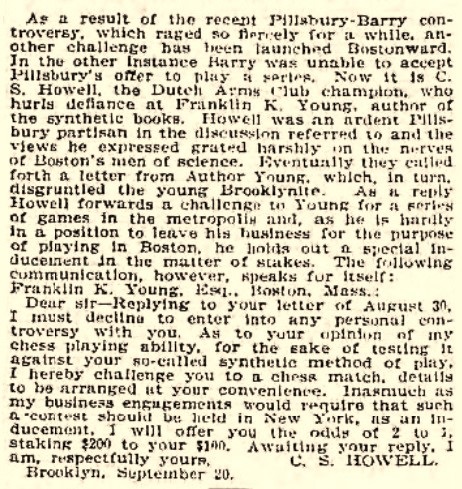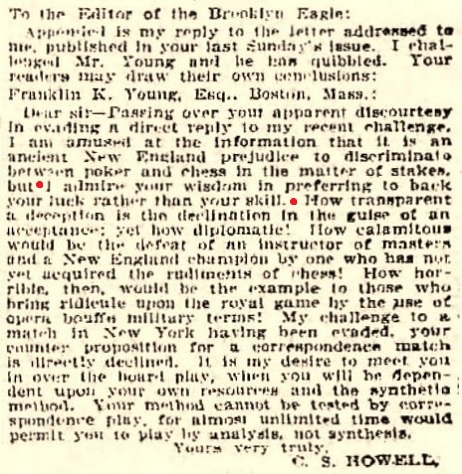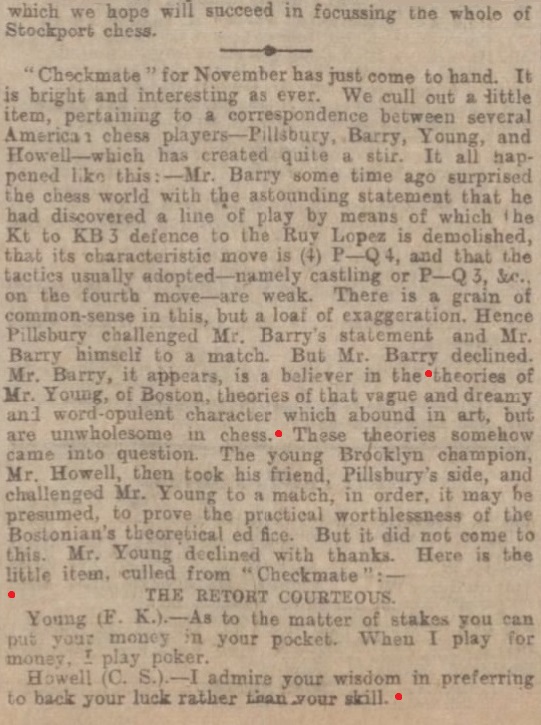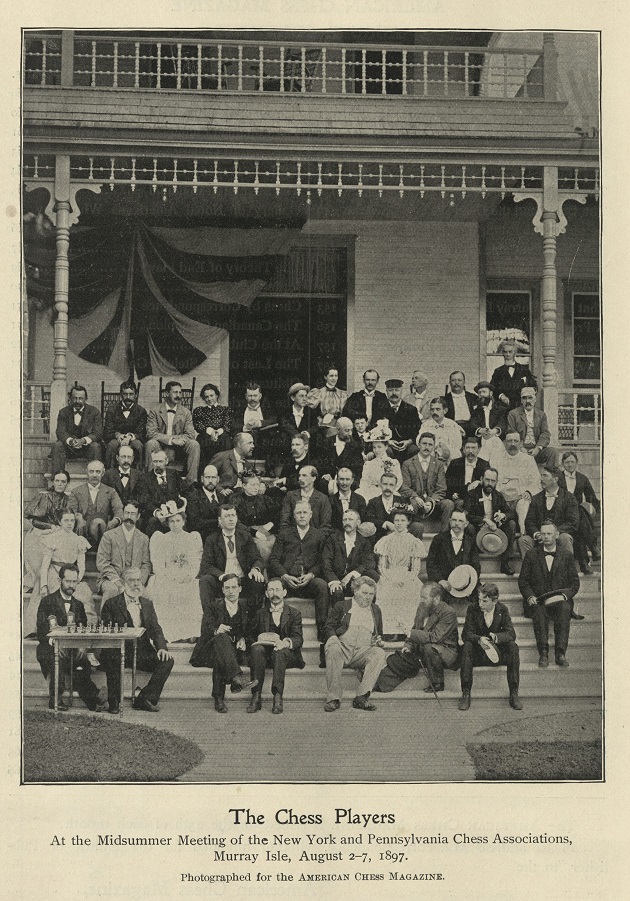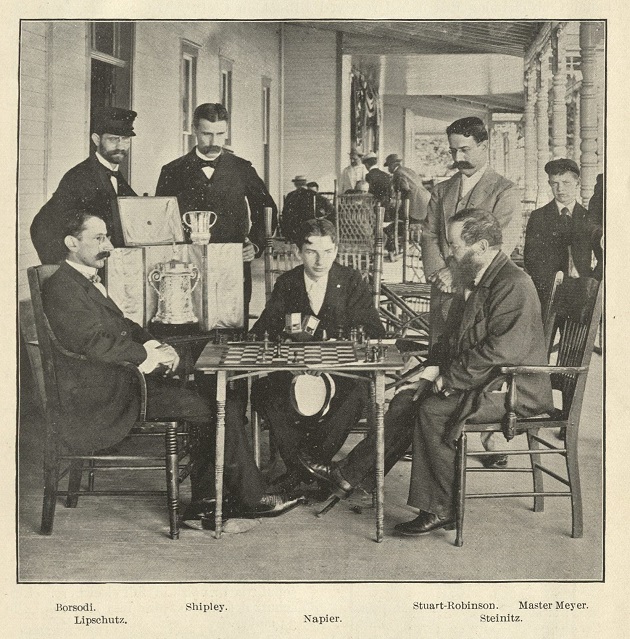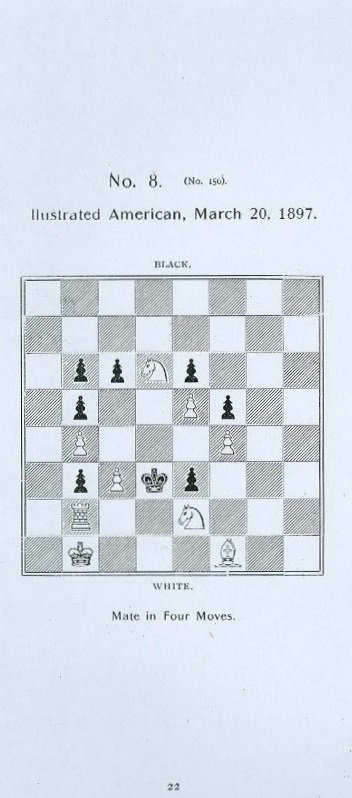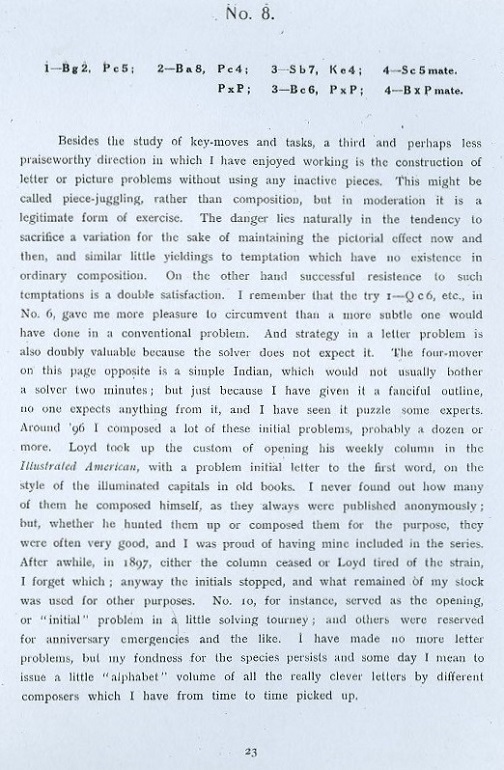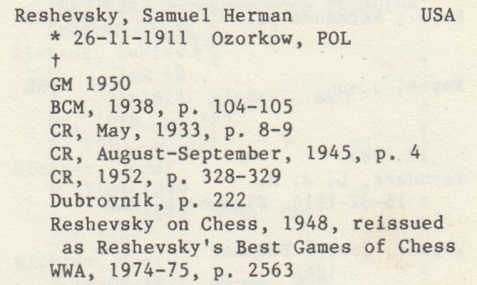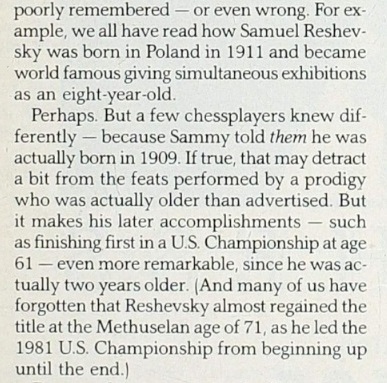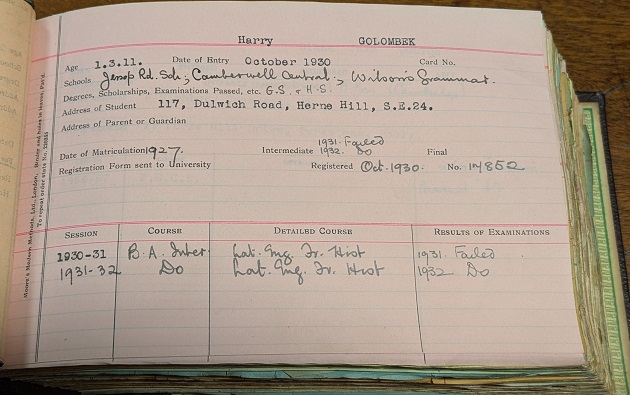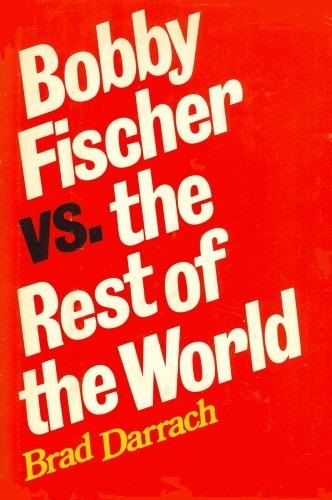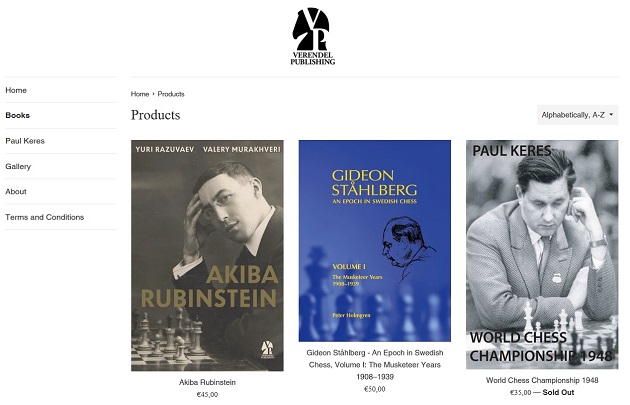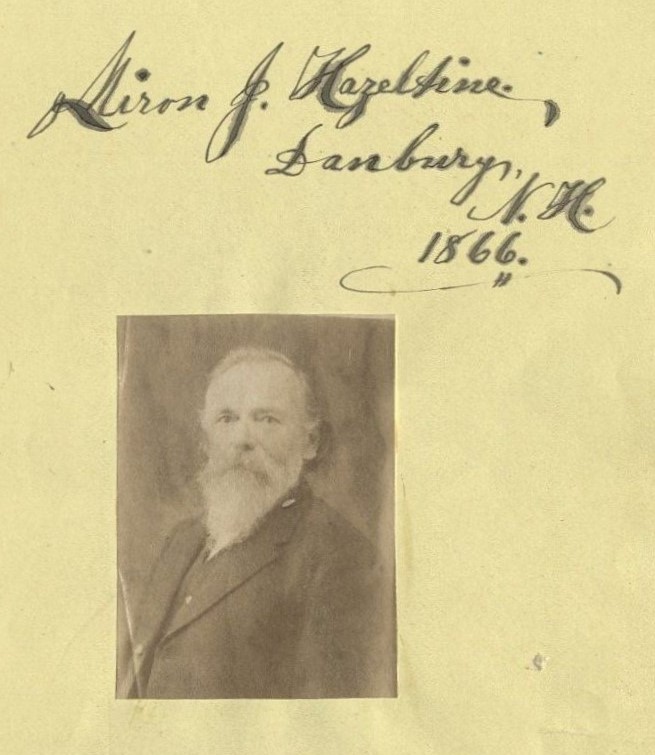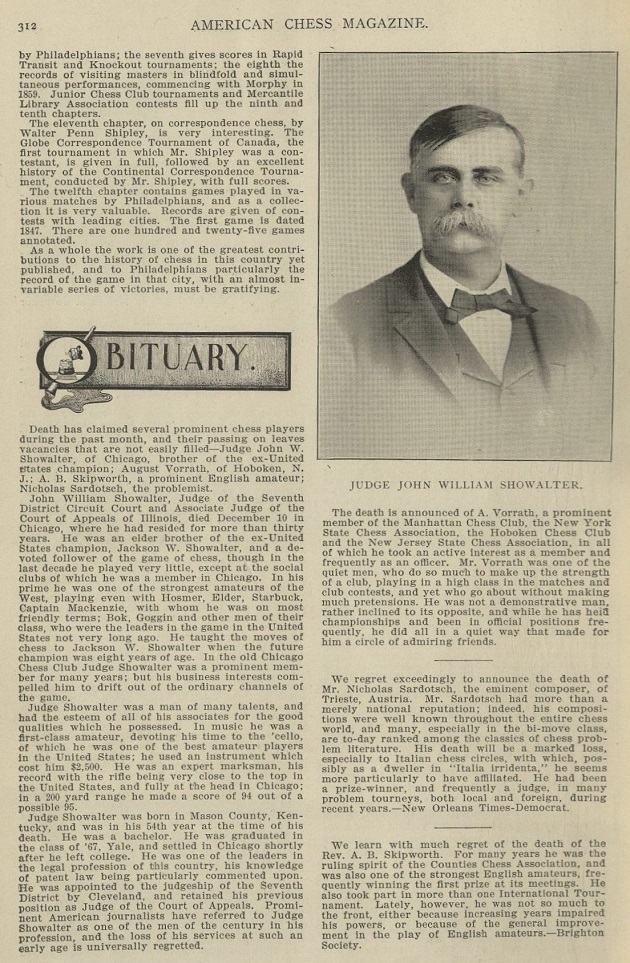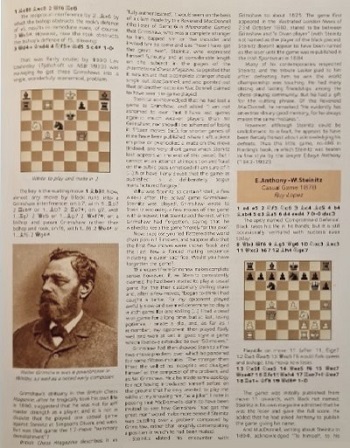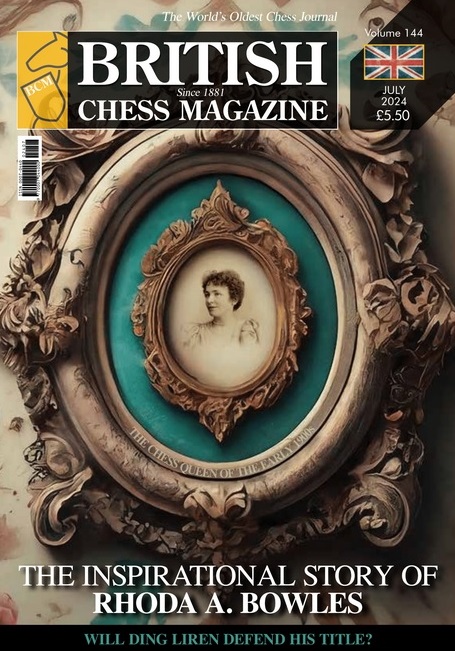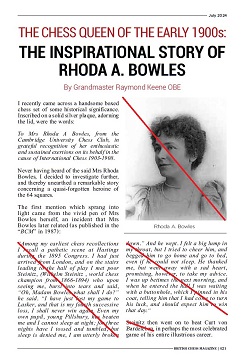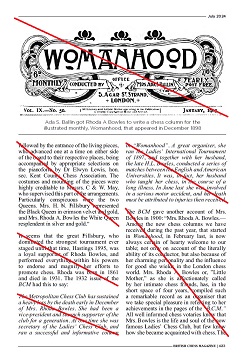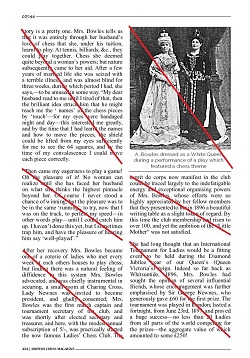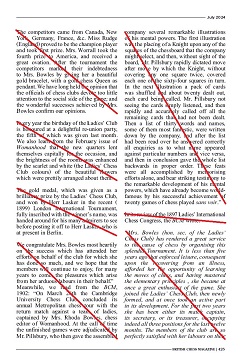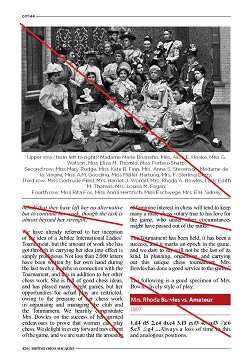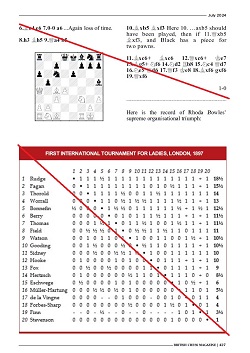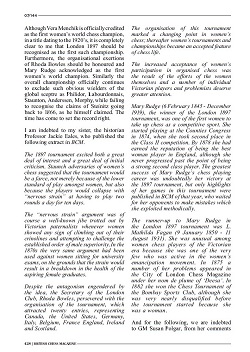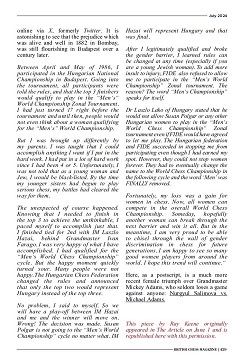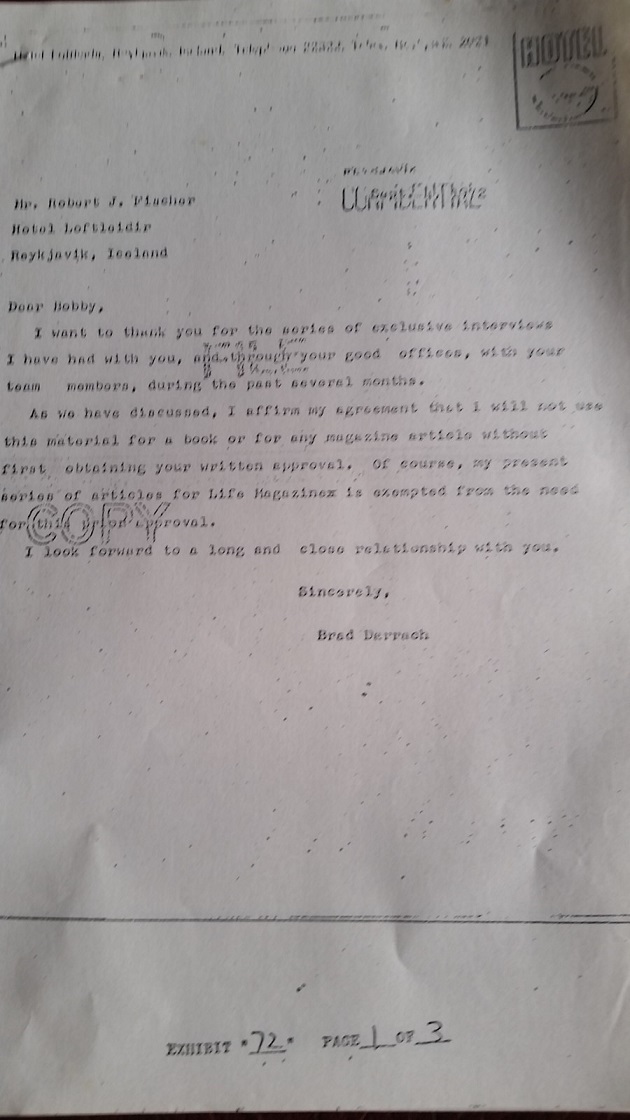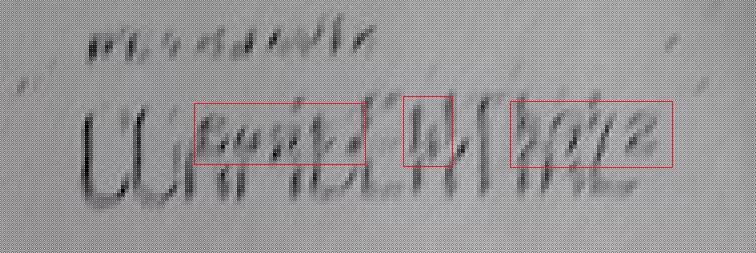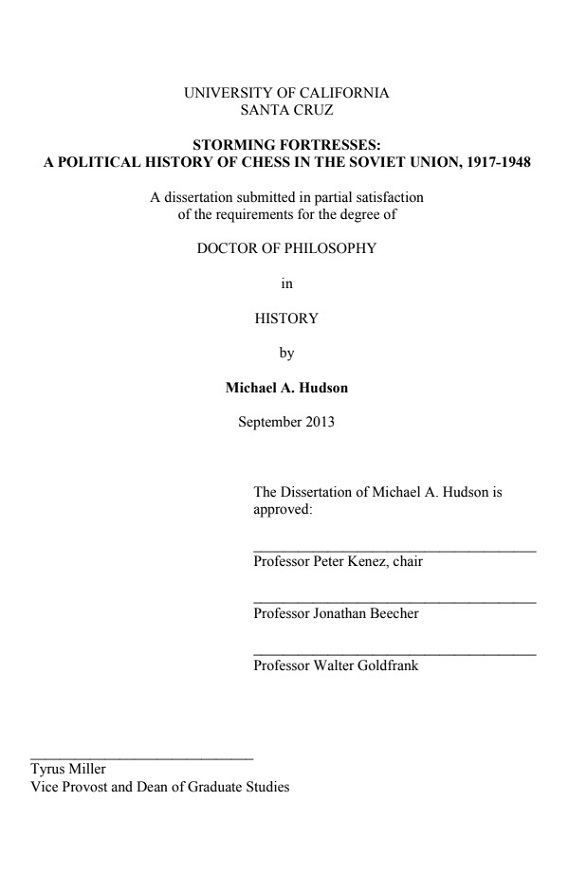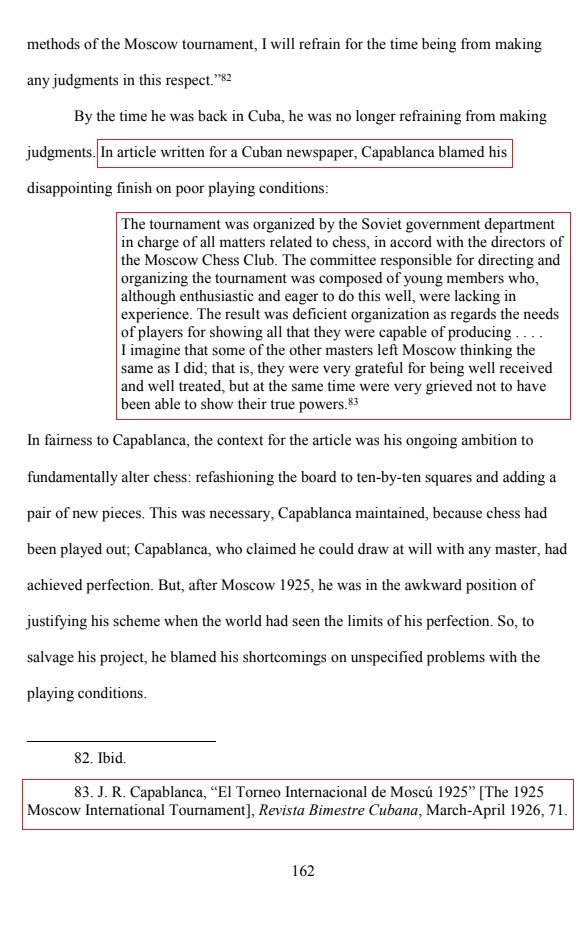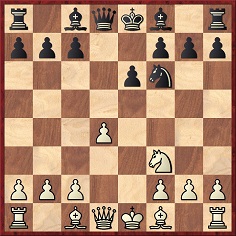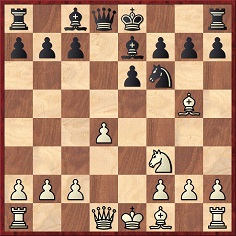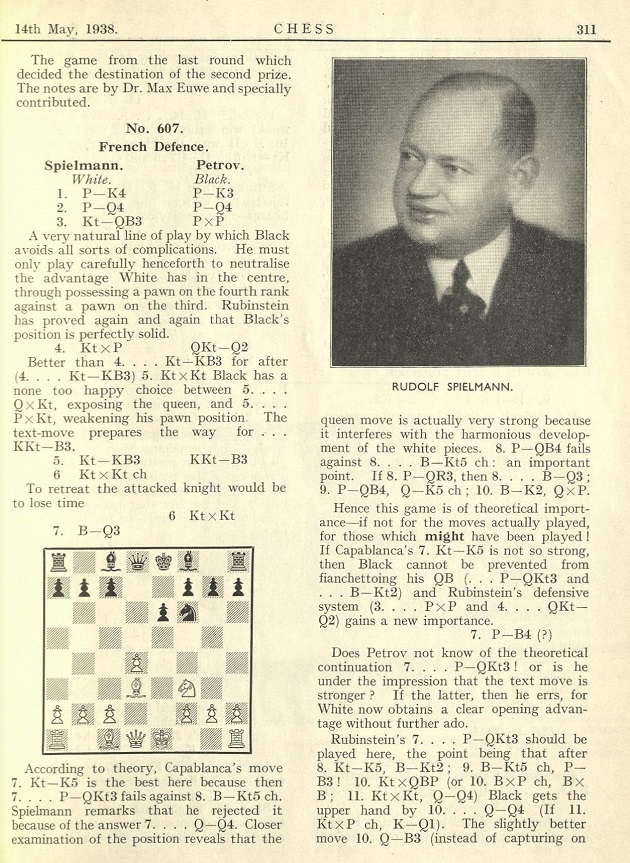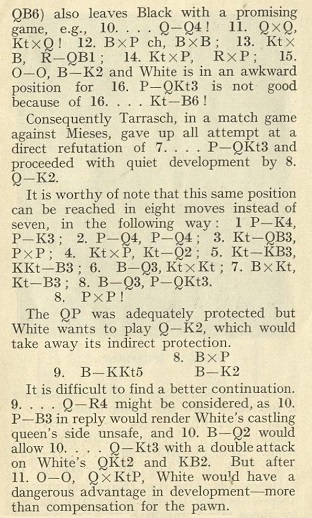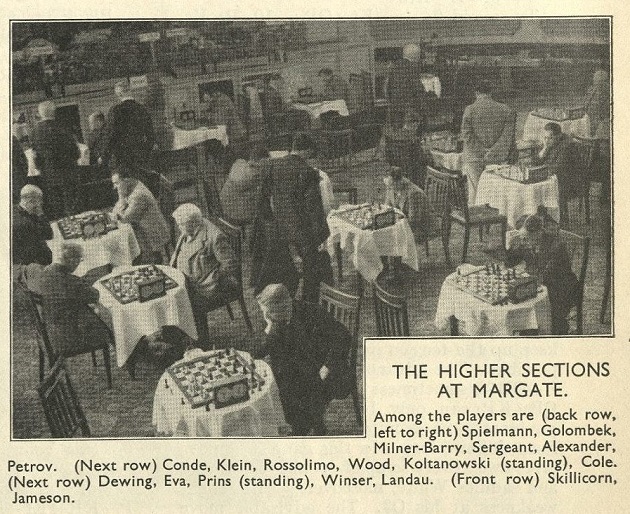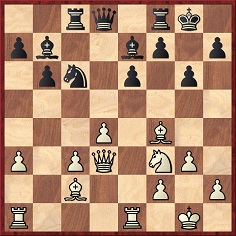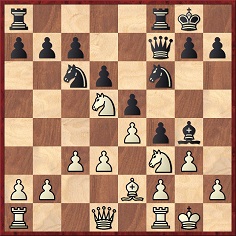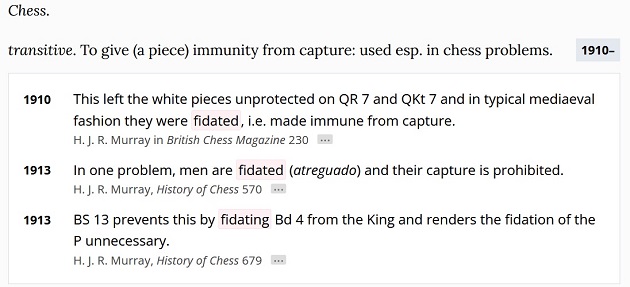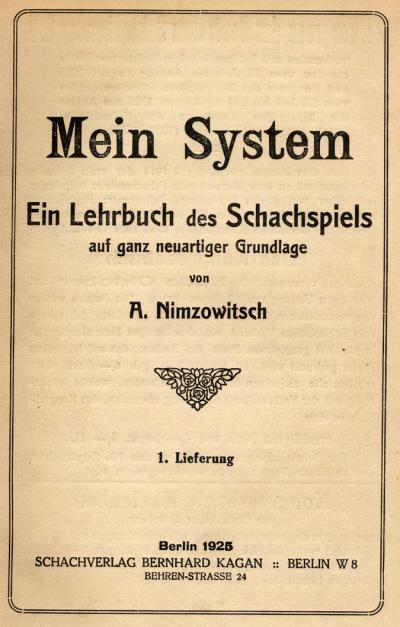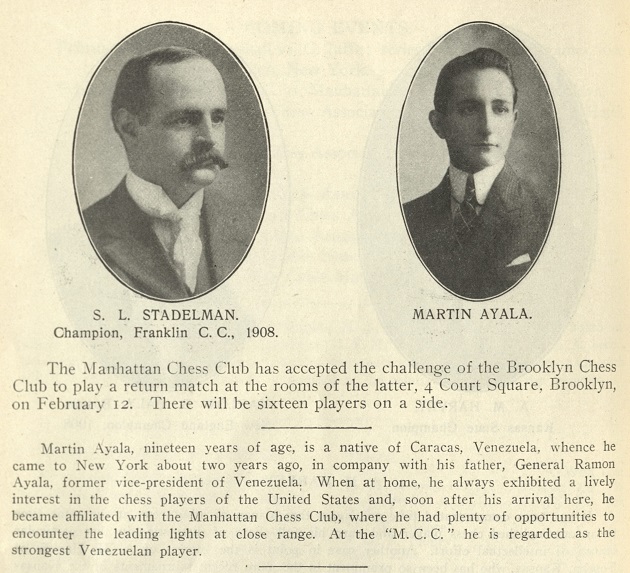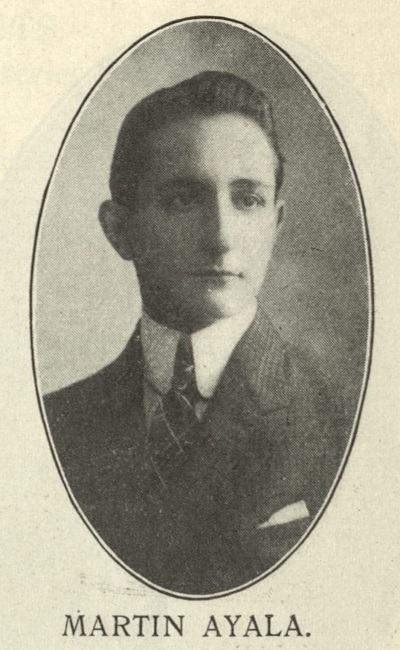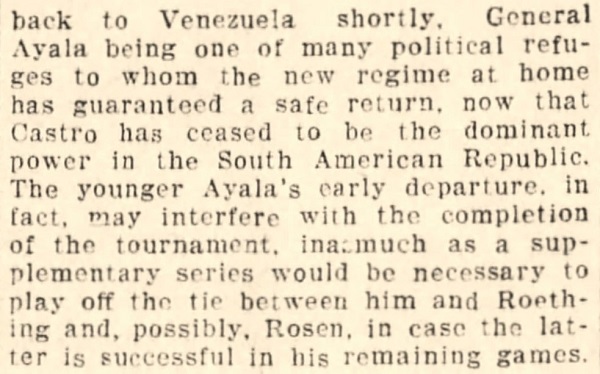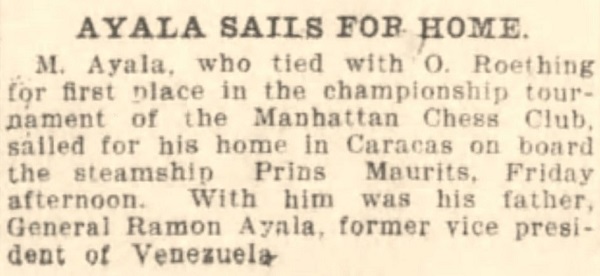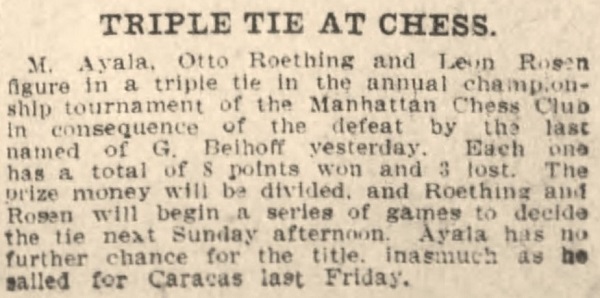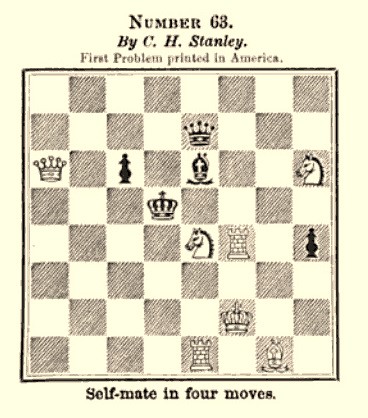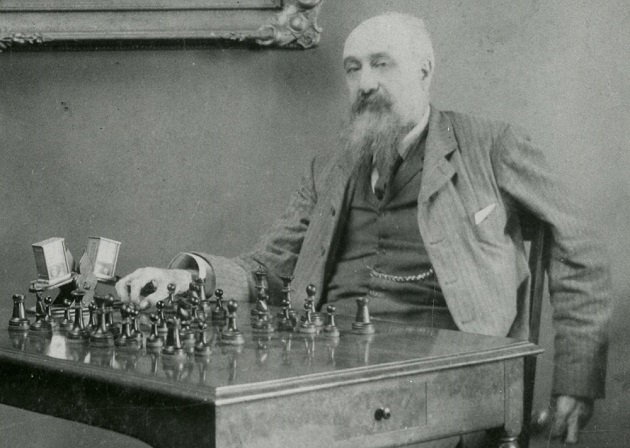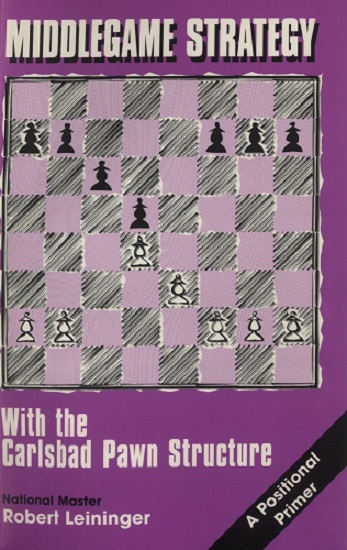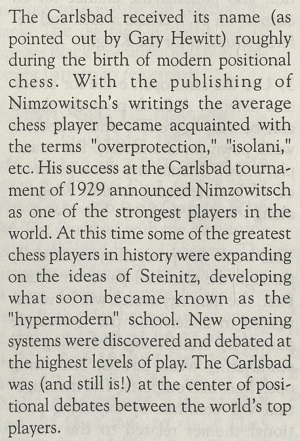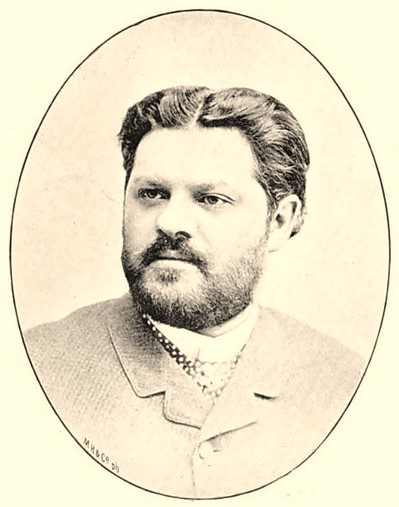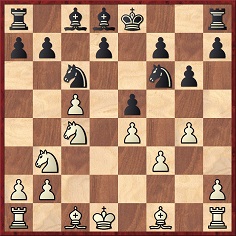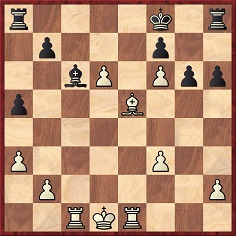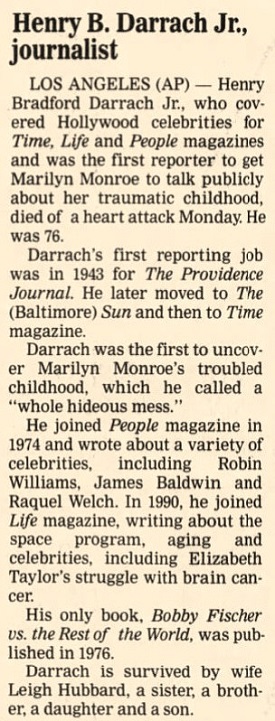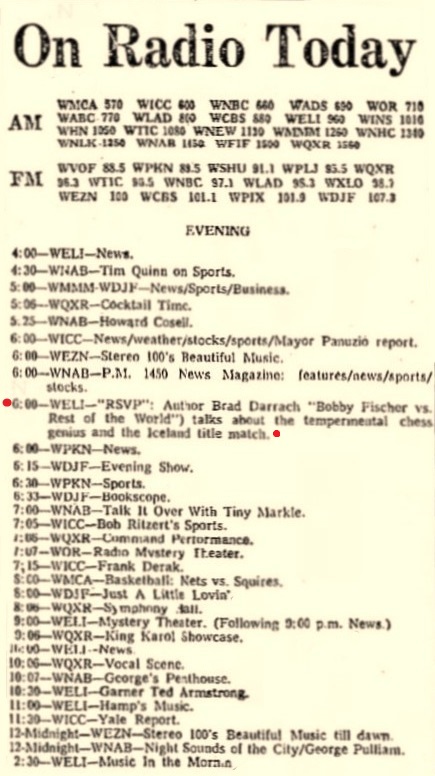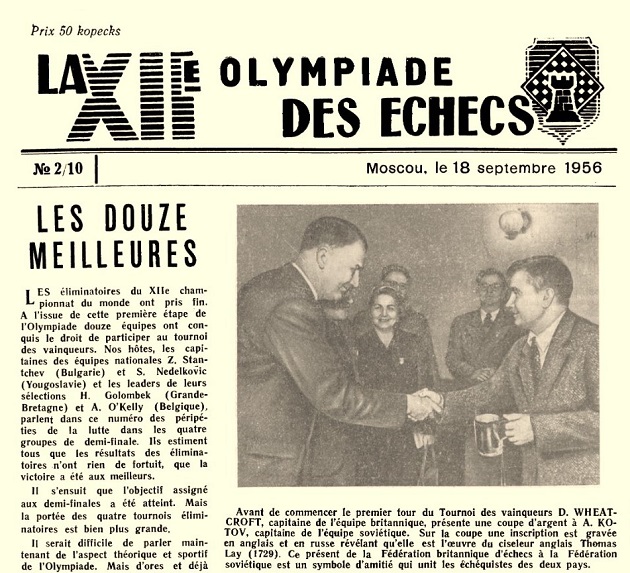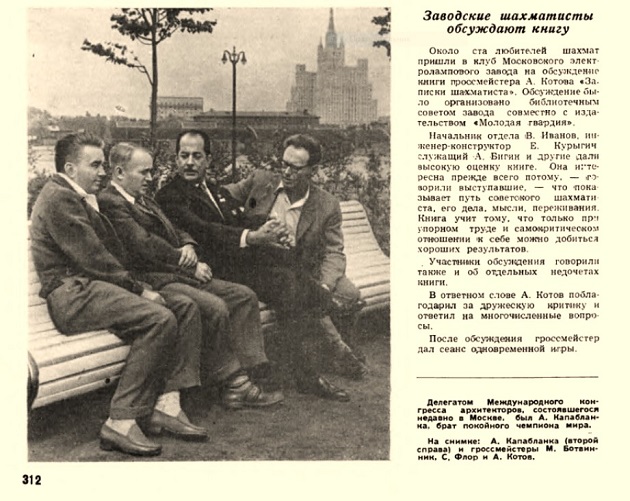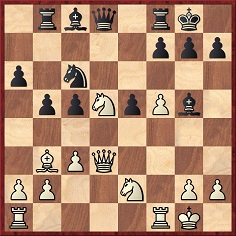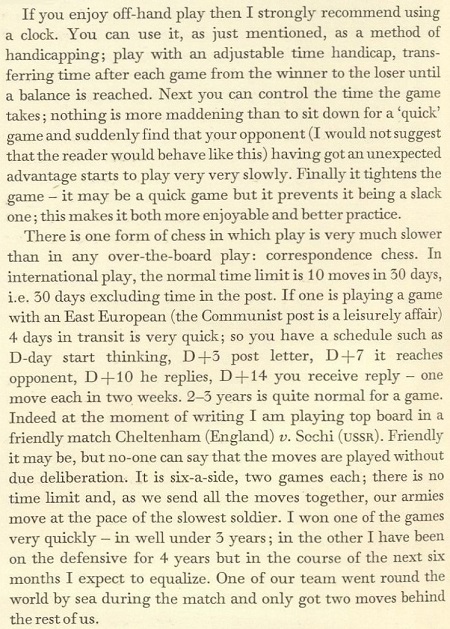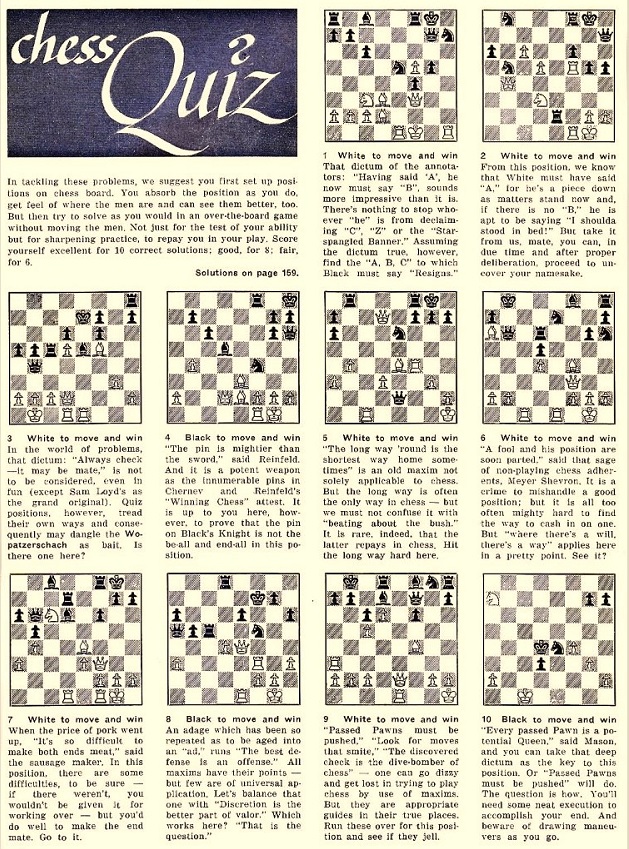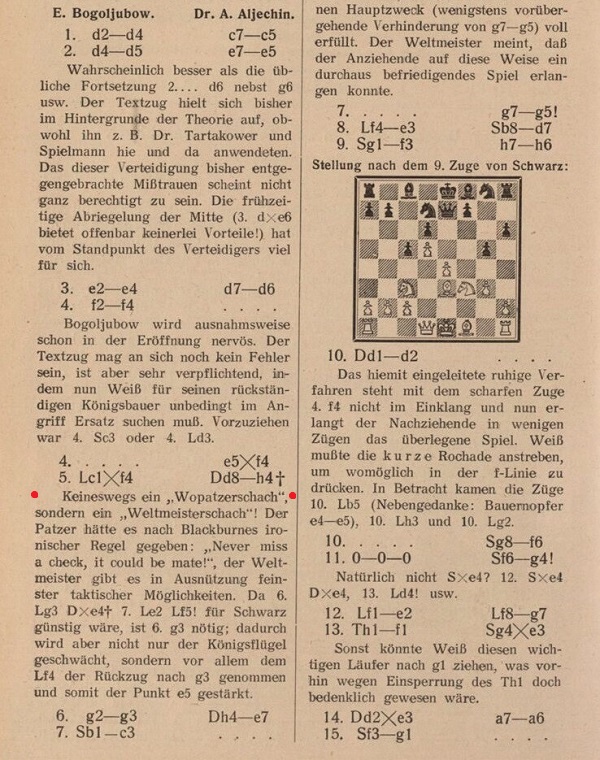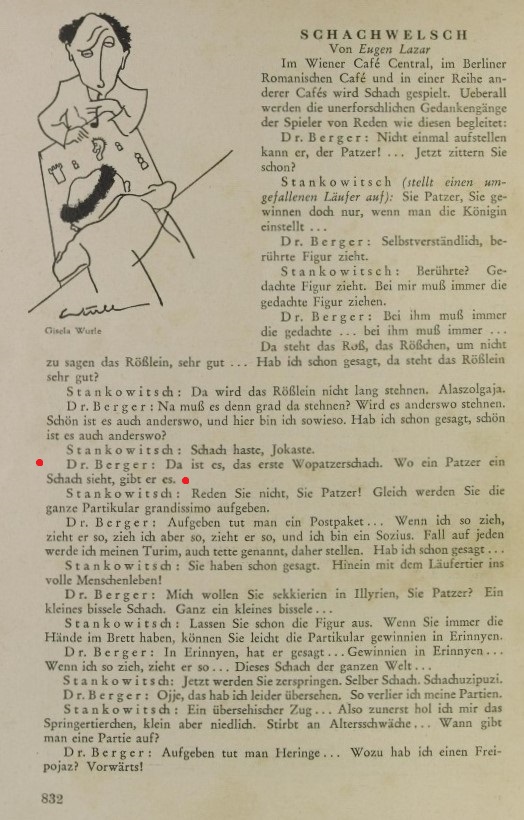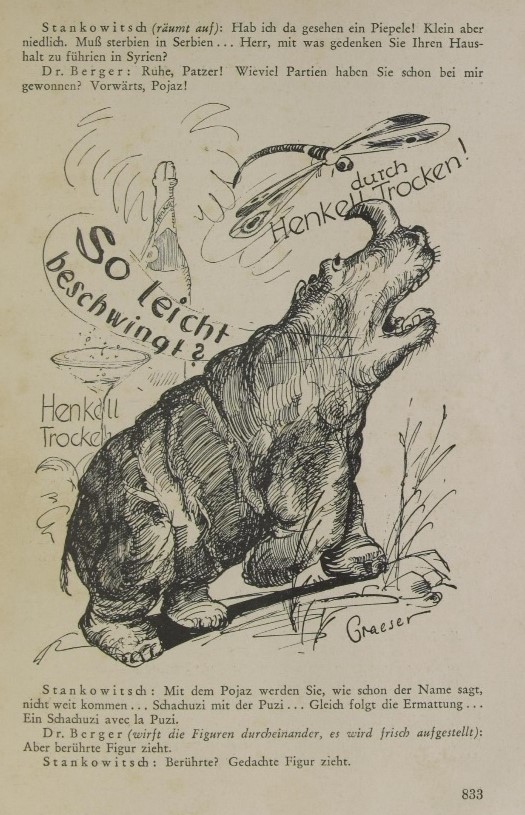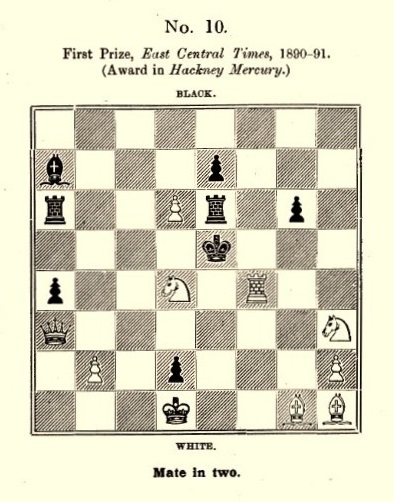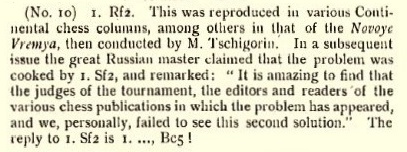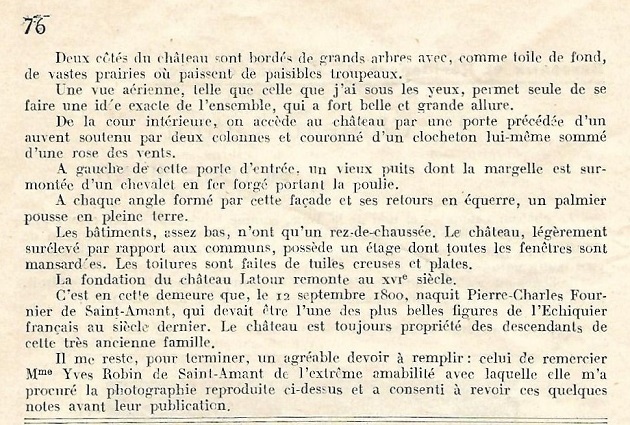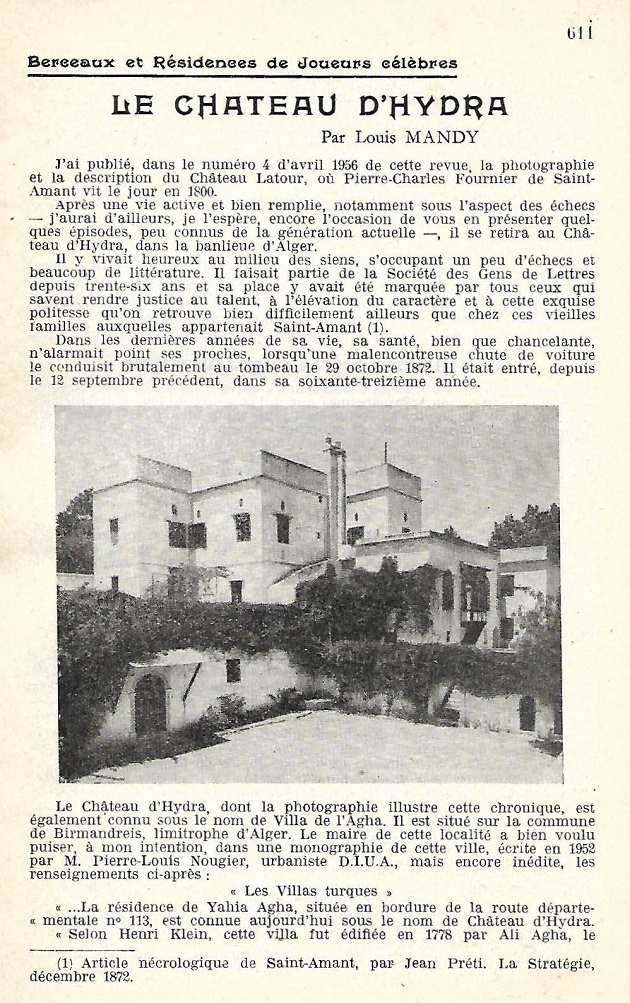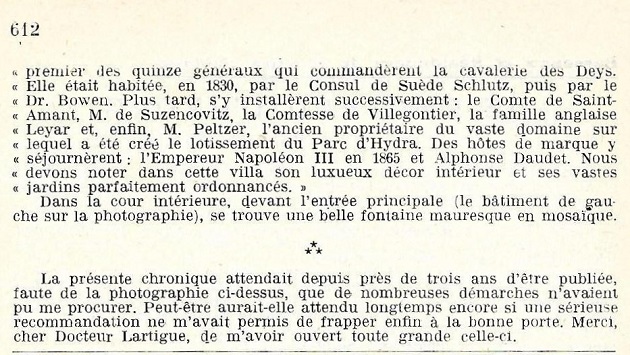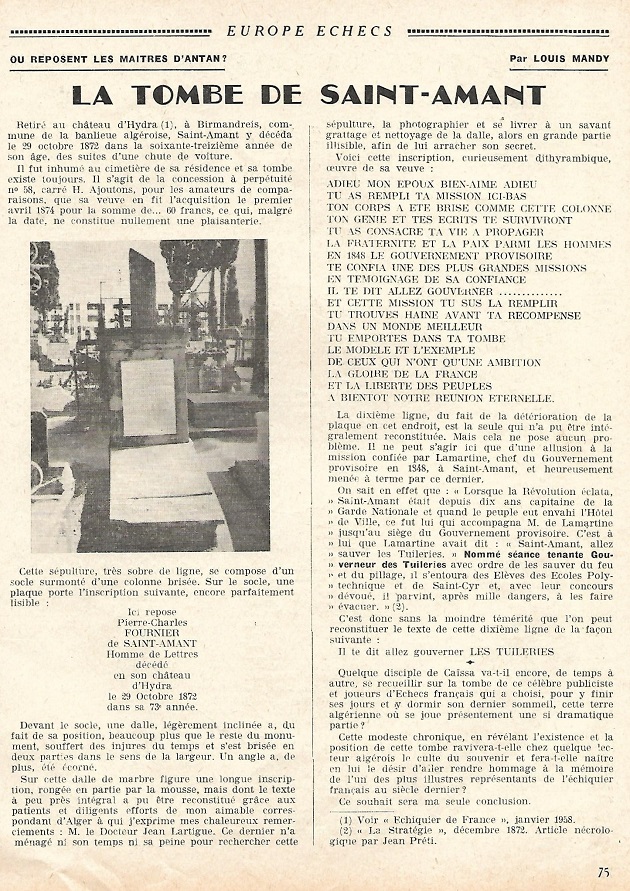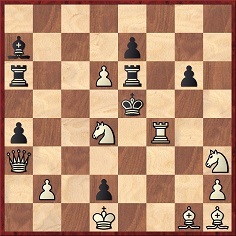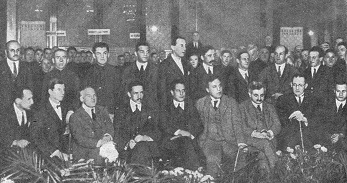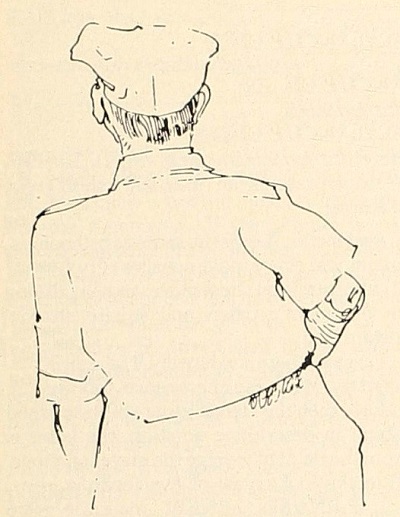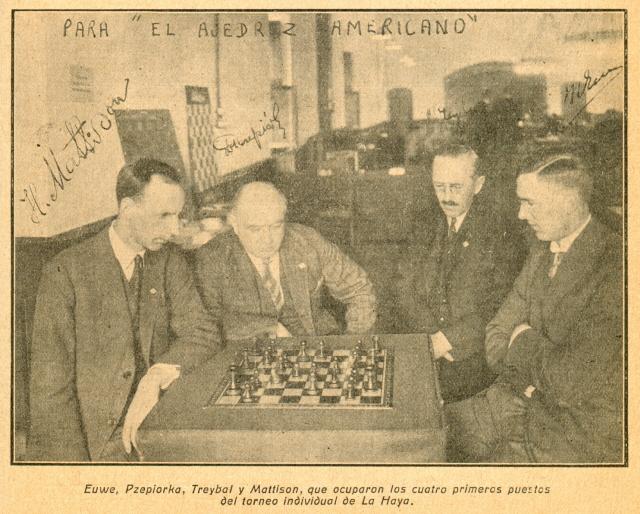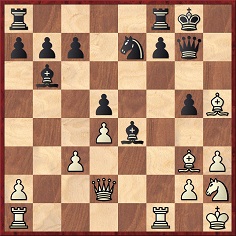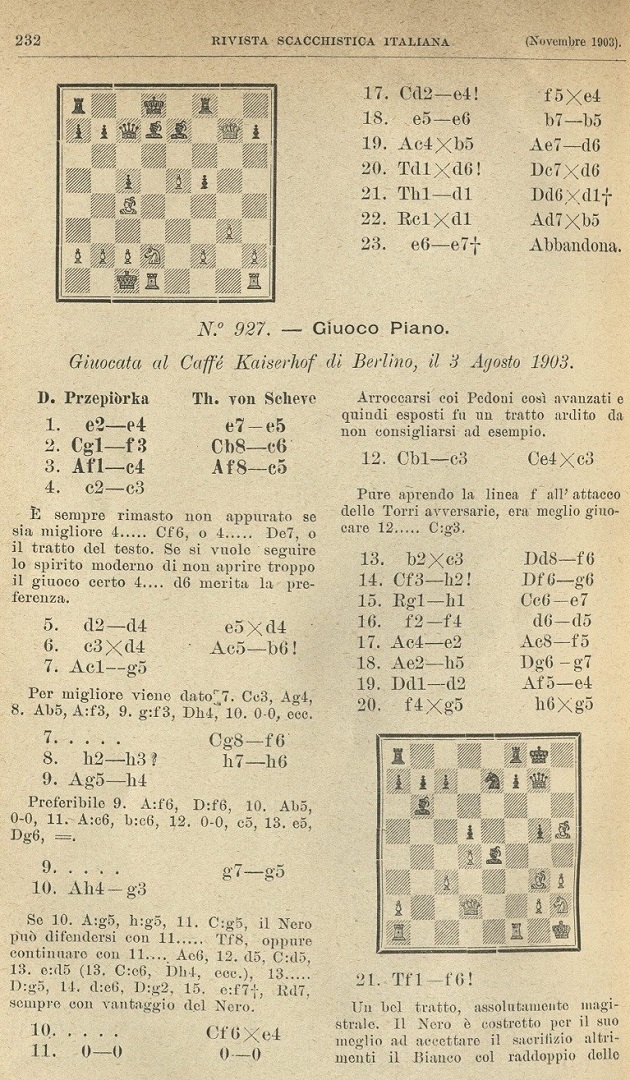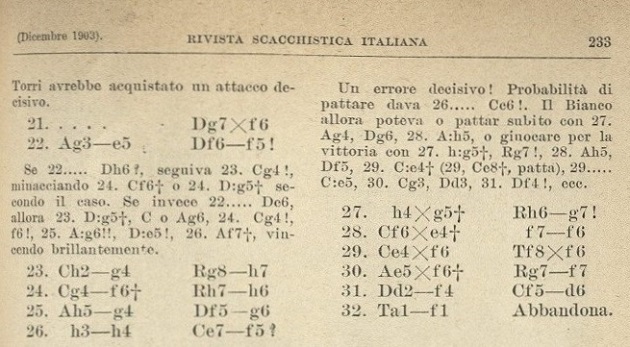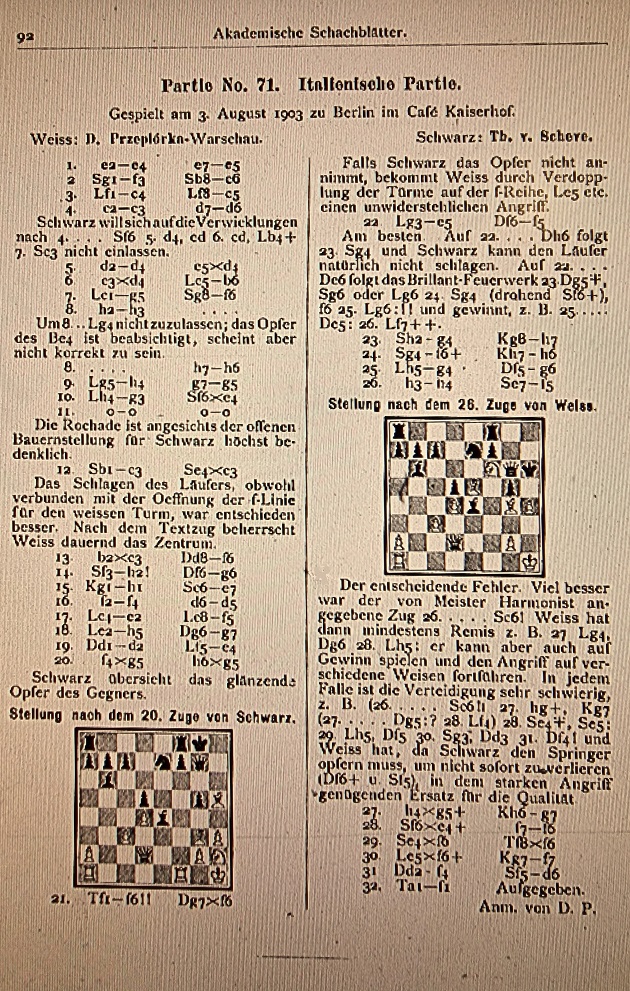11973.
Announced mates
Zachary Saine (Amsterdam) asks how the practice
of Announced
Mates arose.
11974.
Cyril
Pustan (1929-77)
Willibald Müller (Munich, Germany) draws our
attention to a 1967 East German film Die
gefrorenen Blitze, with particular reference
to ‘Cyril Pustan, the second husband of Bobby
Fischer’s mother’:
Preview;
Lengthy
extract
from
the documentary.
We add that the University
of Bradford states:
‘The Cyril Pustan archive collection has
recently been kindly donated to Special
Collections at the University of Bradford’s JB
Priestley Library and will be made available to
researchers in the near future.’
11975.
The
most spectacular queen sacrifice
From Richard Forster (Winterthur, Switzerland):
‘When chess.com
presented a list of the ten most spectacular
chess moves of all time in September 2020,
first place went to Shirov’s famous ...Bh3
move against Topalov. However, second place
was taken by a virtually unknown specimen:
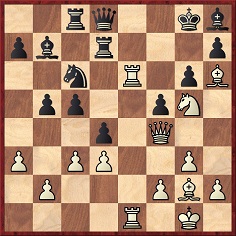
White played 1 Qc7, and Black resigned after
1...Rdxc7 2 Re8.
It was pointed out that White had other
winning moves, with Stockfish listing the
spectacular 1 Qc7 only in about fifth
position.
A more interesting question concerns the
circumstances and provenance of the ending.
Chess.com only wrote “Meier was White against
Muller in 1994”, which invited some
speculation in the comments section about the
identities of the players and the authenticity
of the game. Elsewhere on the Internet,
“Germany” can be found added as the country,
but the origins of the game seem to remain a
mystery.
Most likely, the ending was picked up by the
chess.com team (directly or indirectly) from
John Emms’ controversial 2000 book The
Most Amazing Chess Moves of All Time, which
had heavily relied on previous work by Tim
Krabbé and others with scant acknowledgement
(see item
70 on one of Krabbé’s webpages). Emms
gave the caption to puzzle 178 as “R. Meier –
S. Müller, Switzerland 1994”. As already
pointed out in my Late Knight column no. 28 at
Chesscafe.com (“Amazing?”), August 2000, the
source will have been my earlier Late Knight
column no. 2 of June 1998 (“Alpine
Accounting”), where I gave the whole game and
specified that it was played between René
Meier and Stefan Müller in Thun, Switzerland
in 1994.
Here is the full score with all the players’
details and the original source:
René Meier (Sihlfeld) – Stefan Müller
(Thun), Thun, 7 May 1994. 1 Nf3 c5 2 g3 Nc6 3
Bg2 g6 4 d3 Bg7 5 e4 e6 6 O-O Nge7 7 Nbd2 O-O
8 Re1 d5 9 c3 b6 10 Nf1 Ba6 11 e5 Rc8 12 Bf4
b5 13 a3 Qb6 14 Qd2 Rfd8 15 Bh6 Bh8 16 Qf4 Rd7
17 Ne3 d4 18 Ng5 Nf5 19 Nxf5 exf5 20 e6 fxe6
21 Rxe6 Bb7 22 Rae1 Qd8 23 Qc7 Rdxc7 24 Re8
Resigns.
The game was played in round five on the
seventh and last board of a team match in the
second class (“2. Bundesliga”) of the Swiss
workers’ Chess Union league
(“Gruppenmeisterschaft”). It first appeared in
print with a few annotations by the winner in
the Schweizerisches Schach-Magazin,
no. 6, June 1994, page 189.
A curious twist was added in KARL,
no. 3/2023, page 59, when Michael Ehn and
Ernst Strouhal gave the ending as “the most
spectacular queen sacrifice of all time”,
attributing it to “Smith-Walls, USA 1993”
without any further indication of their
source.
Here for the record is the 1994 publication
of the Meier v Müller game:’

11976.
Alekhine
and Capablanca
Our new feature article on Sir
George Thomas does not yet include a famous
observation attributed to him, because we
currently lack a verifiable source.
From page 161 of The Unknown Capablanca
by David Hooper and Dale Brandreth (London, 1975):
‘One is reminded of a remark made by Sir George
Thomas, “Against Alekhine”, he said, “you never
knew what to expect; against Capablanca you knew
what to expect, but you couldn’t prevent it!”’
From page 77 of Capablanca’s Best Chess
Endings by Irving Chernev (Oxford, 1978):
‘Capablanca’s clear-cut play in this ending
calls to mind a comment by Sir George Thomas,
“Against Alekhine you never knew what to expect;
against Capablanca you knew what to expect, but
you couldn’t prevent it!”’
11977.
Staunton
and religion
John Townsend (Wokingham, England) writes:
‘In his book, The Great Schools of
England, Howard Staunton was a staunch
opponent of flogging. Pages xlii to xliii of
the second edition (1869) contain these
remarks:
“Again and again, in treatises on Education,
and in periodicals, it has been condemned; but
from dread lest England should be ruined, lest
ancient traditions and old-world customs
should perish, the administrators of Public
Schools passionately fight for flogging, as if
it were a kind of sacrament, to be added to
the other seven.”
This last observation about sacraments
earned him the attention of the writer of a
critique in Weekly Review (7 August
1869, page 16), who commented that Staunton’s
own “ecclesiastical standpoint” could be
“gathered” from it. (Presumably, the reviewer
was hinting that, by acknowledging the
existence of as many as seven sacraments,
Staunton was displaying a Catholic point of
view.)
Was anything else ever written which
suggested Staunton’s association with
religion?’
11978.
Cecil
De Vere
Also from Mr Townsend:
‘Cecil De Vere was illegitimate, and the
identity of his father has been a mystery.
Now, some new information has been found in
the death certificate of his mother, Katherine
De Vere (General Register Office, Sept. qtr.
1864, Pancras, volume 1b, page 41). It shows
that she died on 7 July 1864 at 10 Lower
Calthorpe Street (Grays Inn Road, London), the
informant being Eliza Hooker, “present at
death”, of the same address. The cause of
death was “Cancer Uteri 2 years”; her age was
given as 42, and she was described as the
widow of Alexander De Vere, naval surgeon.
The name Alexander De Vere is new. This
occupation of her alleged late husband is
consistent with information entered on Cecil
De Vere’s 1846 birth certificate, where the
father’s name was left blank (indicating
illegitimacy), but his occupation was
nevertheless entered as “surgeon”. The birth
certificate was discussed by Owen Hindle in
the Quotes & Queries column of the BCM,
conducted by Chris Ravilious, in December
2003, February 2004 and November 2005.
Katherine De Vere had already been living at
the address where she died at the time of the
1861 census, when she was described as a
widow, aged 36, born in Wales (National
Archives, RG 9 107, folio 91, page 9). At that
time, she had as lodgers Francis Burden, a
civil engineer, and Albert Lane, a landscape
painter, both chessplayers, who taught the
young De Vere to play.
It has not so far been possible to identify
the individual referred to as Alexander De
Vere, and he will need to be the subject of
ongoing research. Likewise, details of his
supposed marriage to De Vere’s mother have not
been readily found.
De Vere’s mother was buried in Brompton
Cemetery on 11 July 1864 in a private grave
paid for by “Valentine De Vere”, “gentleman”,
of the same address. There was neither probate
nor letters of administration.’
Illustrations of the chessplayer are rare. Below
is a detail of the Redcar, 1866 group photograph
in C.N. 5614:
11979.
Copying
Four recent additions to Copying:
The entirety of our compilation of quotations
from the three volumes of W.E. Napier’s Amenities
and
Background
of Chess-Play has been copy-pasted,
without acknowledgement, on a chessgames.com
page.
There is an Alchetron
page which helps itself to various
illustrations from our Sultan
Khan article. That makes it convenient for
the chessgames.com page on him to be illustrated
as follows:
The Bill
Wall method: ransacking our work on
Capablanca, without credit, and giving worthless,
partial sources.
The ChessBase
contributor
Davide
Nastasio has been lifting a huge number of
C.N. photographs (about 80 in the past week
alone), without credit, acknowledgement or
authorization, for his personal X/Twitter page.
Addition on 22 October 2024:
ChessBase has informed us that Davide Nastasio is
now a former ChessBase author.
11980.
Chess clubs
The first
episode of a new PBS television series, Today
in
Chess, refers to ‘the chess capital of the
US, Saint Louis, Missouri’. Through the
munificence of Rex Sinquefield, the Saint Louis
Chess Club is often described, without
contradiction, as the greatest chess club in the
United States. What comparable chess clubs
(whether in terms of premises, opulence,
membership, activity or any further criteria)
exist in other countries? In short, if the Saint
Louis Chess Club were described as the greatest in
the world, would any clubs have a legitimate
grievance?
This photograph of the Saint Louis Chess Club was
taken for us on 12 February 2024 by Yasser
Seirawan:
11981.
Menchik
v Mieses (C.N. 3687)
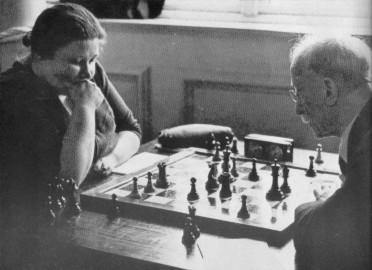
This photograph by Erich Auerbach from The
Quiet Game by J. Montgomerie (London, 1972)
was shown in C.N. 3687, with the question of when
it was taken.
From Philip Jurgens (Ottawa, Canada):
‘Vera Menchik and Jacques Mieses played a
ten-game match between 21 May and 13 June
1942. He was aged 77, some 41 years older than
her. Menchik won by four games to one with
five draws. Page 208 of Robert B. Tanner’s
book on Menchik (C.N. 10191) described it as
“the first ever serious match between a woman
and a strong master”.
According to the West
London Chess Club website, Vera Menchik
joined in 1941 after the National Chess Centre
was bombed in the Blitz. Jacques Mieses was
also a club member during the Second World
War. It is therefore quite likely that they
played their match under the auspices of the
West London Chess Club and that the photograph
was taken during that period.
The above website also states:
“During World War II, very few clubs remained
open, but thanks to the determination of the
officers, West London Chess Club persevered
and invited players from other clubs to play.
This brought more strong players to the club,
including the likes of Jacques Mieses, Vera
Menchik, Sir George Thomas, and briefly,
Capablanca [sic].”’
11982.
Georg
Marco
C.N. 4855 reported a remark by Wolfgang
Heidenfeld on page 190 of The Encyclopedia of
Chess by Harry Golombek (London, 1977):
‘... Marco has left an imperishable chess
legacy in his brilliant and witty annotations.’
That is not the only C.N. item in which relevant
quotations from Marco’s writings have been
solicited, without tangible results; see also
C.N.s 5248, 7819 and 11380. Examples of
Heidenfeld’s own brilliance and wit could, and
perhaps should, be compiled, but Marco deserves
priority. Can readers assist?
11983.
J.
Baca-Arús
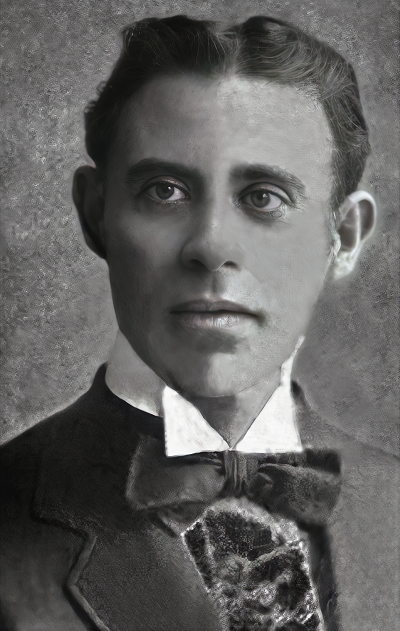
Jaime Baca-Arús
(C.N. 11881)
Further to The
Capablanca
v
Price/Baca-Arús Mystery, Yandy Rojas Barrios
(Cárdenas, Cuba) has been looking for games played
by Jaime Baca-Arús, and he offers the following:
Jaime Baca-Arús – René Portela
Casual game, Havana, 1912 (?)
Danish Gambit
1 e4 e5 2 d4 exd4 3 c3 dxc3 4 Bc4 cxb2 5 Bxb2 Qe7
6 Nc3 Nf6 7 Nge2 Nxe4 8 O-O Nxc3 9 Nxc3 Qc5 10 Re1
Be7 11 Nd5 Nc6 12 Nxc7 Kd8 13 Nxa8 Qxc4 14 Rc1 Qb4
15 Qc2 Bf6 16 Bxf6 gxf6 17 Qf5 Qd4 18 Rcd1 Qc3 19
Rc1 Ne7 20 Qf4 Nd5 21 Qd6 Qd4 22 Qb8 Ne7 23 Rxc8
Resigns.
Source: El Fígaro, 10 March 1912, page
138.
Jaime Baca-Arús – E.C. de Villaverde
Casual game, Havana, 28 March 1912
Philidor’s Defence
1 e4 e5 2 Nf3 d6 3 Nc3 Be7 4 d4 exd4 5 Nxd4 Nf6 6
f4 c5 7 Nf3 O-O 8 Bd3 a6 9 O-O b5 10 b3 Bb7 11 Ng5
h6 12 Kh1 b4 13 Nd5 Nxd5 14 exd5 hxg5 15 Qh5 g6 16
Bxg6 fxg6 17 Qxg6 Kh8 18 Bb2 Bf6 19 Rf3 g4 20 Qh5
Kg8 21 Qxg4 Bg5 22 Qe6 Rf7 23 fxg5 Qe7 24 Qg6 Kf8
25 Raf1 Bxd5 26 Rxf7 Bxf7 27 Qf5 Kg8 28 g6 Be6 29
Qh5 Resigns.
Source: El Fígaro, 21 April 1912, page
238.
Jaime Baca-Arús – René Portela
Round 1, Havana Chess Club Championship, 1912
Queen’s Gambit Declined
1 d4 d5 2 c4 e6 3 Nc3 c5 4 cxd5 exd5 5 Nf3 Nc6 6
g3 Nf6 7 Bg2 cxd4 8 Nxd4 Qb6 9 Nxc6 bxc6 10 O-O
Ba6 11 Qa4 Bb5 12 Nxb5 cxb5 13 Qb3 Rd8 14 Bg5 Be7
15 Bxf6 Bxf6 16 a4 O-O 17 axb5 Rfe8 18 Bxd5 Rxe2
19 Bxf7 Kh8 20 Rad1 Rxb2 21 Rxd8 Qxd8 22 Rd1 Qb6
23 Qe3 Qxe3 24 fxe3 Rxb5 25 Rd7 a5 26 Rd5 Rxd5 27
Bxd5 a4 28 Kg2 g6 29 Kf3 Kg7 30 h4 Kf8 31 Kf4 Ke7
32 Ke4 Kd6 33 Ba2 Kc5 34 Kd3 Kb4 35 Kc2 a3 36 Kd3
h5 37 Kc2 Be5 38 Bf7 Drawn.
Source: Capablanca Magazine, 31 July
1912, page 108.
Jaime Baca-Arús – Gustavo Fernández
Casual game, Havana, 8 March 1914
Danish Gambit
1 e4 e5 2 d4 exd4 3 c3 dxc3 4 Bc4 cxb2 5 Bxb2 Qe7
6 Nc3 c6 7 Nge2 b5 8 Bxb5 cxb5 9 Nxb5 Qb4 10 Nec3
Qc5 11 Qd5 Qxd5 12 Nxd5 Na6 13 O-O Rb8 14 a4 Bb7
15 Rfe1 Bc6 16 Bd4 Nf6 17 Bxa7 Rb7 18 Bd4 Bb4 19
Reb1 Bxd5 20 exd5 O-O 21 d6 Ne4 22 f3 Nd2 23 Rxb4
Nxb4 24 Bc3 Nb3 25 Rb1 Nd5 26 Rxb3 Nxc3 27 Rxc3 g6
28 Rc7 Rb6 29 Rxd7 Ra8 30 Rc7 Kf8 31 d7 Ke7 32 Na7
Rab8 33 Nc6 Kd6 34 Rc8 Kxd7 35 Rxb8 Rxc6 36 Rb7
Rc7 37 Rxc7 Kxc7 38 Kf2 Kb6 39 Ke3 Ka5 40 Kf4 Kxa4
41 Ke5 f5 42 g4 Resigns.
Source: El Fígaro (Ajedrez Local, Juan
Corzo),
19 April 1914, unnumbered page.
Jaime Baca-Arús – M.A. Carbonell
Round 1, II Intersocial Tournament, Havana, 1931
Caro-Kann Defence
1 e4 c6 2 d4 d5 3 Nc3 dxe4 4 Nxe4 Nf6 5 Nxf6 exf6
6 Nf3 Bd6 7 Bd3 Bg4 8 O-O O-O 9 c3 Qc7 10 h3 Bh5
11 c4 Rd8 12 c5 Bh2 13 Kh1 Bf4 14 Be3 g5 15 g4 Bg6
16 Bxg6 hxg6 17 Qd3 Nd7 18 b4 Kg7 19 Rad1 Rh8 20
Kg2 Rad8 21 Rh1 b6 22 Bxf4 Qxf4 23 Qe3 Qb8 24 d5
Rhe8 25 Qc3 cxd5 26 Rxd5 bxc5 27 bxc5 Qc7 28 Rhd1
Nb8 29 Rxd8 Rxd8 30 Rxd8 Qxd8 31 Nxg5 Qd5 32 Nf3
Nc6 33 g5 Ne5 34 gxf6 Kxf6 35 c6 Ke6 36 Qxe5
Resigns.
Source: Diario de la Marina, 13 December
1931, page 18.
Biographical and other information is still being
researched by our correspondent and will be added
in due course.
11984.
Anything
is good enough
As quoted in C.N. 876 (see Book
Notes), Charles W. Warburton wrote the
following on page 42 of My Chess Adventures
(Chicago, 1980) in a discussion of the Caro-Kann
Defence:
‘Typically convincing is the thought of Dr
Emanuel Lasker who was known to say “anything is
good enough to play once”.’
Countless masters are purportedly ‘known’ to have
said countless things, but in this case we can at
least cite a vague attribution from Lasker’s
heyday. On pages 516-517 of the December 1898 BCM
J.H. Blake annotated Tarrasch v Halprin, Vienna,
1898, which began 1 d4 d5 2 c4 e6 3 Nc3 Nf6 4 Bg5
Be7 5 Nf3 h6 6 Bf4 dxc4 7 e3 Nd5 8 Be5 f6 9 Bg3
Bb4 10 Qc2 b5 11 a4 c6 12 axb5 cxb5 13 e4.
After 8 Be5, Blake wrote:
‘Black’s moves six to ten constitute a line of
defence to the attack by B-KB4 in the Q. Gambit,
which is little known, and which, though not
strictly recommendable, may occasionally serve
its turn, in accordance with a maxim attributed
to Lasker, that in the opening “anything is good
enough to play once”. Dr Tarrasch,
however, was on this occasion no stranger to it,
since it was played against him (after 4 B-B4
PxP 5 P-K3 Kt-Q4, etc.) by Maróczy at Buda Pesth
[in 1896]; it is the more surprising therefore
that he should so nearly have fallen a victim to
it here, as his continuation on the previous
occasion by 6 KBxP KtxB 7 PxKt is in the present
position the only good defence, and a perfectly
satisfactory one.’
11985.
Backward
moves and empty squares
Instruction manuals sometimes note the difficulty
of visualizing a) sacrifices on empty squares and
b) backward moves by pieces. Who first made such
observations in print? Also requested: practical
examples (the less well known, the better).
11986.
Rupert
Brooke’s notebook
It is still not proving possible to find out more
about the texts included in the notebooks (circa
1902-04) of Rupert Chawner Brooke (1887-1915), as
shown in our feature
article on him. For example:
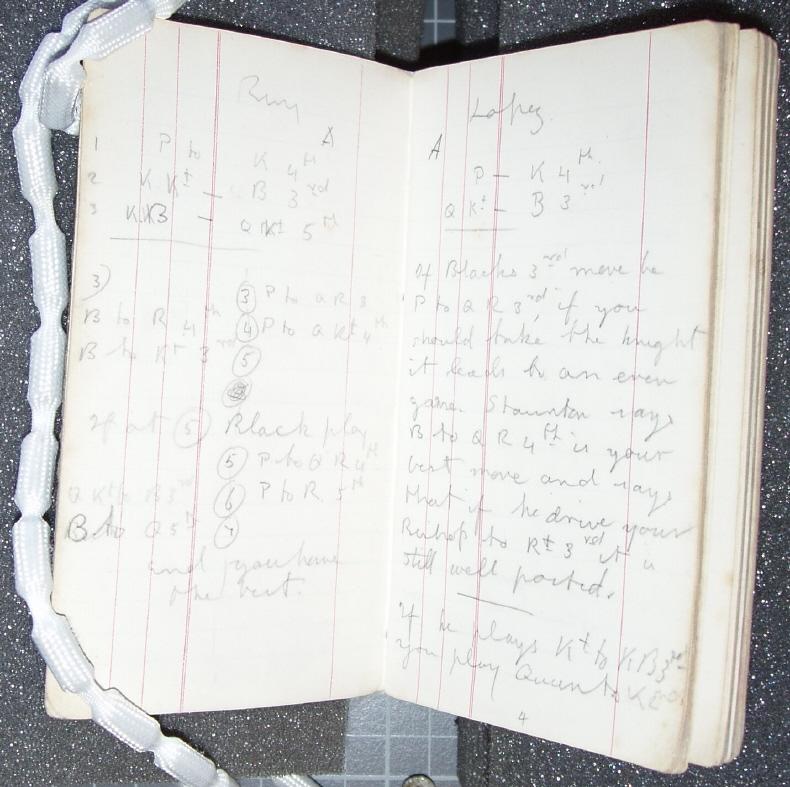
We observed that Brooke appeared to be copying
openings material from a book or magazine, and
that the reference to Staunton related to remarks
originally published on page 148 of his Handbook
(London, 1847). Can nothing further be found?
From page 69 of Rupert
Brooke by Michael Hastings (London, 1967)
11987.
Samuel Reshevsky
Avital Pilpel (Haifa, Israel) sends, courtesy of
Herbert Halsegger, a feature about the prodigy
Reshevsky on page
2
of
part 6 of the Richmond Times-Dispatch,
20 March 1921:
Larger
version
11988.
Preparation
Wanted: little-known accounts by masters of their
chess preparations for important tournaments and
matches.
11989.
Steinitz
and Séguin
Our recent feature article Wilhelm
Steinitz Miscellanea quotes remarks such as
the following by Steinitz about James Séguin, on
page 86 of the International Chess Magazine,
April 1888:
‘And I mean to devote
to the task [i.e. exposing the alleged dishonesty
of James Séguin], if necessary, the space of this
column for the next 12 months, or for as many
years, in case of further literary highway
robberies perpetrated by the same individual, and
provided that I and this journal survive, in order
to statuate for all times, or as long as chess
shall live, an example that the only true champion
of the world for the last 22 years (I may say so
for once), who has always defended his chess
prestige against all-comers, has also a true
regard for true public opinion, and that he can
defy single-handed all the lying manufactories of
press combinations to show any real stain on his
honor; and that he can convict and severely punish
any foul-mouthed editor who, like the shystering
journalistic advocate of New Orleans, attempts to
rob him of his good name outside of the chess
board.’
Has there been a trustworthy investigation of
Steinitz’s objections concerning Séguin?
11990.
The
Thomas family
As a supplement to Sir
George Thomas, John Saunders (Kingston upon
Thames, England) submits this report from page 9
of the Morning Post, 22 June 1895:
Our correspondent is the Webmaster of BritBase
– British Chess Game Archive.
11991.
Difficult
to visualize (C.N. 11985)
In addition to backward moves and sacrifices on
empty squares, there can be difficulty in seeing
collinear moves, as discussed, with examples, in
C.N. 4230 and 4233. Those items are in our feature
article on the originator of the term, John
Nunn.
11992. Staunton and Morphy
The text of C.N. 11939:
What was the largest number of games that
either Staunton or Morphy ever played
simultaneously (excluding the latter’s blindfold
displays)?
This surprisingly difficult question has been
mentioned in, for instance, C.N.s 4492 and 11874
(see Howard
Staunton) and C.N. 10423 (see Paul
Morphy). Citations for numbers as low as
three or four will be welcomed, to start the
ball rolling.
The ball still stubbornly stationary, we now
approach the issue from a fresh angle (‘prêcher
le faux pour savoir le vrai’). Let it be
imagined that, excluding Morphy’s blindfold
displays, a chess author were to write:
‘In their entire lives neither Staunton nor
Morphy gave a single normal/regular simultaneous
exhibition.’
What facts could be put forward to refute that
imaginary chess author’s assertion?
11993.
Staunton
correspondence
From John Townsend (Wokingham, England):
‘Sixty-two letters, written 1855-74, by
Howard Staunton to his friend and fellow
Shakespeare scholar, James Orchard
Halliwell-Phillipps, are deposited at
Edinburgh University Library. The chess
content is precisely nil. That is because his
interest by that stage of his life had turned
to Shakespeare and other literary and
historical matters, some of which he pursued
through his contributions to the Illustrated
London News. Nevertheless, the correspondence
has much to offer regarding Staunton the man
and shows him as a person quite different from
the vengeful fiend which he is sometimes
portrayed as being.
In the example which follows, Staunton is
elated at the prospect of a visit to Broadway,
Worcestershire, where Halliwell-Phillipps’
wife had inherited the library of her father,
Sir Thomas Phillipps, at Middle Hill. Staunton
also expected that the Cotswolds air would be
beneficial for his chest condition (described
by him elsewhere as bronchitis), and he looked
forward to renewing his friendship with
Halliwell-Phillipps, whose company he very
much enjoyed. He was anxious for his friend to
turn up.
The letter is typical of Staunton’s prose in
his letters to Halliwell-Phillipps: relaxed
and informal, yet studded with literary
allusions.
“117 Lansdowne Road,
Kensington Park (W)
May 17th 1873
Dear Halliwell,
I am off to the famous Cotswolds where Master
Page’s fallow greyhound came off second best.
I hope no mishap will prevent you from joining
me on Monday and, then, ‘What larks!!’
How I long for a tramp over those glorious
hills!
‘Broadway rises to a height of 1,100 feet
above the sea.’
Think of that, Master Brook! Think of the
delicious ozoned oxygen! Think of the road
side pebbles when, as poor Lamb used to say,
‘We have walked a pint’! Think of the fresh
eggs & the streaky bacon! Think of the
neat-handed Phillisses, the Cotsoll Hebes!!
and with these thoughts let no ordinary
impediment deter you from ‘taking the road’.
Give my best regards to the ladies and believe
me
Sincerely Yours
H. Staunton
J.O. Halliwell-Phillipps”
Source: Edinburgh University Library,
Special Collections, Letters to J.O.
Halliwell-Phillipps, 203/20.
The visit was highly successful and he
stayed at the prestigious Lygon Arms in
Broadway. In his James
Orchard
Halliwell and Friends: IV. Howard Staunton
(1997, page 128), Marvin Spevack records
Halliwell-Phillipps’ sentiments expressed in a
letter from Broadway of his trip with Staunton
to Stratford that they were
“as jolly as sandboys [...] how long can
jollity last in the world, and would there be
any without B. and S.”’
11994.
Excuses
‘I had a toothache during the first game. In
the second game I had a headache. In the third
game it was an attack of rheumatism. In the
fourth game, I wasn’t feeling well. And in the
fifth game? Well, must one have to win every
game?’
Anyone using a search-engine for that remark, or
a slightly different wording, will be presented
with countless webpages. Most ascribe the comment
to Tarrasch, some to Tartakower, and none to a
precise source.
In print, it is no surprise to find A. Soltis
writing the following sourcelessly on page 11 of Chess
Life, June 1990:
‘And it was Tartakower who had perhaps the
final word on excuses. Asked how he could lose
so many games in a row at one tournament he
replied: “I had a toothache during the first
game, so I lost. In the second game I had a
headache, so I lost. In the third game an attack
of rheumatism in the left shoulder, so I lost.
In the fourth game I wasn’t feeling at all well,
so I lost. And in the fifth game – well, must I
win every game in a tournament?”’
An earlier version was related by Harry Golombek
on page 91 of the April 1953 BCM in a
report on that year’s tournament in Bucharest, at
which he ‘had a really dreadful phase’:
‘If asked to account for these six successive
losses I think I cannot do better than to quote
Dr Tartakower who on a similar occasion was
explaining why he lost five games in a row in an
international tournament. “The first”, he said,
“I lost because of a very bad headache; during
the second I didn’t feel at all well; I was
afflicted by rheumatic twinges throughout the
third; in the fourth I suffered acute toothache;
and the fifth – well, must one win every game in
a tournament?”’
Readers may care to imagine themselves entrusted
with editing a chess quotations anthology. What to
do with this ‘final word on excuses’? Omit it
owing to the lack of a source? Give in detail the
various versions and attributions? Plump and hope
for the best (the process described in C.N. 9887)?
An attempt may first be made to establish when,
if ever, Tartakower or Tarrasch lost five
consecutive tournament games, and when the story
was first attributed to, if not voiced by, either
of them.
See also Excuses
for
Losing
at
Chess.
11995.
Photographs
Olimpiu G. Urcan (Singapore) has provided this
photograph of Bogoljubow and Rubinstein which he
owns. Exact details of the occasion are sought.
Mr Urcan has also sent us this 1976 photograph of
Tony
Miles (Camera Press Archive):
11996.
Staunton
and Morphy (C.N. 11992)
Jerry Spinrad (Nashville, TN, USA) informs us
that the only simultaneous display by Staunton
which he has seen mentioned in the Chess
Player’s Chronicle is a very small one at
the Rock Ferry Chess Club (July 1853 issue, pages
217-218):
‘A special Meeting of this Society was held on
the evening of the 5th ult. at the Club Rooms,
Rock Ferry Hotel, for the purpose of welcoming
to Cheshire Mr Staunton, who, during his short
visit, was the guest of Mr Morecroft, of the
Manor House ... In the course of the evening
there was some very interesting play. Mr
Staunton conducted simultaneously two games
against the Liverpool gentlemen, in consultation
at one board, giving them the odds of pawn and
two moves, and against the Rock Ferry gentlemen,
at another board, giving them the odds of the
knight.’
After supper and speeches the games were resumed,
but the report did not specify the outcome.
On Morphy, Jerry Spinrad and John Townsend
(Wokingham, England) refer to a simultaneous
display which is well known. Mr Townsend writes:
‘David Lawson, in Paul Morphy, the
Pride and Sorrow of Chess (new edition by
Thomas Aiello, 2010), quoted (on pages
213-214) from an account of a simultaneous
exhibition which took place at the St James’s
Chess Club in London on 26 April 1859, the
source being the Illustrated News of the
World, of “the following Saturday”:
“A highly interesting assembly met in the
splendid saloon of St James’s Hall, on Tuesday
evening last [26 April], when Mr Morphy
encountered five of the best players in the
metropolis.”
The opposition was formidable:
“The first table was occupied by M. de
Rivière; the second, by Mr Boden; the third,
by Mr Barnes; the fourth, by Mr Bird; and the
fifth, by Mr Löwenthal. Mr Morphy played all
these gentlemen simultaneously, walking from
board to board, and making his replies with
extraordinary rapidity and decision. Although
we believe that this is the first performance
of the kind by Mr Morphy, it is a remarkable
fact that he lost but one game. Two other
games were won by him and two were drawn.”’
Those reports, one display apiece by Staunton and
Morphy, are all that can currently be cited here,
although the following may be recalled from C.N.
10423 (concerning Morphy after his match with
Anderssen):
‘He confined himself to simultaneous displays,
playing 20, 30 and even 40 people at once ...’
Source: page 274 of Keene On Chess by R.
Keene (New York, 1999). The identical wording was
on page 275 of Complete Book of Beginning
Chess by R. Keene (New York, 2003).
11997.
Rook ending note
João Pedro S. Mendonça Correia (Lisbon) draws
attention to this annotation on page 217 of the
Caissa Editions translation (Yorklyn, 1993) of
Tarrasch’s book on St Petersburg, 1914 and wonders
whether any personal acrimony underlies the
reference to billiards:
From the original German edition (page 151):
The game was Capablanca v Marshall in round four
of the final section: 1 e4 e5 2 Nf3 Nf6 3 Nxe5 d6
4 Nf3 Nxe4 5 Qe2 Qe7 6 d3 Nf6 7 Bg5 Be6 8 Nc3 h6 9
Bxf6 Qxf6 10 d4 Be7 11 Qb5+ Nd7 12 Bd3 g5 13 h3
O-O 14 Qxb7 Rab8 15 Qe4 Qg7 16 b3 c5 17 O-O cxd4
18 Nd5 Bd8 19 Bc4 Nc5 20 Qxd4 Qxd4 21 Nxd4 Bxd5 22
Bxd5 Bf6 23 Rad1 Bxd4 24 Rxd4 Kg7 25 Bc4 Rb6 26
Re1 Kf6 27 f4 Ne6 28 fxg5+ hxg5 29 Rf1+ Ke7 30 Rg4
Rg8 31 Rf5 Rc6 32 h4 Rgc8 33 hxg5 Rc5 34 Bxe6 fxe6
35 Rxc5 Rxc5 36 g6 Kf8 37 Rc4 Ra5 38 a4 Kg7 39 Rc6
Rd5 40 Rc7+ Kxg6 41 Rxa7 Rd1+ 42 Kh2 d5 43 a5 Rc1
44 Rc7 Ra1 45 b4 Ra4 46 c3 d4 47 Rc6 dxc3 48 Rxc3
Rxb4 49 Ra3 Rb7 50 a6 Ra7 51 Ra5 Kf6 52 g4 Ke7 53
Kg3 Kd6 54 Kf4 Kc7 55 Ke5 Kd7 56 g5 Ke7 57 g6 Kf8
58 Kxe6 Ke8 59 g7 Rxg7 60 a7 Rg6+ 61 Kf5 Resigns.
Tarrasch also criticized 46 c3, appending a
question mark.
Below is the position after White’s penultimate
move, 60 a7:
Tarrasch called Marshall’s 60...Rg6+ a Racheschach.
It is not a ‘spite
check’ strictu sensu, given that two
of the three possible king moves by White lose.
11998.
A
difficult rook ending
On 25 March 2024 Ben Finegold posted on his
YouTube channel a game with a complicated rook
ending submitted by a viewer. Afterwards, starting
at 13’17”,
Finegold drolly commented that most games from
viewers had seven blunders by one side and eight
by the other.
C.N. 7228 gave two pre-Tartakower (1890 and 1901)
occurrences of the observation that the winner is
the player who makes the last mistake but one, but
information is still sought on when it was first
attached to Tartakower’s name, or to that of other
masters.
In the latter category, Barnie F. Winkelman wrote
on page 205 of Chess Review, September
1935:
‘To Lasker chess was (and remains) a contest, a
personal encounter in which he frequently
avoided the best variations, and sought to give
battle on unfamiliar ground. “The winner of a
game of chess”, he is reported to have said, “is
he who makes the last mistake but one.”’
With terms like ‘is reported to have said’ (and
‘reportedly said’), the floodgates are open for
anyone to write anything.
11999.
Chess
Book Chats
As recorded in the Factfinder,
we have referred to Michael Clapham’s website Chess
Book Chats. In the past month it has been
updated with some more first-class articles.
12000.
My System
As shown in Nimzowitsch’s
My System, C.N. 9792 remarked:
Mein System is a rare case of a chess
book also existing in a simplified version,
edited by Heinz Brunthaler (Zeil am Main, 2007).
Now we note that Russell Enterprises, Inc. has
just produced a ‘FastTrack
Edition’ of My System, edited by
Alex Fishbein.
12001.
The
Pride and Sorrow of Chess
With the increase in digitized publications it
can be hoped that more nineteenth-century
occurrences will be found of ‘The
Pride
and Sorrow of Chess’. At present the
earliest citations that we have given are:
C.N. 4053:
On page 113 of the April 1885 International
Chess Magazine Steinitz wrote:
‘... the fearful misfortune which ultimately
befell “the pride and sorrow of chess”, as
Sheriff Spens justly calls Morphy, can only
evoke the warmest sympathy in every human
breast.’
C.N. 6469:
On page 3 of the January 1885 issue of his
magazine Steinitz had mentioned the phrase with
a second definite article but no reference to
Spens:
‘The pride and the sorrow of chess, as Morphy
has been called, is gone for ever.’
12002.
A
remark by Purdy (C.N.s 10171 & 10182)
Still also being sought: the source of the
following annotation by C.J.S.
Purdy:
‘This is a legal move; it has no other merit.’
12003.
The
Club Argentino de Ajedrez (C.N.s 11330, 11341
& 11349)
Some further photographs provided to us by Carlos
León Cranbourne (Buenos Aires):
12004.
Hanging
There is a difference between ‘hanging
pawns’ and ‘pawns hanging’, and we wonder
how far back one can trace the verb ‘to hang’ in
the sense of to leave en prise or to leave
a resource open to the opponent, as in expressions
such as White ‘hung a rook’, ‘left his queen
hanging’ or, indeed, ‘left a mate in one hanging’.
12005.
Announced
mates (C.N. 11973)
We are grateful to Robert John McCrary (Columbia,
SC, USA) for making an initial search for early
references to announced mates. It may seem logical
to assume that correspondence chess gave an
impetus to the practice, to limit postage outlay,
but hard facts are still lacking.
Our correspondent draws attention to page
220 of Volume II of the Chess Player’s
Chronicle, which includes this:
‘M. Chamouillet here announced that he could
force mate in nine moves; and his adversaries,
after examining the position, resigned.’
12006.
Vienna,
1922
From Avital Pilpel (Haifa, Israel):
‘Herbert Halsegger has drawn my attention to
sketches by L.R. Barteau of some of the
players in the Vienna, 1922 tournament, as
well as the President of the Vienna Chess
Club, Dr Kondor. They appeared on half the
front page of the Illustriertes Wiener
Extrablatt, 18
November 1922. The information about
Kondor is from page 3 of the same issue, in
the chess column.’
12007.
Cheating
Prompted by the swirl of unverified and
unverifiable claims about online cheating,
we suggest the following:
Accusations need corroboration. Insinuations
need expurgation.
12008.
The
spite check
C.N. 11997 referred to the term ‘spite check’ and
the similar, though not identical, German word Racheschach.
As shown in the The
Spite
Check
in Chess, various writers offer various
definitions, but we should like to know of any
(close) equivalents in other languages. Spanish,
for instance, has jaque por despecho.
12009.
The
last mistake but one (C.N. 11998)
Christian Sánchez (Rosario, Argentina) points out
the following in an article by Henry Smith
Williams about Samuel
Reshevsky on page
43 of the October 1920 issue of Hearst’s:
‘In the words of Lasker – for many years the
undefeatable champion – the man who wins is the
man who makes the last mistake but one.’
12010.
The
Orthodox Defence
Wanted: early occurrences of the word ‘Orthodox’
(in any language) in connection with the defence 1
d4 d5 2 c4 e6.
12011.
Fischer
on Alekhine
Alexander
Alekhine Miscellanea begins with Fischer’s
view in the article ‘The
Ten
Greatest
Masters in History’ on pages 56-61 of Chessworld,
January-February 1964):
Would anyone venture to offer serious support to
Fischer’s contention, ‘strangely, if you’ve seen
one Alekhine game you’ve seen them all’?
12012.
T.A.
Krishnamachariar
Further to Two
Indian
Chess Figures, Michael McDowell
(Westcliff-on-sea, England) notes that although
T.A. Krishnamachariar seems to have had no
obituary in The Problemist, the following
appeared on page 510 of the March 1954 issue:
12013.
Ian
Brady, Graham Young and Peter Sutcliffe
From Avital Pilpel (Haifa, Israel):
‘In Chess
and Murder, you note that “Ian Brady
described playing chess against Graham Young in
Parkhurst Prison on the Isle of Wight”. It is
worth adding that after Brady’s death, an
interview with another British serial killer –
Peter Sutcliffe, the “Yorkshire Ripper” –
stated that the latter played chess with
Brady.
Just as Brady was dismissive of
Young’s chess ability, Sutcliffe was
dismissive of Brady’s, according to an online
Mirror report dated 27 May 2017.’
12014.
Announced
mates (C.N.s 11973 & 12005)
John Townsend (Wokingham, England) writes:
‘Page 23 of William Hartston’s The
Kings of Chess (London, 1985) contains an
example of an announced mate by Philidor. The
occasion was an odds game with Count Brühl at
Parsloe’s in London on 26 January 1789. White
was in check, “and Philidor announced mate in
two moves: 28 Qxf5! and 29 Rh8 mate”.
George Walker’s A Selection of Games at
Chess, actually played by Philidor and his
contemporaries (London, 1835) includes the
game on pages 41-42 with the following
termination:
“27 K. Kt. P. on. Kt. to K. B. fourth, ch. 28
Q takes Kt., and Mates next move with R.”
The Oxford Encyclopedia of Chess Games
by Levy and O’Connell (Oxford, 1981) has the
score (page 15) as concluding with “27 g5 Nf5+
1-0” and gives the source as “MS H.J. Murray
64, Bodleian Oxford, ‘Collection of European
Games’”.’
See also Announced
Mates.
12015.
Rossolimo’s
brilliancies
Michael Petrow (Munich, Germany) notes references
to an alleged self-publication by Nicolas
Rossolimo: Rossolimo’s Brilliancy Prizes
(New York, 1970).
It is mentioned in the English-language Wikipedia
entry on Rossolimo, but neither online nor
elsewhere have we found authoritative information
about its existence.
The other chess work referred to in the entry, Les
Échecs
au coin du feu (Paris, 1947) with a Preface
by Tartakower, has 28 pages and, courtesy of the
Cleveland Public Library, a number of them are
shown below:
12016.
Alekhine’s gun (C.N.s 7880, 7914, 7972, 8625
& 8860)
Eduardo Bauzá Mercére (New York, NY, USA)
provides the following game:
George Walker – Alexander McDonnell
Occasion?
(Odds of pawn and two moves. Remove Black’s
f-pawn.)
1 e4 … 2 d4 Nc6 3 e5 d5 4 c3 Bf5 5 g4 Be4 6 f3
Bxb1 7 Rxb1 e6 8 Bf4 h5 9 Bd3 hxg4 10 Bg6+ Kd7 11
fxg4 Qh4+ 12 Bg3 Qg5 13 Bd3 Nh6 14 Be2 Qe3 15 Kf1
Be7 16 Kg2 Raf8 17 Nh3 Nf7 18 Qd3 Qh6 19 Bf4 Qh4
20 Qg3 Qh7 21 Bd3 g6 22 Rbf1 Bh4 23 Qe3 Be7 24 Rf3
Qg7 25 g5 Rh5 26 Rg3 Qh7 27 Rg4 Bd8 28 Bb5 a6 29
Bxc6+ bxc6 30 Rf1 Be7 31 b4 a5 32 a3 axb4 33 cxb4
Rh8
34 Rf3 Nd8 35 Nf2 Nf7 36 h4 Qg8 37 Bg3 R8h7 38
Nd3 Qh8
39 Nc5+ Bxc5 40 bxc5 Qa8 41 Rf6 Rg7 42 Rgf4 Rhh7
43 Qd3 Nh8 44 Rf8 Qb7 45 Rf3 Ke7 46 R8f6 Rg8 47
Kh3 Qb2 48 Qa6 Qb5 49 Qa7 Qb8 50 Qa5 Nf7 51 Kg4
Qb7 52 Qa4 Ra8 53 Qc2 Nh8 54 Rb3 Qa6 55 Qb2 Rg7 56
Rb8 Rg8 57 Rxg8 Rxg8 58 Rf3 Qc8 59 a4 Qa6 60 Qc2
Ra8 61 Ra3 Rf8 62 Rf3 Ra8 63 Ra3 Rf8 64 Qd3 Qa5 65
Qc3 Qa6 66 Qd3 Qa5 67 Qc3 Qa6 68 Qd3 Qa5 69 Ra1
Qb4 70 a5 Qb2 71 Rb1 Qa2 72 Rf1 Rf5 73 a6 Nf7 74
Rxf5 exf5+ 75 Kh3 Qa1 76 Bf2 Nd8 77 Kg2 Ne6 78 Be3
Qa2+ 79 Kg3 Ng7 80 Kf3 Kd7 81 Bf4 Kc8 82 Bg3 Kb8
83 Qe2 Qxe2+ 84 Kxe2 Ka7 85 Bf4 Kxa6 86 Ke3 Kb5 87
Kd3 Ka4 88 Kc3 Ne6 89 Be3 Ka5 90 Bf2 Ka6 91 Kd3
Kb7 92 Ke3 Kc8 93 Bg3 Kd7 94 Bf2 Ng7 95 Kf4 Ke6 96
Bg3 Kd7 97 Ke3 Kc8 98 Bf4 Kd7 99 Ke2 Ke6 100 Bg3
Kd7 101 Kf3 Nh5 102 Bf2 f4 103 Be1 Ke6 104 Kg4 Ke7
105 Bd2 Ng7 106 Be1 Ne6 107 Bf2 Ke8 108 h5 Kf7 109
h6 Kf8 Drawn.
Our correspondent’s source is pages 88-91 of A
Selection of Games at Chess ... by
William Greenwood Walker (London, 1836).
The set of C.N. items on this theme has now been
brought together in Alekhine’s
Gun.
12017.
Sourcing
Writer A makes a significant discovery in a
100-year-old newspaper and presents the
information with a complete source.
Writer B repeats the information but specifies
only the 100-year-old source, as if he had
discovered it himself.
Such conduct by Writer B is widespread, and a
technical term for it may be sought. Since
technical terms are often -isms, one possibility
is ‘intermediate source misattribution’.
12018.
Reversed
images
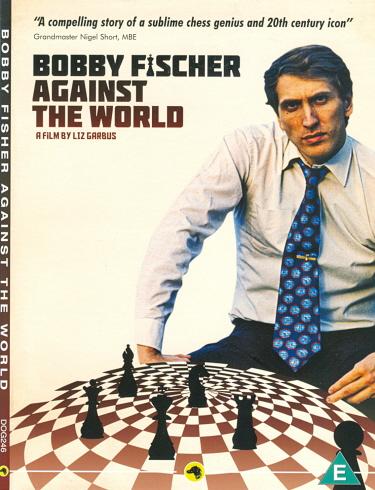
C.N. 7345 (see Chess
and Insanity) quoted slighting remarks about
leading masters by interviewees in Liz Garbus’s
documentary film (2011) Bobby Fischer Against
the World. The CD cover above is a famous
shot by Harry Benson but in reverse form;
Fischer parted his hair on the left. See, however,
C.N. 7860 (included in Gaffes
by
Chess
Publishers and Authors), which mentions a
book by Benson himself, as well as a work on
Pillsbury with a flipped image on its front cover.
As shown by numerous pictures, Morphy too parted
his hair on the left; see our comment on a mirror
image in C.N. 5150. Another mistake occurred on
page 53 of Chessworld, January-February
1964, in a lengthy, richly illustrated article on
Morphy by David Lawson:
Left: published
mirror image – Right: corrected
New in Chess has announced the forthcoming
publication of The
Real
Paul
Morphy by Charles Hertan:
Addition on 28 August 2024:
As shown on the above-mentioned New in Chess
webpage, the front cover has been changed:
12019.
The
Star of David
From Avital Pilpel (Haifa, Israel):
‘Further to your feature article Letters
and
Numbers
in
Chess Problems, sometimes the depiction
is not of a letter or number but an object. In
Sivan 5684 (the Hebrew month equivalent to
June 1924), Ha’shachmat – the magazine
of the “Lasker” chess club in Jerusalem –
published its first chess problems (volume
one, number three, page 1). The very first of
these problems was composed specifically for a
Palestinian chess publication. Zionist
sentiment is emphasized, and it is entitled
“Star of David” and “dedicated to the revival
of chess in our country” by the Jewish-Polish
problemist Jakob Kopel Speiser.’
12020.
Chess
literature
Particularly in the 1980s, C.N. items criticized
the low standard of many chess books and the
preponderance of volumes on openings. Those who,
at the time, dismissed such grievances may
profitably reflect on the situation today. To
mention just one example, Quality
Chess (Glasgow) produces a vast array of
highly impressive titles which are poles apart
from what the chess public was expected to
tolerate decades ago, such as the ‘Batsford
disposables’ referred to in Fischer’s
Fury.
12021.
References
to chess in language courses (C.N.s 8684 &
11023)
Another rare example comes from page 49 of A
First German by L. Stringer, illustrated by
Alfred Jackson (London, 1966):
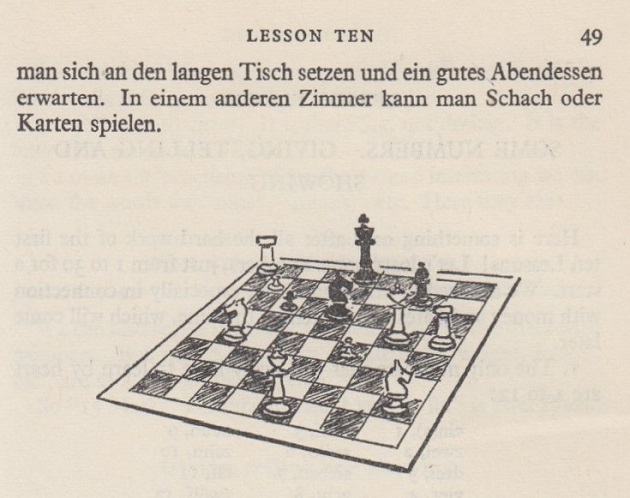
12022.
Stalwarts
In hurriedly penned ‘obituaries’ of minor chess
figures who have just died (they have ‘passed
sadly’ and will be ‘missed sadly’) minor
memorialists often reach for that curious
noun/adjective ‘stalwart’. Never applied to
oneself, it hints at an elderly, unfêted club
member, more notable for his presence than his
prowess, who gladly stays behind to tidy up and
rinse the cups. Our use of ‘his’ is intentional;
chess stalwarts are not female.
12023.
Electronic
resources
Asked by another C.N. correspondent whether he
had researched all of Staunton’s Illustrated
London News columns, G.H.
Diggle replied in 1987 (see C.N.
1439):
‘Of course I have, and broken my shins on
them.’
The days of grappling with bulky annual volumes
in reference libraries have largely gone, home- or
office-based electronic searches having
transformed the task, or joy, of historical
investigation. With Google
Books alone much thirst for knowledge,
whether serious or trivial, can be slaked in
moments by entering key words or phrases.
If, for instance, a chess enthusiast wants to
know about players of past centuries slaking their
thirst in coffee houses, and wonders how the term
became derogatory, innumerable citations can be
found, perhaps beginning with Staunton’s remark on
page 111
of the London, 1851 tournament book that his
second game against Anderssen ‘would be
discreditable to two third-rate players of a
coffee-house’, and culminating in Fischer’s
dismissal of Emanuel Lasker as ‘a
coffee-house player’ in 1964. The words of Georg
Marco will be found too: he considered that the
game Pettersson
v
Nimzowitsch, Barmen, 1905 was ‘played in the
worst coffeehouse style’.
In that game, the spectacle of Nimzowitsch
replying to the Ruy López with 3...f5 may spark
our interest in early analysis of that
opening/defence/gambit/counter-gambit (commonly
named after either of two players who died within
a couple of months of each other, C.F. von
Jaenisch and A.K.W. Schliemann).
To take Jaenisch as an example, Google Books
painlessly leads to a run of Le Palamède.
In the December 1847 issue, Jaenisch contributed a
lengthy article (pages 530-560)
on 1 e4 e5, which he termed ‘Le début royal’.
Beginning on page 538
he analysed the ‘very interesting’ move 3...f5,
with four options for White’s fourth move: d4,
exf5, Bxc6 and d3. He explained on page 538 that
he was temporarily holding back from readers of Le
Palamède his suggestion of a winning method
for White, but that December 1847 issue marked the
abrupt end of the periodical’s run.
Again thanks to Google Books it can be seen how
Jaenisch resolved the difficulty. In 1848 an
abridged version of his original article was
published in the Chess Player’s Chronicle
(pages 216-221,
248-253
and 274-279).
The
move
3...f5
was examined on pages 220-221 and 248-249. In the
1849 volume (pages 362-366)
Jaenisch provided a further article, incorporating
the analysis intended for Le Palamède.
(See too pages 313-315
and 344-345
of the Deutsche Schachzeitung, 1848.)
Leaving aside the awkward question of whether
somebody nowadays writing a book on 3...f5 is
likely to take account of Jaenisch’s detailed
articles, we conclude these random musings with a
curiosity highlighted by him on page 363
of the 1849 Chess Player’s Chronicle,
where he gave a line which ...
‘... exhibits in the theory of regular openings
the unique example of a triple pawn’.
Analysis after
11...bxc6
Jaenisch’s analysis continued this line to move
27.
12024.
Cramling v Pérez
Jon Ludvig Hammer is one of the best commentators
on YouTube and Twitch, blending lucidity with dry
whimsy.
During his live commentary on the seventh-round
women’s match between Sweden and Paraguay at the
Budapest Olympiad on 18 September 2024, he
discussed this position (Pia Cramling v Jennifer
Pérez), starting at about 4:03:30 in the transmission:
White has played
46 Rb7-c7, and Black resigned.
Instead of surrendering, why not produce some
fireworks with 46...Qa6 47 Rxd7+ Kh8 48 Qh6
(threatening mate on the move) 48...Qxf1+ 49 Kxf1
Rc1 mate?
Hammer gave the answer: 49...Rc1 is not mate.
12025.
Mate
in 90 moves (C.N.s 10035 & 10061)
C.N. 10061 (see also How
Many
Moves
Ahead?) showed page 266 of the 1 December
1947 [sic] issue of Chess World,
from an article by Lajos Steiner:
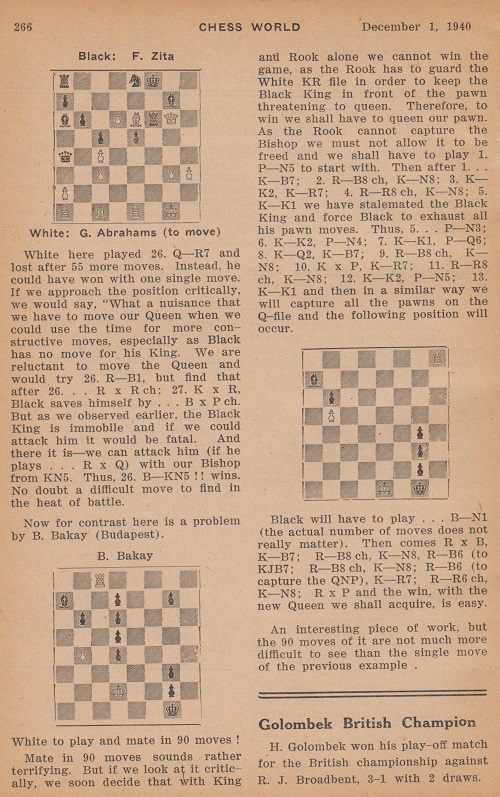
In the Bakay composition, Lindsay Ridland
(Edinburgh) points out a motif which secures Black
a draw: 10…Bb8 11 Rxb8 Kf2 12 Rf8+ Ke1.
12026.
Chess
and poker
From page 406 of the September 1979 BCM (Quotes
and
Queries item 3986 by Kenneth
Whyld):
‘The mention of Franklin Knowles Young
(1857-1931) reminds me of a bon mot
which may be new to readers. Young wrote several
weird chess books which no doubt deceived
military theoreticians into believing that they
understood chess. His fellow American, Clarence
Seaman Howell (1881-1936) wrote of Young’s
“theories of that vague and dreamy and
word-opulent character which abound in art, but
are unwholesome in chess”. This led to a
challenge to a duel over the chess-board. “As to
the matter of stakes”, said Young, “you can put
your money in your pocket. When I play for money
I play poker.” Howell said “I admire your wisdom
in preferring to back your luck rather than your
skill.”’
Two points stand out: the satisfying chess-poker
quip and the troubling absence of any source for
anything.
For a documented account, page 199 of the
November 1901 issue of Checkmate is the
first port of call:
The account of the Pillsbury-Barry controversy
was the sequel to what had appeared on pages
182-183 of the October 1901 issue of the Canadian
magazine:
Acknowledgement
for the Checkmate scans: the Cleveland
Public Library.
Below is the letter from Howell to Young as
published in the Brooklyn Daily Eagle, 22
September 1901, page 32:
Subsequent editions of the Brooklyn Daily
Eagle included these items with the chess
and poker comments:
29 September 1901,
page 20
20 October 1901,
page 23
None of this explains why K. Whyld indicated that
the words ‘theories of that vague and dreamy and
word-opulent character which abound in art, but
are unwholesome in chess’ were written by Howell
and led to the challenge.
The BCM item contained no reference to
Emanuel Lasker, yet it was the world champion who
wrote the following in his column on page 6 of the
Manchester Evening News, 13 November 1901:
Tailpiece: the Lasker column was mentioned by
John Roycroft on page 909 of the October
1996
issue of EG:
In an uncharacteristic mistake, the final
section, ‘The Retort Courteous’, in the Manchester
Evening News was apparently misinterpreted
by EG as being Lasker’s answers to two
correspondents.
12027.
EG
In any list of the greatest chess periodicals, EG,
founded by John Roycroft in 1965, commands a high
position. The run is freely available online.
12028.
Anderssen
v Schallopp
Alan Smith (Stockport, England) reports that Chess Archaeology
provides a link to the third volume (1887) of Brüderschaft.
The periodical, edited by Schallopp and Heyde,
published, at intervals from page 104 onwards, 14
games between Anderssen and Schallopp, few of
which are commonly seen today.
12029. A
pawn
An item on page 153 of the July 1912 American
Chess Bulletin will be added to Chess
and War:
‘An incident of the Boer War
P.A. Hatchard of Albany, NY favors us with the
following touching incident from the Boer war:
Following one of the many engagements that took
place in this war, when the usual rounds were
made to ascertain the number of the killed and
wounded, there was found placed on the knapsack
of one of the former a single chess pawn, the
wounded man having evidently withdrawn it from
the box he carried and placed it in that
conspicuous position ere he succumbed. Many
papers at that period commented on this simple
act as being a silent interpreter of the poor
soldier’s thoughts, comparing himself to a lowly
pawn in the great and terrible game of war.’
12030.
Thousand
Islands, 1897
This photograph was published on page 129 of the
August 1897 American Chess Magazine:
Larger
version and detail of the front
row
We see no caption in the American Chess
Magazine, but as mentioned on page 408 of
the first of two volumes on Pillsbury by Nick Pope
(see the end of our article Harry
Nelson Pillsbury), those seated nearest to
the camera are Borsodi, Hanham, Pillsbury,
Lipschütz, Pieczonka, Steinitz and Napier.
An Albert
Pieczonka webpage shows another photograph
from the same location.
Page 148 of the August 1897 American Chess
Magazine has the group portrait given in
C.N. 5550, and the following is on page 149:
Larger
version
The above images have been provided by the
Cleveland Public Library.
12031.
Letters
and numbers
Concerning Letters
and
Numbers
in Chess Problems, Michael McDowell
(Westcliff-on-sea, England) writes:
‘The composition on pages 22-23 of A.C.
White’s 1909 book Memories of My
Chessboard (Stroud, 1909) remains one of my
favourite letter problems, not least because
there are no pieces used simply to fill in the
shape. He was probably still 16 when he
composed it.’
12032.
Auguste
d’Orville
Auguste d’Orville (1804-64) was described on page
529
of Le Palamède, December 1847 as ‘le
maître des maîtres en fait de problèmes’,
yet he currently has a Wikipedia entry in only
French, German, Italian and Latvian.
The online availability of Some
problems by Auguste d’Orville by John
Beasley (1940-2024) is drawn to our attention by
Michael McDowell. See under ‘Problems’ in
‘Orthodox Chess’.
12033.
Ordinal
numbers
When and where did the practice arise of
referring to world chess champions with ordinal
numbers, at least until the 1993 bifurcation?
Kasparov is known as the 13th in the lineage, but
did writers in 1972, for instance, see any reason
to describe Spassky and Fischer as the 10th and
11th?
12034.
Images
If we received a nominal sum every time a scanned
image from chesshistory.com was misappropriated
and viewed on YouTube, Wikipedia, X/Twitter,
Facebook, chess.com, or other websites and
outlets, we could single-handedly offer to fund
future world championship matches.
See Copying.
12035.
Samuel Reshevsky’s birth-date
C.N. 11994 invited readers to imagine themselves
as the editor of a chess quotations anthology
faced with handling a remark attributed, in
various wordings, to both Tarrasch and Tartakower.
Now, let readers see themselves as the editor of a
single-volume chess encyclopaedia and having to
decide what date of birth to give in the entry on
Samuel Reshevsky.
The natural course may be to follow Jeremy
Gaige’s Chess Personalia (Jefferson, 1987)
and take the precaution of also checking the
privately circulated 1994 edition:
‘26 November 1911’ is in both editions, but the
encyclopaedist may worryingly recall an article by
Andrew
Soltis on pages 10-11 of the August 1992 Chess
Life:
From C.N. 1943:
On page 10 of the August 1992 Chess Life
Andy Soltis wrote that Reshevsky had told a
number of chessplayers that he was born in 1909,
and not 1911 as commonly believed.
Page 202 of Kings, Commoners and Knaves
added a footnote:
However, in an interview with Hanon Russell in
August 1991, Reshevsky insisted that he had
indeed been born in 1911.
C.N. 11199 reverted to the subject:
... a claim emerged in the early 1990s that
Samuel Reshevsky was born in 1909 and not, as
commonly accepted, in 1911.
The matter is discussed by Bruce Monson in an
article about Reshevsky on pages 46-55 of the
1/2019 New in Chess.
Here, we quote the start of Monson’s
investigation of the birth-date matter (page 51):
‘But in the 1990s other information started
percolating to the surface, no doubt in the wake
of Sammy’s death on 4 April 1992. In the August
1992 Chess Life Andy Soltis revealed
that Reshevsky had told a number of chessplayers
that he was actually born in 1909 and not in
1911. Unfortunately, Soltis did not identify
these individuals. However, it is plausible.
Reshevsky was known on occasion to inadvertently
spill the beans about other “secrets” from his
past, such as the assertion that he had never
studied chess as a child, which is simply not
true, only to later try to shove the genie back
in the bottle.’
Difficult to summarize, Monson’s article is
important and should be read in full. It contains
both documentation and speculation, marked as
such. One image is a Łódź registration card dated
1919 which indicates that Samuel Reshevsky was
born in 1909 (with no exact date). Using this and
other materials and inferences, Monson wrote on
page 53 of the New in Chess article:
‘Conclusion: Reshevsky’s birthday should – at
the bare minimum – be adjusted to 26 November
1909. And in all probability his actual date of
birth was 26 May 1909, adding an additional six
months to his age.’
What, then, should our hypothetical
encyclopaedist put in the Reshevsky entry?
Andrew Soltis has a new book out, a chess memoir
entitled Deadline Grandmaster (Jefferson,
2024). Page 246, which can be viewed online,
includes the following:
Some obvious questions:
1. ‘In Chess Life I wrote that Samuel
Reshevsky was born two years before he claimed.’
Where in Chess Life? Certainly not on
page 10 of the August 1992 issue, where, as
shown above, Soltis mentioned the 1909 date
merely as a possibility derived from hearsay.
2. ‘I was accused of falsely maligning
Reshevsky.’ By whom, where and when?
3. ‘His birth record surfaced more than a
decade later and confirmed I was right.’ Where
and when? And more than a decade later than
what?
4. The Deadline Grandmaster text shown
above ends with a superscript 7. This leads to
the ‘Chapter Notes’, where, on page 356, note 7
reads (in full):
‘New in Chess, Issue 1, 1999.’
Why put that? Issue 1, 1999 of New in Chess
has nothing about Reshevsky’s date of birth.
Addition on 2 October 2024:
From Marek Soszynski (Birmingham, England):
‘I believe I was the first to discover and
publish evidence that Reshevsky was born in
1909, which I presented in my book The
Great Reshevsky: Chess Prodigy and Old Warrior
(Forward Chess, 2018). Bruce Monson briefly
references my findings in his article, and
explained to me at the time that the brevity
was due to editorial cuts by New in Chess.
My later book, Rare and Ruthless
Reshevsky (MarekMedia, 2023), does not
revisit the birthdate issue.’
12036.
Harry
Golombek at university
In the English-language edition of Wikipedia, the
entry on Harry Golombek currently states, for
unclear reasons, that he studied ‘philology at
King’s College, London’.
Our feature
article on him quotes the following:
- ‘Golombek went from Wilson’s Grammar to London
University, though there is no record of his
having completed his degree.’ (William
Hartston);
- ‘Golombek also began, but did not complete, a
general degree at King’s College, London,
leaving in 1932.’ (W.D. Rubinstein);
- ‘Golombek enjoyed a superlative gift for
conveying the drama of battles on the
chessboard, elevating chess commentary to the
literary level of the Icelandic epic sagas which
he had studied for his Doctorate.’ (Raymond
Keene).
We are grateful to Gemma Hollman (the Senior
Archives Assistant, Libraries & Collections at
King’s College, London), who has searched the
student slip books, the main source for student
records, and has sent us the entry for Harry
Golombek:
Larger
version
It states that Golombek was registered for a
Bachelor of Arts degree (Latin, English, French
and History) from 1930 to 1932. He failed both
years.
12037.
Brad Darrach v Bobby Fischer
Brad
Darrach
and the Dark Side of Bobby Fischer
summarizes the dispute about Darrach’s book Bobby
Fischer
vs. the Rest of the World (New York, 1974)
on pages 299-300 of the May
1975 Chess Life & Review, a
dispute which concerned three pieces in the New
York Times Book Review:
-
13 October 1974, page 6: a review by D. Keith
Mano of the Brad Darrach and George Steiner
books on the 1972 Spassky v Fischer match;
-
17 November 1974, page 59: a letter to the
Editor from Burt Hochberg, which is reproduced
in the May 1975 Chess Life & Review;
-
23 February 1975, pages 41-42: a letter to
the Editor from Brad Darrach in response to
Hochberg. Extracts were reproduced, and
disputed, by Hochberg in the May 1975 Chess
Life & Review.
See also the many references to Darrach indexed
in Bobby Fischer and His World by John
Donaldson (Los Angeles, 2020). These include, on
page 493, a brief comment that Darrach’s
above-mentioned letter was ‘the only public
response by Darrach after the book’s publication’.
Donaldson added:
‘Darrach shows no feelings of remorse in his
lengthy defense to charges by Frank Brady and
Burt Hochberg that he betrayed Bobby’s
confidence and put words in his mouth. Nor does
he comment about breaking his agreement with
Fischer.’
It should, however, be noted that such charges
did not appear in the Hochberg letter to which
Darrach was replying.
We add here some significant passages in
Darrach’s letter (sent from Madison, CT, USA) in
the New York Times Book Review which were
not quoted in Chess Life & Review:
-
‘The world of chess is like the Chinese court
in the story of “The Emperor’s New Clothes”.
The Emperor, Bobby Fischer, wanders about in a
strange condition but nobody dares to say what
everybody can see. In private, chess people
tell grotesque or funny stories about their
encounters with Mr Fischer; in public, they
butter him up. “We don’t dare to offend
Bobby”, one chess official told me. “He might
quit the game, and chess without Bobby would
be about as popular as tiddlywinks.”’
-
‘I take it Mr Hochberg thinks the subhumanity
is overstressed in the book. I can only say it
was overstressed in the man I wrote about.’
-
‘But Mr Hochberg will say I imply
interpretations and judgements of Mr Fischer
in my choice of incidents. I can only say I
tried to let the events speak for themselves.
If I have anywhere redressed reality, it is
only to omit dozens of scenes which, in
aggregate, would have made Mr Fischer seem
weird beyond belief – as in fact he sometimes
was.’
-
‘During the 13 months before the Reykjavik
match, on assignments from Life Magazine,
I visited Bobby, on the average, twice a week,
usually for five or six hours at a stretch;
sometimes I saw him every day for eight or ten
days in a row; when I did not see him we spoke
by telephone sometimes five or six times a
week. I saw him in New York, in Buenos Aires,
at his training camp in the Catskills. I saw
him in a hundred moods and circumstances –
happily scoffing up platefuls of Chinese food,
terrified in the back seat of a small plane,
red-eyed with rage as he kicked a photographer
in the shins, laughing as he romped with a
collie in the open pampas, guffawing at Red
Skelton on TV in a New York hotel room,
casually playing fast chess in an East Side
steak house as he tunneled into a two-inch
thick New York Cut, lying limp with a bad cold
in a stuffy little cell at Grossinger’s.
In Iceland, as the book makes clear, I saw
him every day and often most of the night for
more than two months.’
-
‘If my “viewpoint is severely limited” I’d
like to see the man who could stick with Mr
Fischer long enough to develop a broader one.’
-
‘Mr Hochberg is apparently interested in what
the match revealed about Mr Fischer’s chess; I
am more interested in what the match revealed
about Mr Fischer.
It revealed, among other things, such
murderous force that I find myself smiling at
Mr Hochberg’s attempts to protect Mr Fischer
from my book. The only thing Mr Fischer needs
to be protected from is Mr Fischer. Drifting
in fantasies, chased by terrors, rigidified by
pride, impelled to self-destruction, he will
be very lucky if he can survive his own
character long enough to defend his title
against Anatoly Karpov. If he can beat that
truly formidable young Russian, we may begin
to believe he belongs with the supreme
masters, Steinitz and Lasker and Botvinnik,
who attained the pinnacle and held it. If he
welshes on the match he will be remembered as
a half-mad maverick who could produce great
games and even great years, but lacked the
will and the principle to sustain a great
career.’
12038.
Davide Nastasio (C.N. 11979)
Below is one of the examples of copying
recorded in C.N. 11979:
The ChessBase
contributor
Davide
Nastasio has been lifting a huge number of
C.N. photographs (about 80 in the past week
alone), without credit, acknowledgement or
authorization, for his personal X/Twitter page.
Despite that item, posted on 28 January 2024, Mr
Nastasio has refused to stop his misappropriation.
Indeed, on a single recent day, 30 September 2024,
he put online over 20 of our images.
Addition on 22 October 2024:
ChessBase has informed us that Davide Nastasio is
now a former ChessBase author.
12039.
Verendel
It is always a pleasure to acknowledge chess
publishers with high production standards. A
newcomer is Verendel
Publishing:
12040.
Lady
Jane Carew
One of the quotes under the heading ‘Longevity’
in C.N. 4789 was from page 479 of the December
1901 BCM:
‘Death of Centenarian Lady Chessplayer. – The Liverpool
Daily Post of 15 November records the
death of Jane Lady Carew, at the age of 104. The
deceased lady was the grandmother of the present
Lord Carew. She was married the year after
Waterloo, and had been a widow nearly 50 years.
Her active memory included the whole of the
reigns of George IV, William IV and Victoria,
the period during which George III could not
control the affairs of Great Britain and, of
course, the opening of the present era. ...
Until she had passed her 100th birthday she
played a capital game of chess ...’
From John Townsend (Wokingham, England):
‘“It is said that the oldest
Chess-player in the world is Dowager Lady
Carew, who was born in 1798.”
This uncorroborated statement appeared on
page 684 of Digest: Review of Reviews
Incorporating The Literary Digest, in 1901,
the year of her death. Various writers mention
that Lady Jane Carew was a strong chessplayer.
One complimentary description appeared in the
Cheltenham Examiner (20 November 1901,
page 6):
“In middle age she was, for a lady, an
exceptionally strong player.”
A local newspaper, the Waterford
Standard (16 November 1901, page 3), was a
little more restrained, referring to her as
“formerly a chess player of more than average
strength”.
In an article in the Dublin Evening
Herald (16 November 1901, page 9) J.A.
Porterfield Rynd mentioned Lady Carew’s
recollections on the subject of slow play:
“During the last 50 years of her life she had
seen in force the sand-glass and clock
mechanism for regulating the speed of moving;
and for the antecedent period the old lady had
many quaint stories recounting the immoderate
slowness of ancient moving. From the case of a
man who, in desperate condition consumed hours
and days over a single move, and, when asked
why he didn’t move, replied: “Because I should
lose” – to the case of St Amant tiring out
Staunton (the English slow-coach), she seemed
to remember almost every notable instance of
excessive slowness. She had, of course, met
examples of the opposite kind like that of our
still lamented Mr Thos. P. Mason whose average
time for a game was under five minutes.”
The source of Lady Carew’s information is
not known. Staunton’s second, Lieutenant Harry
Wilson, claimed to have measured the length of
the players’ cogitations and found St Amant
the slower. (See, for example, Wilson’s letter
to the Chess Player’s Chronicle,
volume 5, 1845, pages 148-149.) It is unusual
to read of St Amant “tiring out Staunton”,
especially since the latter won the match by
no small margin. One wonders if she or the
author may have confused St Amant with Elijah
Williams, the “Bristol sloth” who,
according to one report, “wore out Staunton”.
Lady Jane Carew made her own special
contribution to longevity by living in three
centuries. According to G.E. Cokayne’s The
Complete
Peerage, 1910-1959, which is widely regarded
as the most accurate of the peerage works, and
certainly the most voluminous (13 volumes in
14), she was born during the month of December
1798 and died on 12 November 1901. Thus, she
attained the advanced age of 102, and not 103
or 104, as are sometimes incorrectly claimed.
Yet a record of her baptism or birth in a
parish register remains to be discovered.
Jane Catherine Cliffe came of military stock
on both sides, being the daughter of Major
Anthony Cliffe, of Ross, and Frances Deane,
the daughter of Colonel Joseph Deane; they had
been married on 16 December 1795. After her
death, the Adelaide Observer of 16
November 1901 (page 26) reported as follows:
“During the insurrection in Ireland in 1798,
the year of Lady Carew’s birth, her father,
Mjr Cliffe, remained to take his part in
quelling it, while his wife and father fled to
England – Haverfordwest – where the baby was
born.”
An Australian writer may perhaps be excused
for placing Haverfordwest (Wales) in England,
and the statement is otherwise correct.
Although Holyhead is given as her birthplace
in some sources, Haverfordwest is confirmed as
her native place by a letter accompanying Biographical
notes on Lady Jane Carew (1798-1901) made by
C. Davies Gilbert, of Trelissick, her
grandson, 1901. Both items are deposited at
the Cornwall Record Office (ref. DG/148/1
& 2).
Her married name became Carew when she tied
the knot with Robert Shapland Carew, son of
Robert Shapland Carew and Anne Pigott, on 16
November 1816 and, after her husband was
elevated to the peerage as first Baron Carew
on 13 June 1834, she was styled Baroness
Carew. They had four children together,
including the second Baron Carew, Robert
Shapland Carew. She became the Dowager Lady
Carew after her husband’s death in 1856.
For many decades, including most of her
widowhood, she resided at Woodstown, in the
county of Waterford. This was particularly
close to Dunmore, in the Bay of Waterford,
which, in an article about chess in Ireland,
Howard Staunton had identified as “ ... the
only spot where real Chess could be met with
...” (Chess Player’s Chronicle, volume
4, 1844, page 147), and, even though she was
not mentioned by name, it seems likely that
this circle of players was familiar to her.
However, Staunton added that, after the
departure of Captain Evans, the circle “fell
to pieces and was dispersed”. An important
product of the school was Sir John Blunden,
who became one of the strongest amateur
players in Ireland. Charles French Smith,
opponent and contemporary of H.E. Bird, was
born at Waterford, circa 1828,
according to the 1851 census.
The Dublin Evening Mail of 13
November 1901 (page 2) indicates that another
focus of her attention was local education,
“to which she was a liberal contributor,
several schools in her neighbourhood being
maintained by her assistance”.
On 15 January 1898 the Wicklow People
(page 5) noted that, although she had been
confined to her room for some years past, she
was in excellent health, read small print
without the aid of spectacles, and played “a
game of chess every evening before going to
bed”.
A writer in Notes and Queries (Series
9, volume X, 2 August 1902, page 92) included
the following note on Carew pronunciation:
“I asked the Hon. Mrs P. B. (daughter of the
late centenarian Lady Jane Carew ... who did
not dance at the Waterloo ball, and whose
parents fled to Haverfordwest, not Holyhead,
as the newspapers stated) how she pronounced
her family name, and she rendered it rather a
trisyllable, in accord with the ancient
spelling in the public records – Cariou, temp.
Hen. II; Karrieu, temp. Ric. I.;
Carrio, temp. John; and Karreu, temp.
Ed. I.”
I would like to acknowledge with thanks the
help received from Brian Denman, of Sussex,
England, who kindly pointed out to me the
existence of several of the newspaper articles
and Biographical notes on Lady Jane Carew
(1798-1901).’
12041.
The initiative
Donald Whitlock (Solihull, England) raises the
subject of the initiative in chess, and we seek
early appearances of the term, with a quest for
the best definition.
‘The player who completes his development first
is said to have the initiative, because he is thus
able to start making blunders while his opponent
is still occupied in bringing out his men’ is a
remark given in C.N. 1858 from page 14 of “Among
These Mates” by Chielamangus
(Sydney, 1939).
With that out of the way, we add that in a lecture
at the Club de Comunicaciones de Prado in Cuba on
25 May 1932 Capablanca said:
‘In general, when developing his game White
should aim to maintain the initiative, for the
initiative is White’s only advantage in having
the first move. It should not be abandoned
unless compensation is obtained. This
compensation may be a pawn, the smallest
material gain, or it may be an extremely strong
position which safeguards the game against the
opponent’s attack, however strong. In other
cases White must maintain the initiative, which
means maintain the attack. Black, for his part,
must, so to term it, restrict himself to marking
time, trying to take the initiative in his turn.
The outcome of the game depends on it because
the player who calls the tune has all the
advantages and, except if he makes a mistake,
all the winning chances.’
‘Initiative’ is the same word in English, French
and German, which should assist in finding early
occurrences. From page 45 of Kieseritzky’s book Cinquante
parties
jouées au Cercle des Echecs et au Café de la
Régence (Paris, 1846):
‘Les Noirs commencent l’attaque, parce que
les Blancs n’ont pas pris l’initiative.’
12042.
Capablanca’s Endgame Technique
In a welcome initiative, New in Chess is
ensuring that potential buyers of Capablanca’s
Endgame Technique by Alex Colovic will not
expect historical accuracy. Two helpful measures
have been to post online not only the Preface,
with its many elementary errors (including two on
page 9 with ‘He died on 7 March 1942 at the age of
54’), but also a self-sabotaging podcast
interview.
12043.
Figurehead
romanticism
Much writing on chess history is wishful thinking
or name-dropping, but careful authors sidestep the
trap of what we propose to call ‘figurehead
romanticism’. This includes, for example, claims
or assumptions that most of the contents of Lasker’s
Chess Magazine and Capablanca-Magazine
were written by Lasker and Capablanca themselves.
(The case of the International Chess Magazine
is different, since Steinitz specified that it was
largely a solo enterprise.)
A similar practice was mentioned in C.N. 8827:
attributing a book by Tartakower and du Mont to
Tartakower only. When there is assisted authorship
(such as Kasparov books involving Donald Trelford
or Mig Greengard, both of whom receive a ‘with’
credit), some writers need no second bidding to
prefer without; they mention Kasparov alone. We
can see a case for that in brief bibliographies,
but not in reviews or discussions of the book.
12044.
Miron James Hazeltine
Further to the mention of Brevity and
Brilliancy in Chess by M.J. Hazeltine (New
York, 1866) in our feature article on Charles
Henry
Stanley, the Cleveland Public Library has
provided the following from one of its copies of
the book:
12045.
John
William Showalter (C.N. 4484)
We are also grateful to the Cleveland Public
Library for the obituary of Jackson Whipps
Showalter’s brother, John William, on page 312 of
the January 1899 American Chess Magazine:
12046.
Jackson
Whipps Showalter
C.N.s 5706, 6972, 11074 and 11719 have discussed,
inconclusively, J.W. Showalter’s year of birth.
From C.N. 5706 (posted on 9 August 2008):
Kevin Marchese (Canal Winchester, OH, USA)
informs us that he is writing a book on Jackson
Whipps Showalter, with the assistance of some of
the master’s relatives, and that the work will
show that Showalter was born on 5 February 1859
(and not 5 February 1860, as previously
believed). His exact place of birth still
requires investigation.
Nothing much more has been made available to
C.N., and it is unclear why the English-language Wikipedia article
on Showalter and his World
Chess
Hall of Fame page state unequivocally and
without evidence that he was born in 1859. The
entry for Showalter in Jeremy Gaige’s 1994 edition
of Chess Personalia is reproduced in C.N.
11719. It states that Showalter was born in
Minerva, KY on 5 February 1860.
We have now received the following from John
Townsend (Wokingham, England):
‘When Jackson Whipps Showalter died on 5
February 1935 in Scott County, Kentucky, a
death certificate was issued, an image of
which can be viewed on familysearch.org, whose
help is acknowledged with thanks. The date of
birth on the certificate, in Mason County,
Kentucky, was entered as 5 February 1860. He
was a farmer, aged 75, and the cause of death
was “Carcinoma of Rectum”. His parents were
named as Freeman Showalter (born in
Pennsylvania) and Margaret R. Whipps (born in
Mason County, Kentucky).
In the United States Census of 1900, in Scott
County, Kentucky, he is named as J.W.
Showalter. Misidentification is impossible
because he is described as a “chess player”,
born in Kentucky. The 1900 census specified
the month and year of birth: February 1860.
His approximate age was stated to be 40. His
father, B.F. Showalter, was still alive then,
aged 89, born in Pennsylvania, and his father
was born in Virginia.
These two primary sources from official
documents are consistent.
Other censuses give only the approximate age,
and allowance should be made for a year or two
either side. Showalter has not been found in
the 1860 or 1890 censuses. The following table
summarizes the age information traced in the
various census returns:
1860: Not found
1870: Age 11
1880: Age21
1890: Not found
1900: Born February 1860, age 40
1910: Age 50
1920: Age 60
1930: Age 71.
Regarding Kentucky births, information on
ancestry.com, whose help is also acknowledged
with thanks, suggests that two sons of the
chessplayer’s father and mother were born at
Bracken, Kentucky. Neither can be identified
as Jackson Whipps Showalter – at least, not at
this stage. One is “A.J. Showalter”, while the
other child is not named, both having been
born alive. The dates of these appear on
ancestry.com as February 1859 and February
1858 respectively. However, the years do not
seem to be visible as part of the birth-dates,
familysearch.org giving February 1860 and
February 1859 for the same two births. On
ancestry.com I found lists of the years and
counties covered, including those for Bracken:
Bracken: 1854-59, 1861, 1875-76, etc.
Mason: 1855-59, 1861, 1874, etc.
This suggests that there is a gap in the
record indexes for 1860, the most likely year
of birth of Jackson Whipps Showalter
(according to the two primary sources
discussed above).
A secondary source, the Chess Budget,
11 November 1925, pages 44-45, was quoted in
C.N. 11719 as supporting the birth-date of 5
February 1860.
In conclusion, there is strong evidence that
Jackson Whipps Showalter was born on 5
February 1860. If there is a case for 5
February 1859, let us see the details of the
evidence.’
See also the feature article Jackson
Whipps
Showalter, posted on 19 October 2024.
12047.
Grimshaw v Steinitz
ChessBase has a custom of undiscerningly
reproducing, with agreement, articles from the UK
magazine CHESS, the latest
case being a piece by Neil Hickman (CHESS,
October 2024, pages 38-40). Much of it reads like
an uncredited boiling-down of our feature article
Grimshaw
v Steinitz.
Addition on 5 March 2025:
We thank Mr Hickman for informing us that a
corrected version of his article has been
published on pages 14-17 of the March 2025 edition
of En
Passant (Norfolk, England).
12048.
Raymond
Keene
On 13 October 2024 we posted this quiz question
in Cuttings:
What percentage of the body of Raymond Keene’s
contribution to ‘TheArticle’ on 13 October 2024
is more or less a chunk copied from his 29 May
2021 piece?
The answer is 57%.
That case of sui-copying stands in Cuttings
alongside instances of plagiarism:
On 1 June 2024 we pointed out on the feedback
form on the website of ‘TheArticle’ that
Raymond Keene’s article
on
Rhoda
A. Bowles ‘copies a huge amount of text
from someone else’s article
of
five
years ago. The copying even includes ‘each
others houses’ instead of ‘each other’s
houses’.’
Despite that ransacking by Mr Keene of a
chess.com article and appropriation from other
online sources, the BCM considered the
Rhoda A. Bowles article worthy of nine pages and
front-cover status in its July 2024 issue:
The nine pages are shown below, with red diagonal
lines added by us to mark those parts, all
uncredited, that anyone could readily copy-paste
from other people’s work available online. We have
not marked the last two pages, which quote texts
by Jacqueline Eales and Susan Polgar.
The pages are shown here in a small format, in
order to protect the copyright of Raymond Keene,
OBE, Ctrl+C, Ctrl+V.
12049.
Brad Darrach v Bobby Fischer (C.N. 12037)
John Donaldson (Berkeley, CA, USA) has sent us a
copy of a telegram from Brad Darrach to Bobby
Fischer:
Larger
version
‘Robert J. Fischer
Hotel Loftleidir
Reykjavik, Iceland
Dear Bobby,
I want to thank you for the series of
exclusive interviews I have had with you, and,
through your good offices, with your team
members, during the past several months.
As we have discussed, I affirm my agreement
that I will not use this material for a book or
for any magazine article without first obtaining
your written approval. Of course, my present
series of articles for Life Magazine is exempted
from the need for this prior approval.
I look forward to a long and close
relationship with you.
Sincerely,
Brad Darrach’
The text was given on page 492 of our
correspondent’s book Bobby Fischer and His
World (Los Angeles, 2020), introduced as
follows:
‘Darrach’s duplicity is documented in a
telegram sent during the match.’
Wanted: confirmation of the exact date on which
Darrach sent it.
Addition on 2 November 2024:
It seems likely to us that the telegram was sent
on 4 September 1972, a tentative conclusion also
reached by Rudy Bloemhard (Apeldoorn, the
Netherlands):
See too Brad
Darrach
and the Dark Side of Bobby Fischer.
12050.
W.H.
Cozens
C.N. 11208 described W.H.
Cozens as ‘one of the greatest of all chess
book reviewers’, and, by way of example, a glimpse
is given here of his contribution on pages 204-205
of the May 1973 BCM, where he examined Attack
and Defence in Modern Chess Tactics by
Pachman and Schönheit der Kombination by
Golz and Keres.
‘Here are two books concerned with the real meat
of chess – the middle game’, he began, and then
briefly traced the background of each work,
including the following:
‘But the reader will be wanting to know how
much is Golz and how much Keres. The answer is
that about 90% is Kurt Richter! He died three
years ago but the style remains unmistakable;
his fans (who are many and by no means confined
to Germany) will be delighted to have this last
unexpected collection of his work. Golz has
lovingly put together a mass of material and
arranged it in a loose sequence to form a highly
un-systematic course in chess tactics.
Keres’ contribution is a 12-page appreciative
essay on Richter – his specialities in the
openings, his achievements over the board and
his style of annotation.’
Cozens then compared Pachman and Richter:
‘Pachman is a pedagogue – one of the greatest:
he understands chess. Richter is an enthusiast:
he loves chess. Pachman marshals his material
and teaches us point by point. Richter merely
revels in it. He rambles: one thing reminds him
of another and then another, each more
remarkable than the one before.’
And, from the next paragraph:
‘In short, Pachman is primarily a teacher who,
like all good teachers, is sometimes
entertaining; whereas Richter is essentially an
entertainer who, almost incidentally, contrives
to be very instructive.’
After further information about the books’
content and layout, Cozens concluded:
‘If the present reviewer has given the
impression that he prefers Richter he pleads
guilty: but hastens to add that the choice must
be a very personal one, depending on why you
play chess anyway. Because you are good at it?
Because you want to be better at it? Or just
because you are hopelessly in love with it?’
12051.
ISM
The term ‘intermediate source misattribution’ was
proposed in C.N. 12017 for the practice whereby
‘Writer A makes a significant discovery in a
100-year-old newspaper and presents the
information with a complete source; Writer B
repeats the information but specifies only the
100-year-old source, as if he had discovered it
himself’.
An example from a dissertation
(see also C.N. 9294) for the University of
California, Santa Cruz, by Michael A. Hudson, Storming
Fortresses: a Political History of Chess in the
Soviet Union, 1917-1948:
As the academic approvers pored over page 162
(shown below), they were perhaps impressed that
the breadth and depth of Michael A. Hudson’s
research into chess in the Soviet Union from 1917
to 1948 even led him to an obscure Cuban
publication from the mid-1920s and that, to help
them pore more easily, he had even favoured them
with an English version:
Alert academic approvers might have realized
that, in reality, everything was within effortless
clicking distance for Michael A. Hudson at Capablanca
on
Moscow,
1925. Our own English translation, first
published in 1985, is adopted by him word for
word, without any acknowledgement or other
mention.
They might also have caught Michael A. Hudson’s
use of the term ‘newspaper’ to describe the Revista
Bimestre
Cubana when, as the title itself indicates,
it was a magazine published every two months.
12052.
Ne5 against the French Defence
1 e4 e6 2 d4 d5 3 Nc3 dxe4 4 Nxe4 Nd7 5 Nf3 Ngf6
6 Nxf6+ Nxf6:
This opening occurred in Capablanca v Blanco,
Havana, 1913, and White played 7 Ne5.
On page 26 of his tournament book, published the
same year, Capablanca described the knight move as
new and strong:
‘Nuevo, pero a mi juicio un golpe
contundente para el negro que se ve
imposibilitado de desarrollar su juego.’
In Chess Fundamentals (London, 1921) the
Cuban wrote of 7 Ne5:
‘This move was first shown to me by the
talented Venezuelan amateur, M. Ayala. The
object is to prevent the development of Black’s
queen’s bishop via QKt2, after P-QKt3, which is
Black’s usual development in this variation.
Generally it is bad to move the same piece twice
in an opening before the other pieces are out,
and the violation of that principle is the only
objection that can be made to this move, which
otherwise has everything to recommend it.’
Information is sought on Ayala. Page 193 of the
2015 McFarland edition of Miguel A. Sánchez’s work
on Capablanca has an unsourced, unindexed
reference to ‘a lesser known player such as the
Venezuelan Martin Ayala’, who was named among
those who ‘told the Cuban about new variations’.
Databases show that 7 Ne5 had been played before
the Capablanca v Blanco game, and by Capablanca
himself in a simultaneous game against R.H. Ramsey
in Philadelphia on 6 January 1910:
1 e4 e6 2 d4 d5 3 Nc3 dxe4 4 Nxe4 Nd7 5 Nf3 Ngf6
6 Nxf6+ Nxf6 7 Ne5 Bd6 8 f4 O-O 9 Be3 Nd5 10 Bd2
c5 11 c3 cxd4 12 cxd4 b6 13 Bd3 Bb7 14 O-O Nf6 15
Bc3 Rc8 16 Qe2 Qe7 17 f5 Bd5 18 fxe6 fxe6 19 Rae1
Bb4 20 Qe3 Bxa2 21 Qh3 g6 22 Bxg6 Bxc3 23 bxc3
hxg6 24 Nxg6 Qg7 25 Nxf8 Rxf8 26 Rf3 Qh7 27 Qg3+
Qg7 28 Qe5 Nd7 29 Qxg7+ Kxg7 30 Rxf8 Nxf8 31 Ra1
Bc4 32 Rxa7+ Kg6 33 Kf2 Nh7 34 Ke3 Nf6 35 Kf4 Nd5+
36 Ke5 Nxc3 37 g4 b5 38 h4 b4 39 Rc7 Bd5 40 Kf4 b3
41 h5+ Kh6 42 g5+ Kxh5 43 g6 b2 44 g7 b1(Q) 45
White resigns.
The game was published in James Elverson’s chess
column on page 7 of the magazine section of the Philadelphia
Inquirer of 23 January 1910:
Larger
version
On Decoration Day, at the end of May 1909, 7 Ne5
was played in the board-one game between A.S.
Meyer and A.K. Robinson in the match in
Philadelphia between the Manhattan and Franklin
chess clubs (American Chess Bulletin, July
1909, page 153).
Alekhine referred to Capablanca and Ne5 on page
203 of Gran Ajedrez (Madrid, 1947):
‘La jugada de Capablanca, 8 C5R, que ha
estado de moda durante un cuarto de siglo,
puede refutarse con 8...D4D! (el
descubrimiento de Spielmann). Pero el blanco
no necesita hacer tan exagerados esfuerzos
para mantener la presión. Además de la jugada
del texto, podría jugar 8 P3A, evitando por el
momento la siguiente maniobra del negro.’
See also page 59 of 107 Great Chess Battles
by A. Alekhine (Oxford, 1980). He was annotating
the game Yanofsky v Dulanto from the 1939
International Team Tournament in Buenos Aires, but
his reference to Capablanca and Spielmann was made
in a position that occurred after 1 e4 e6 2 d4 d5
3 Nc3 Nf6 4 Bg5 dxe4 5 Nxe4 Nbd7 6 Nf3 Be7 7 Nxf6+
Nxf6 ...
... and had not arisen in the Capablanca v Blanco
game, which, as shown earlier, reached this
position:
Yanofsky v Dulanto had the additional moves 4 Bg5
and 6...Be7.
Regarding the value of 8 Ne5 and 7 Ne5 in the
respective positions, Richard Forster (Winterthur,
Switzerland) writes:
‘With bishops on g5/e7: 8 Ne5 is only very
rarely seen and does not score well. The reply
8...Qd5 is the third or fourth choice of the
computer. It was seen in two out of 26 games
in my Megabase and should be good enough to
equalize.
With bishops on c1/f8: 7 Ne5 is not the most
popular but scores rather well (as do other
moves) and has been used by Nepomniachtchi in
2023 and 2024. The reply 7...Qd5 is seldom
played and is not among the computer’s top
choices. It indicates that 8 Be2 gives White
an advantage.’
As regards Spielmann’s connection with ...Qd5 in
the French Defence, below is the first part of
Euwe’s annotations to Spielmann v Petrov, Margate,
1938, published on pages 311-313 of CHESS,
14 May 1938:
From page 313:
Larger version
The scans from CHESS have been provided
by the Cleveland Public Library.
Addition on 26 October 2024:
Euwe stated in CHESS that at Margate
(April 1938) Spielmann rejected 7 Ne5 on account
of 7...Qd5, but Leonard Barden (London) points out
to us that in June 1938 Spielmann did play 7 Ne5,
against Sir George Thomas in the Noordwijk
tournament. The game began 1 e4 e6 2 d4 d5 3 Nc3
dxe4 4 Nxe4 Nd7 5 Nf3 Ngf6 6 Nxf6+ Nxf6 7 Ne5 Be7.
It was in the ninth round on 21 June 1938, as
shown by, for instance, pages 34-35 of the Schaakwereld
book on Noordwijk, 1938, published that year, and
pages 76 and 79 of the (1971) volume in the
Lachaga series.
12053.
Exchange and trade
The French Defence is one of many openings with
an ‘Exchange Variation’, and although the
ungraceful term ‘Trade Variation’ may not catch
on, ‘trade’ as a noun or verb is well established.
Non-American traditionalists may instinctively
avoid using ‘to trade pawns’ or ‘a rook trade’,
perhaps even nostalgically recalling a note on
page 63 of the February 1989 BCM in a game
between Deep Thought and Walter Browne, where
White played 19 Bh6:
‘Irresolution; presumably the idea was that
Black would be forced to “trade” bishops at c6,
to use a term Walter Browne and many US players
like to use.’
After 19...Re8 20 Bd2 Na5 21 Ba4 Qd5 the BCM
commented chipperly:
‘No trade of my beautiful bishop, thank you!’
Browne annotated his win on page 24 of the March
1989 Chess Life.
The only chess-related citation for ‘to trade’ in
the online Oxford
English Dictionary is inaccurate:
Early cases of winning or losing ‘the exchange’
were discussed in C.N.s 7208, 7211 and 7226. Below
is the entry in the online Oxford English
Dictionary:
From page 230 of The Game of Chess by S.
Tarrasch (London, 1935):
‘But by exchanging the weaker knight for the
stronger bishop, Black has gained a slight
material or dynamic advantage. He has, as I
often jokingly express it, won the “minor
exchange”.’
The original text on pages 325-326 of Das
Schachspiel (Berlin, 1931):
‘Aber Schwarz hat durch den Tausch des
schwächeren Springers gegen den stärkeren
Läufer einen kleinen materiellen oder
wenigstens dynamischen Vorteil erlangt, er
hat, wie ich mich scherzhaft auszudrücken
pflege, die “kleine Qualität” gewonnen.’
The English edition, by G.E. Smith and T.G. Bone,
did well to choose the word ‘minor’.
As regards French, ‘la petite qualité’
was used by Tartakower on page 77 of Bréviaire
des échecs (Paris, 1934), in a sentence easy
to misconstrue:
‘Bien que théoriquement un Fou et un
Cavalier soient de force égale, il y a des
connaisseurs qui insistent sur la longue
portée du Fou et prétendent qu'il représente
en comparaison avec un Cavalier “la petite
qualité”.’
The translator of the English edition, A
Breviary of Chess (London, 1937), was J. du
Mont, and page 54 accurately gave:
‘Theoretically a knight is equal to a bishop;
but some experts maintain that, owing to its
longer range, to possess a bishop against a
knight is to have won the “minor exchange”.’
12054.
Sacrifices
Browsing in the online Oxford English
Dictionary, we came to the noun ‘sac’, with
this as the entry’s oldest citation:
‘A careful study of the position after the
“sac” shows that White will win the opponent’s
queen in return.’
That was on page 249 of the November 1965 Chess
Life, the writer being Erich W. Marchand.
For the verb, Google
Books provides an old example, from page 104
of the June 1901 Checkmate. In the
annotations to a Greco Counter-Gambit game between
Stout and Mlotkowski in Philadelphia, ‘in the
Mercantile Library cup tournament now in
progress’, this position arose:
After 14 Nxf6+ Qxf6 the note reads:
‘Sacking pawn for development.’
Acknowledgement
for the scan: Cleveland Public Library
In C.N. 415 W.H.
Cozens wrote:
‘The verb to sac is with us; the
participle sacing still gives one a
jolt.’
That was in 1983. As also shown in Chess
and
the English Language, C.N. 1694 quoted from
page 66 of Playing to Win by James
Plaskett (London, 1988):
‘For the next half-dozen moves a cardinal
consideration is the efficacy of possible
“sacs-back” on d5.’
12055. To fidate
The online OED’s entry for the term ‘to
fidate’ suggests the influence of H.J.R.
Murray over the chess content:
‘Fidated’ has an entry in the 1984 and 1992
editions of the Oxford Companion to Chess
and is being added to Unusual
Chess
Words.
12056.
Horrwitz, Horwitz, Harrwitz, Horowitz ...?
Our latest feature article is Raking
Bishops.
12057.
Ayala (C.N. 12052)
Regarding the player named Ayala mentioned by
Capablanca in Chess Fundamentals, Eduardo
Bauzá Mercére (New York, NY, USA) notes page 42 of
the February 1909 American Chess Bulletin:
Acknowledgement
for the above images: Cleveland Public Library
Mr Bauzá Mercére has also provided the following
cuttings about Martín Ayala:
Brooklyn Daily
Eagle, 27 January 1909, page 9
Brooklyn Daily
Eagle, 31 January 1909, section 2, page 6
Brooklyn Daily
Eagle, 4 February 1909, page 11
12058.
First
problem
Michael McDowell (Westcliff-on-sea, England)
draws attention to his article on pages 418-419 of
The Problemist, July 2008, in which he
referred to the statement in American
Chess-Nuts by E.B. Cook, W.R. Henry
and C.A. Gilberg (New York, 1868) that a
composition by C.H.
Stanley (a self-mate in four) was the first
chess problem printed in America (see also page
v). It appeared in the first chess column, in Spirit
of the Times dated 1
March 1845.
From American
Chess-Nuts, page 365
12059. G.H.D. Gossip
On 29 October 2024 our feature
article on Gossip was augmented by John
Townsend with a note on Gossip’s death and on the
spelling of one of his forenames (Hatfield or
Hatfeild?). The ‘normal’ spelling (i.e. ie) was
seen until the mid-1980s, when evidence grew in
favour of ‘Hatfeild’. However, Mr Townsend’s note
shows a mixed picture, and at present the safest
full form may be ‘George Hatfeild/Hatfield Dingley
Gossip’.
A detail of Gossip from the photograph (New York,
1893) shown in C.N. 9462:
12060.
Media coverage
Having previously asked readers to imagine
themselves as the editor of a chess quotations
book (C.N. 11994) and of a single-volume chess
encyclopaedia (C.N. 12035), we now invite them to
assume the role of a mainstream journalist
commissioned to produce a chess article on recent
allegations of online cheating. Where to look for
the essentials? Where to find output in which
opinions, biased or not, do not leap-frog over
facts?
The journalist may dive in at some random point
proposed by Google, only to find barely
comprehensible arguments deployed with links to
barely comprehensible X/Twitter posts or YouTube
videos, as various parties and partisans compete
with declarations, interrogations, accusations and
insinuations. But where are a placid, objectively
formulated overview and chronology of how any
given point was reached? In brief, where is the
journalism?
This is not new. Nearly a decade ago, Nigel
Short wrote in New
in
Chess about the differences between
male and female chessplayers, and an outcry
ensued, unhurriedly. If a journalist today seeks a
reminder of the case, where to go? Should Google
prove unhelpful, it may seem sensible to turn to a
‘standard’ source such as the Wikipedia
entry
on Short, but that fails too. It has 70
words on the affair and three endnotes, all three
being links to ‘outcry’ articles by non-specialist
writers in three UK newspapers, the Independent,
the Guardian and the Daily Telegraph;
all three articles, as it happens, were dated 20
April 2015. The New in Chess piece had
been published about a month previously.
Wikipedia does not relate what Short had written
in New in Chess, even though the full
text was reproduced by ChessBase not long
after the tumult began, and is still there. Nor
does Wikipedia display awareness of Short’s
follow-up article in New in Chess, which
was, in part, a reply to the assertions in the
three UK newspapers. The media had gorged
themselves and, in terms of actual arguments, the
second New in Chess article was, so to
speak, even more ignored than the first one. Vive
l’indifférence.
That was the shallow treatment of a controversy
in 2015, and one looks in vain, even today, for a
plain, factual account of it. How will the media
of 2024 be judged in future years for their
handling of the present cheating cacophony? Who
will emerge with honour for showing care over
facts and respect for fair play? Who will work
hard to clarify the issues for the public’s
benefit? And when will the process start?
Addition on 14 November 2024:
An example of how the public record may be skewed
is provided by the reaction, or lack thereof, to
Nigel Short’s follow-up article (‘A Beautiful
Minefield’) on pages 36-37 of the 4/2015 New
in Chess, where he wrote, for instance:
‘On 20 April an article appeared in The
Daily Telegraph entitled “Nigel Short:
Girls Just Don’t Have the Brains to Play Chess”.
Never mind the fact I didn’t say that, it was a
catchy headline to set me up as a misogynist
pantomime villain. In extraordinary rapid
succession came a whole series of similar
articles, in The Guardian, The Times,
The Independent, many with totally
fabricated quotes and grotesque distortions –
such as the Daily Mail’s “Women aren’t
smart enough to play chess because the game
requires logical thinking, says British
Grandmaster”, despite me having said nothing at
all about logic.’
C.N. 9344 quoted that rebuttal, but where else
can it be found on the Internet? We see only one
place, at the English Chess Forum, where, on 18
December 2020, Short reproduced the full
text of ‘A Beautiful Minefield’.
12061.
The Carlsbad pawn formation
Much information is available online about early
specimens of the Carlsbad pawn formation (e.g.
Pillsbury-Showalter, fifth match-game, 1898, and
three games played at Carlsbad, 1923: Grünfeld v
Bernstein, Teichmann v Bogoljubow and Maróczy v
Spielmann), but when was that pawn structure first
identified with the name ‘Carlsbad’? A glib answer
would be ‘shortly after Carlsbad, 1923 or later on
in the writings of Nimzowitsch or Kmoch’, but
citations are lacking.
From page 9 of Middlegame Strategy with the
Carlsbad Pawn Structure by Robert Leininger
(Dallas, 1997):
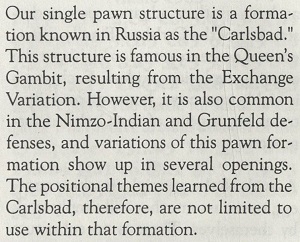
And from page 14:
Acknowledgement
for the above images: Cleveland Public Library
Wanted: more details about the origins of the
term ‘Carlsbad pawn formation’, whether in the
Soviet Union/Russia or elsewhere.
12062.
The
minority attack
Many games with the Carlsbad pawn formation lead
to a ‘minority attack’, another term whose origins
are of interest.
A basic explanation of the concept is on page 64
of Lessons in Chess Strategy by W.H.
Cozens (London, 1968):
‘The power of the queen’s-side majority was
first fully realized by Steinitz, who must be
considered the father of scientific chess. And
since the contact of two unequal pawn masses
normally leads to the formation of a passed pawn
from the larger mass, he held that it must be
bad strategy to advance a minority against a
majority – it would only hasten the creation of
a hostile passed pawn. This eminently logical
reasoning was accepted by his contemporaries and
disciples with the unquestioning deference
accorded to the logic of Aristotle in
pre-Galileo times.
But the young players of the early twentieth
century were a sceptical generation, who queried
every dogma and demolished more than one. One of
their heresies was to advance boldly with a
queen’s-side minority against a majority.
Admittedly, the result might be a passed pawn
for the enemy, but whereas the passed pawn he
would get if you waited for him to come at you
would be a powerful candidate for promotion, the
one he got out of your minority attack, they
argued, would be backward, probably isolated,
and an excellent target for rook attack on the
open files – in fact, more of a liability than
an asset.’
The term ‘minority attack’ became familiar in the
late 1930s, and page 247 of the June 1939 BCM
had a notable comment in its report on round seven
(comprising five games) of that year’s Margate
tournament:
‘This was a field day for the minority attack
in the Queen’s Gambit. The three grand masters
all played it and they all won. Flohr was rather
lucky in that Miss Menchik with an equal game
overlapped the time limit. The other two games
were won on their merits.’
Those games were Keres v Najdorf and Capablanca v
Golombek.
12063.
Wikipedia
From Alan Slomson (Leeds, England):
‘In relation to your comments in C.N. 12060
about the inadequate Wikipedia entry about
Nigel Short, it is worth noting that “Wikipedia
is a free online encyclopedia, created and
edited by volunteers around the world and hosted
by the Wikimedia Foundation” as it describes
itself.
Anyone can edit Wikipedia entries. If the
accuracy of Wikipedia is a matter of concern,
it is up to the community of chess historians
to improve entries relating to chess history
when they are felt to be inaccurate or
inadequate.’
As regards the English-language entries on chess,
there is a Wikipedia
project page.
Prompted by Mr Slomson’s remarks, we have
prepared a new feature article, Wikipedia
and Chess.
12064.
Alekhine
and property (C.N. 2605)
A remark by Euwe in an interview (CHESS,
September 1981, page 199):
‘Alekhine may have hoped the Germans would win
because he owned several houses in Leningrad. As
things went, he lost everything …’
Information about the Leningrad matter will be
appreciated.
12065. A
challenge
Which master was challenged to play a game as
Black against 1 e4 e5 2 Ke2?
Simon Alapin (Deutsches
Wochenschach, 7 January 1894)
The answer is Simon Alapin, in 1892, the
challenger being Max Lange. No such game was
played, but they did agree to contest one
correspondence game, with Alapin required to play
1 e4 e5 2 Ne2.
Page 299 of Deutsches Wochenschach, 21
August 1892 had carried a letter from Alapin
extolling 2 Ne2 and claiming that it should be
named after him. Max Lange made unfavourable
mention of this in a long article about chess
theory on pages 257-264 of the September 1892 Deutsche
Schachzeitung. On page 262 he suggested that
2 Ne2 deserved no more theoretical attention than
2 Ke2, which also blocks the king’s bishop and the
queen.
It was not until the 7 January 1894 issue of Deutsches
Wochenschach that Alapin related, on pages
4-10, what had happened during the interval of
more than a year. Around the time of the September
1892 article, Max Lange had challenged him to a
correspondence game in which he would take Black
against Alapin’s 1 e4 e5 2 Ne2 and also proposed
playing a game in which he, as White, would begin
1 e4 e5 2 Ke2 against Alapin, in order to ‘balance
the chances’.
Alapin agreed only to the 1 e4 e5 2 Ne2 game, and
stated that in the circumstances it became a
matter of life or death. In addition to the exact
dates when the game began and ended (see below),
Alapin even published the reflection time: 37 days
for White and 149 for Black, the remainder being
postal time. Alapin then annotated the game, over
six pages.
Simon Alapin – Max Lange
Correspondence, 23 September 1892 – 5 September
1893
Alapin’s Opening
1 e4 e5 2 Ne2 Nc6 3 d4 Qh4 4 d5 Bc5 5 Ng3 Nce7 6
Nd2 Qf6 7 f3 Qh4 8 Nb3 Bb6 9 d6 Nc6 10 c4 cxd6 11
Qxd6 Nf6
12 Kd1 Nh5 13 Nf5 Qd8 14 g4 g6 15 Ne3 Qf6 16 Qxf6
Nxf6 17 c5 Bd8 18 Nc4
18...d5 19 Nd6+ Ke7 20 g5 Nd7 21 exd5 Nb4 22 Bc4
Nxc5 23 Nxc5 Kxd6 24 Ne4+ Ke7 25 Bd2 a5 26 a3 Na6
27 d6+ Kf8 28 Bc3 h6 29 Bxe5 Rh7 30 Nf6 Bxf6 31
gxf6 Bd7 32 Rc1 Nb8 33 Bb5 Nc6 34 Re1 Rh8 35 Bxc6
Bxc6
36 Rxc6 bxc6 37 d7 Rd8 38 Bd6+ Kg8 39 Re7 g5 40
Kc2 Kh7 41 Kc3 Kg6 42 Kc4 Kxf6 43 Kc5 h5 44 Kxc6
Resigns.
The game was shown, from an undated scrapbook of
Walter Penn Shipley’s, in C.N. 771 (see page 49 of
Chess Explorations) with this concluding
remark by Showalter in the New York Recorder:
‘It would be difficult indeed to laud too
highly the masterly style in which Herr Alapin
conducted his attack in this game, the more
especially as applied to the latter half of it.
Truly, correspondence chess is the best chess,
after all.’
The date of Showalter’s column was 28 January
1894.
We show none of the nineteenth-century material
here, given that it is available online (e.g. via
Google
Books or Chess
Archaeology).
12066.
Brad Darrach v Bobby Fischer (C.N. 12049)
Many virtually identical (agency) obituaries of
Brad Darrach appeared in the US press, such as the
following on page 8 of the Daily Times
(Salisbury, MD) on 7 November 1997:
However brief, references to chess in the
mainstream media traditionally have a factual
mistake or two. In the penultimate paragraph
above, 1976 should read 1974.
One broadcast by Darrach, on WELI 960, can be
noted from that year, as listed on page 75 of the
Bridgeport Post, 26 December 1974:
John Donaldson (Berkeley, CA, USA) informs us
that he is continuing to investigate Brad
Darrach’s Bobby
Fischer
vs.
the Rest of the World (New York,
1974), and at this stage we quote the following
from him:
‘The New York bookseller Fred Wilson, active
since the 1970s, has mentioned to me that the
book never sold particularly well among the
chess community. He believes that it was
marketed to the casual player who had taken up
the game during the Fischer boom of the early
1970s. Anthony Saidy has told me that what
most stood out to him after reading the book
was Darrach’s habit of including himself in
conversations where he was not present. Frank
Brady has made the same observation. On the
basis of how he and his family were portrayed,
Saidy estimates that approximately 20% of the
book was fabricated.’
We add some jottings of our own. Although
published in mid-1974, the book was not mentioned
in Chess Life & Review (apart from the
January 1975 advertisement shown in our feature
article) until the May 1975 issue, in which
Fischer’s removal as world champion also happened
to be reported. The book was listed as being on
(direct) sale to USCF members only once, in the
August 1975 issue (with a members’ discount of 70
cents). Fischer’s lawsuit was announced in the
October magazine, and there are no sightings of
the name Brad Darrach in Chess Life &
Review in 1976.
It is of interest to note some of the attention
that Bobby Fischer vs. the Rest of the World
received in newspapers of the time.
In October 1974 an Associated Press report
(sometimes attributed to Dan Berger, and with
apparent input from Darrach) was published in
dozens of US newspapers. On newspapers.com
many appearances can be found by searching for
this paragraph:
‘Fischer is the second American ever to hold
the title, which must be contested every three
years. The first was Alexander Alekhin in 1937.’
Few lengthy reviews have been found, but a
notable critic of the book was R.E. Fauber
(1936-2013). On page 41/9 of the Sacramento
Bee, 23 March 1975 he observed:
‘Darrach is one of your usual kind of slick
journalist types who were pampered in English 1a
while in college. He happily quotes Fischer’s
description of him as a “pretty awful”
chessplayer. His ignorance of chess spills over
onto every page of the book.
... If you like books about fearful hysterics
and do not play chess well, you will love
Darrach’s.’
If Darrach’s ignorance of chess ‘spills over onto
every page of the book’, a few examples might be
expected, but Fauber preferred generalities, as in
the concluding paragraph:
‘In fairness to Darrach, he was up close for
most of the drama of the Fischer-Spassky match,
which he chronicles in the book. He seems a
careful reporter, but his consummate ignorance
of what competitive chess is about disqualifies
the tone and connotative value of the book. If
you must read it, get it at the library.’
Fauber returned to the book on page 23 of the 22
June 1975 edition of the same newspaper, writing
‘Then there is the even more execrable product of
rank and reeking amateurs such as Brad Darrach’s Bobby
Fischer vs the Rest of the World’ and
calling it ‘that hysterical essay’.
A lengthier article on Darrach’s work, by Juan
Rodriguez (1948-2024) on page 34 of the Montreal
Star, 29 March 1975, took a very different
view: the book was ‘absorbing – and hilarious’.
The concluding paragraph by Rodriguez (‘the Montreal
Star’s rock music critic’):
‘Even if you’ve never heard of Bobby Fischer,
this book will make you laugh for hours.’
The review gave the publisher as McCraw-Hill
Ryerson, and not Stein and Day.
The longest review that we have found is by Martin
Johnston (1947-90) on page 13 of the
‘Weekend magazine and book reviews’ section of the
Sydney Morning Herald, 15 February 1975.
Some extracts:
‘There is a small and curiously interesting
class of books whose authors give the impression
of being, on the one hand, the only people
qualified to write on a particular subject and,
on the other, quite incapable of doing so. This
book is one of them. While I quake at the
thought of Mr Darrach (whose apprenticeship was
ten years as film reviewer for Time,
which to me speaks for itself) writing on
anything, I have to admit that the very
qualities that make this book so unpleasant may
well be those best qualifying the author for
admittance to the confidence of the monstrous
genius Fischer.
Fischer, as even non-players are generally
aware, is not a lovable man. We tend, of course,
to make allowances for genius in the spirit of
Auden’s elegy on Yeats: “You were silly like us;
your gift survived it all.” To describe
Fischer’s oddities of character as merely
“silly” seems, by contrast, risibly inadequate.’
‘... What Darrach does, much more than
Fischer’s affable biographer Frank Brady, is to
bring the reader brutally face to face with the
private figure – lonely, insecure, arrogant, an
almost inarticulate genius with the culture of a
gum-chewing bovver boy and the social feelings
of a warthog – behind the public antics.’
‘He [Darrach] provides lurid snaps of Fischer
in paranoid terror of Soviet Machiavellianism;
Fischer as inconsiderate lout; Fischer as idiot
savant – anything, indeed rather than try
to capture what Fischer is and why.’
‘... Darrach can’t write, except the nauseating
hip prolixities of the New Journalese.’
‘...Darrach’s book (despite one additional
deficiency – an apparent inability to
distinguish between fact, speculation and
gossip) is unavoidably fascinating, because of
its subject, and Darrach’s proximity to him; but
it hardly deserves to be.’
‘... So why buy Darrach? Well, out of place
though his smug trendiness is in this company
[the previous paragraph praised other writers,
singling out Purdy], he is the only one to show
us Fischer with the defences down, as one
grotesque to another. I hate recommending it but
I have to: if you like Bosch or Grünewald,
you’ll love this.’
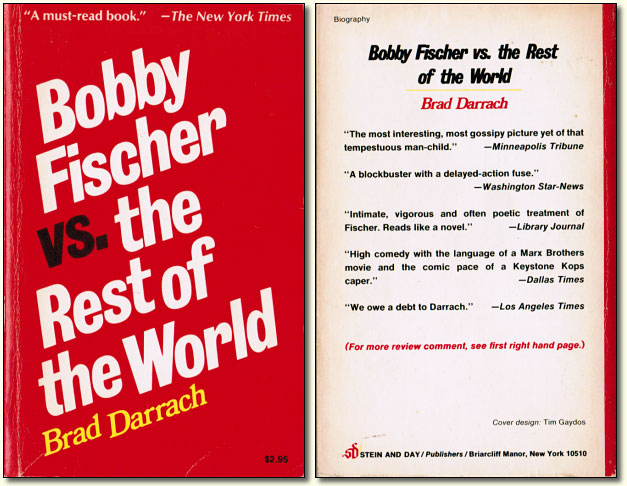 The final quote on the back cover of Bobby
Fischer vs. the Rest of the World was ‘We
owe a debt to Darrach’. That was from an article
by Burt Prelutsky (1940-2021) on page 16 of the
‘Calendar’ section of the 5 January 1975 edition
of the Los Angeles Times:
‘Asked what impressions he retains of his three
months in Reykjavik, Darrach says, “It was like
being in the trenches. For weeks on end, I
averaged no more than an hour’s sleep a night. I
was up all day, reporting the event for Life,
and then Bobby would insist on keeping me awake
all night, talking. I was strained to the
breaking point, and ended the summer on the
verge of a nervous breakdown. My muscles never
totally recovered from the ordeal. It wasn’t
just the physical abuse, though. Being with
Bobby is like being with a robot on some dumb TV
show, pretending to conduct rational dialogues.
He is a totally frozen person. The only time you
could make him happy and get a spontaneous
reaction from him was if you told him about a
disaster. Tell him about an earthquake or a
plane crash or an outbreak of the plague, and he
couldn’t help smiling. Psychologically, as his
sister says, he’s a three-year-old child; he’s a
mess. He is a man consumed with hatred. He
speaks of destroying his opponents with brute
force. To win is never enough, he also must
humiliate. Chess, at Fischer’s or Spassky’s
level, is aggression at the outermost extreme.”
I asked Darrach whether he had ever dared
challenge Fischer. “We’ve played a few times.
And although I am what Bobby refers to with
contempt as a weaky and he obviously wasn’t
going all out, they were brutal experiences. His
concentration is so total that it hits you in
waves of force. After a while you can hardly
breathe.”
We owe a debt to Darrach. Like such fearless
correspondents as Richard Harding Davis and Sir
Henry Stanley, he has ventured forth to where
only the bold, the brave and the loony would
dare set foot. He has not written a book about
chess or even just a book about chessplayers,
exactly. What Darrach did, like a latter-day
Ernie Pyle, was to file blood-stained dispatches
from Reykjavik, the unlikely site of World War
II½.’
12067. Soviet photographs
Vladimir Neistadt (Barnaul, Russia) submits two
photographs:
G.S.A. Wheatcroft
and A. Kotov
In the above item (from page 312 of Шахматы в
СССР, October 1958) Kotov, Flohr and
Botvinnik are with one of Capablanca’s brothers,
Aquiles, who was a delegate at an International
Congress of Architects in Moscow.
12068.
Cheltenham
v Sochi
Vladimir
Neistadt also reverts to C.N. 5249, which
quoted from C.H.O’D. Alexander’s Sunday Times
column on page 82 of the Supplement, 8 April 1973:
‘Punch-drunk at the moment from struggling with
my games in the World Team Final I am incapable
of annotating anyone else’s games; here,
therefore, is one of my own [against Ulyanov]
from a Cheltenham v Sochi friendly match.
Friendly – yes I suppose so; but not conducted
in any spirit of levity or undue haste. One of
our team went round the world by sea in the
middle and only got two moves behind the rest of
us; and while I won this game in the
comparatively short time of 2½ years, in my
other game against Ulyanov I have been on the
defensive for four years – I hope to equalize
any year now.’
Our correspondent asks to see the game published
by Alexander, and requests any further information
about the match between Cheltenham and Sochi (the
places were twinned), such as the other
participants’ names.
Below is the score of the Alexander v Ulyanov
game published, with notes, in the Sunday
Times, and dated 1968-70:
1 e4 c5 2 Nf3 d6 3 d4 cxd4 4 Nxd4 Nf6 5 Nc3 a6 6
Bc4 e6 7 Bb3 Be7 8 f4 O-O 9 f5 e5 10 Nde2 Nc6 11
Be3 b5 12 Nd5 Nxe4 13 O-O Rb8 14 c3 Bg5 15 Qd3 Nc5
16 Bxc5 dxc5
17 f6 c4 18 Qg3 h6 19 Rad1 cxb3 20 h4 Kh7 21 fxg7
Kxg7 22 Rf6 bxa2 23 hxg5 Qxd5 24 Rxd5 a1(Q)+ 25
Rf1 Qxf1+ 26 Kxf1 h5 27 Rd6 Resigns.
Alexander also discussed the match on page 98 of
A Book of Chess (London, 1973), published
shortly before his death:
Acknowledgement:
Cleveland Public Library
In the introduction to the 8 April 1973 Sunday
Times column, Alexander gave some general
observations on postal
play:
‘Though much correspondence play, even at
international level, is surprisingly bad,
playing C.C. makes one realize that chess is
difficult; I can take as much time as I like and
still get it wrong. Apart from oversights (you
make those after two hours’ thought as well as
after two minutes’) there are three causes of
failure. First, inadequate opening knowledge;
how many innocents come to grief through
trustingly following MCO on the
assumption that it must be right. Next lack of
imagination – you simply fail to see a possible
line. Most important, faulty judgement; one
weighs up positions wrongly.’
12069.
Art
or science
Mentioning C.H.O’D. Alexander’s ‘fascinating’ A
Book of Chess on page 4 of the Saturday
Magazine of the Birmingham Post, 10
November 1973, Peter Gibbs wrote:
‘The first chapter of the book gives the finest
dissertation I have read on whether the game is
an art or science.’
12070.
Sayings
On page 222 of the September 1938 Chess
Review, the dictum ‘Passed pawns must be
pushed’ was attributed, without any particulars,
to Reuben Fine. Can earlier citations (with ‘must’
or ‘should’) be found?
The saying appeared twice (see diagrams 9 and 10
below) in an unsigned feature on the inside front
cover of the May
1959 Chess Review:
Diagram 3 mentions the dictum ‘Always check – it
may be mate’, which has been discussed in C.N.
(often with the wording ‘never miss a check, it
might be mate’). The Chess Review text
also has a German term seldom seen:
‘Quiz positions, however, tread their own ways
and consequently may dangle the Wopatzerschach
as bait.’
The word was used by Hans Kmoch on page 146 of
the May-June 1934 Wiener Schachzeitung, in
his notes to the ninth match-game between
Bogoljubow and Alekhine (Pforzheim, 25 April
1934), after 1 d4 c5 2 d5 e5 3 e4 d6 4 f4 exf4 5
Bxf4 Qh4+:
As mentioned in C.N. 7728, the Wiener
Schachzeitung is available online at the ANNO website.
An earlier occurrence of Wopatzerschach
was on page 832 of the December 1930 issue of Der
Querschnitt, in a chess skit, Schachwelsch,
by Eugen Lazar:
See also our new feature article, Chess:
‘Never
Miss
a Check’.
Diagram 6 in the May 1959 Chess Review
feature was accompanied by a mysterious text:
‘“A fool and his position are soon parted”,
said that sage of non-playing chess adherents,
Meyer Shevron.’
Concerning the text for diagram 9, variants of
Purdy’s advice ‘Look for moves that smite’ can be
found, but what is the best/earliest citation?
Finally, diagram 10 begins by quoting James
Mason: ‘Every passed pawn is a potential queen.’
On page 130 of The Principles of Chess in
Theory and Practice (London, 1894) Mason did
not limit his remark to passed pawns:
‘Every pawn is a potential queen.’
12071.
Heathcote
and Chigorin
Michael McDowell (Westcliff-on-sea, England)
draws attention to pages 48 and 238 of Alain C.
White’s 1918 Christmas book Chess Idylls
(a collection of problems by Godfrey Heathcote):
As our correspondent notes, the
Heathcote-Chigorin episode has often been related,
but what exactly did Chigorin write in Novoye
Vremya?
12072.
Capablanca
interview
In connection with Capablanca’s simultaneous
display in Hastings on 23 August 1919, the
following unsigned interview was published on page
4 of the Birmingham Evening Despatch two
days later:
‘In a brief chat in Spanish he said to me: “I
think I must have imbibed the love of chess with
my mother’s milk. At the age of four I played
against my uncle at Havana – and beat him, too.
I obtained a silver watch as the prize for my
first win. This watch is my mascot, and I shall
never part with it.”
“Have you any hobbies?”, I asked him, “or are
you interested in nothing but chess?”
“Oh, yes”, said he, “I am very fond of a game
of tennis, and people tell me that I should
become a first-class player if I gave more time
to the game. I love a good book. I revel in
Ibáñez’s novels, in the plays of Benavente, in
Shakespeare, and in Carlos [sic]
Dickens.”
“Do you ever play billiards?”
“I have played several games”, said Capablanca,
adding with a quizzical little smile, “but I
have a tendency to send the ball across the edge
of the table, and I have made some little rips,
too, in the cloth. For this reason I am not
exactly a welcome visitor to a billiard saloon.”
To sum up, in José Capablanca we have a
striking instance that it is possible to combine
an enormous power of concentration with a
remarkable versatility and a zest for all those
intellectual and physical exercises that go to
the making of a many-sided man.’
The accuracy of details in such interviews is not
to be taken for granted.
12073.
Saint-Amant
Dominique Thimognier (Fondettes, France) has been
sifting through the contradictory evidence about
the name, date of birth and date of death of an
eminent nineteenth-century chess figure:
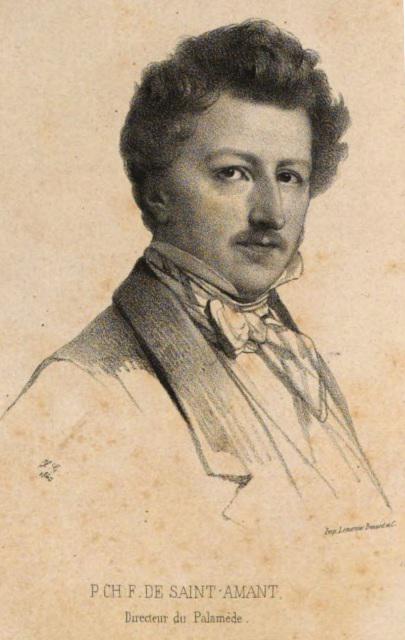
‘Le
Palamède, 15 July 1842 (frontispiece)
Pierre Charles Fournié de Saint-Amant came
from a noble family in the south west of
France. Much of what is known about him is
derived from the obituary by Jean Preti in La
Stratégie, 15 December 1872, pages 353-355.
From page 354:

These lines in the obituary contain no fewer
than three errors. Firstly, he was born at
Château Latour, not “de Latour”, as was
confirmed by the French chess historian Louis
Mandy in an article for L’Echiquier de
France, April 1956, pages 75-76 after
visiting the site:
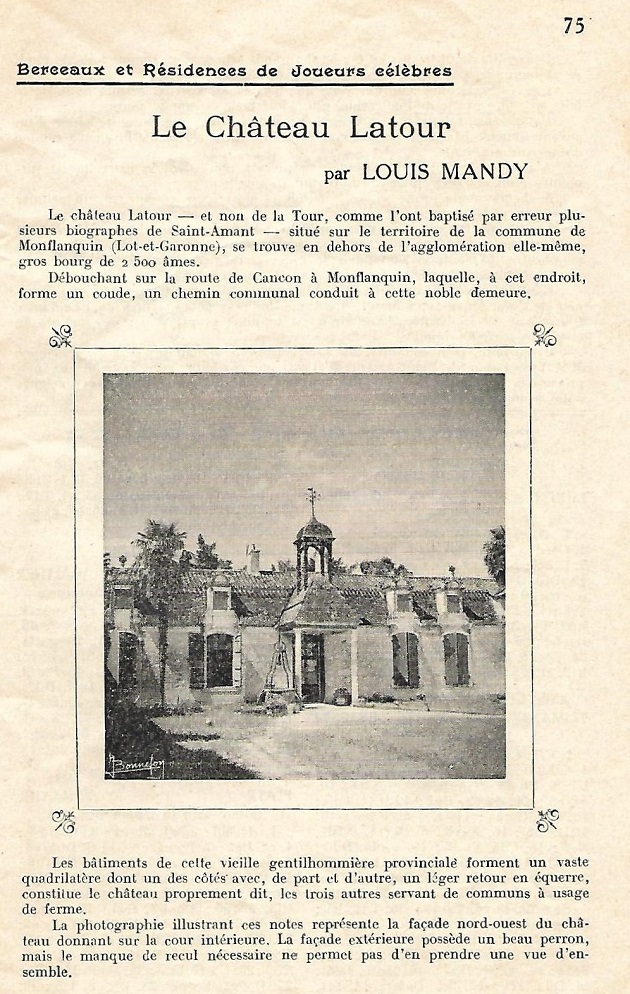
Nor was he born on 12 September 1800, a
mistake repeated in some reference works,
including Jeremy Gaige’s Chess Personalia
(1987). The departmental archives of
Lot-et-Garonne provide online access to his
birth record (not publishable online without
their consent). He was born on 12 Vendémiaire,
Year IX of the French Republic. It is likely
that Preti erred when converting that date
(from the calendar used in France from 1792 to
1805) into the Gregorian calendar; it should
be 4 October 1800. The error was noted as
early as 1887, as the date 4 October 1800 is
in the Biographie Générale de l’Agenais
by Jules Andrieu (Paris and Agen, 1887),
volume 2, pages 269–270.
See also this Edo
page on Saint-Amant.
His name was stated incorrectly in the La
Stratégie obituary, given that the birth
record states Pierre Charles Fournié Saint
Amant:
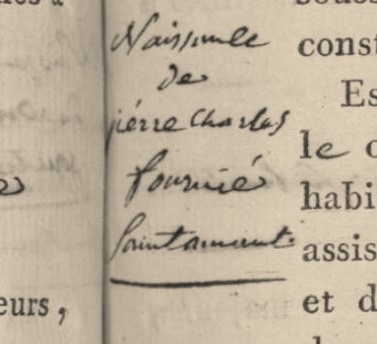
During the period of the Revolution it would
be unthinkable for a civil registrar to
include the aristocratic particle “de” on a
birth record. However, the spelling “Fournié”
is noteworthy.
When Saint-Amant resumed management of Le
Palamède he published the “Acte de
société” to relaunch the magazine (C.N.
5473). The notarized document also had
“Fournié”.
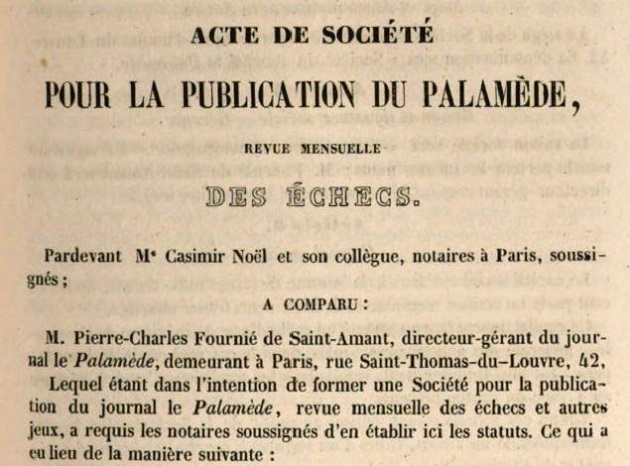
Le Palamède,
15 November 1842, page 197
That spelling was also used in an article
about him in the BCM 20 years after
his death, on pages 49-50 of the February 1892
issue. (Signed “W.W.”, i.e. William Wayte, the
article also erroneously gave his birth-date
as 2 September 1800.)
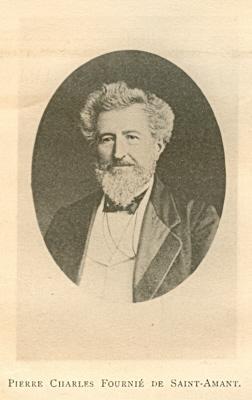
BCM, February
1892, opposite page 49
Below is another article by Louis Mandy, on
pages 611-612 of L’Echiquier de France,
January 1958:
There has been confusion surrounding
Saint-Amant’s death. In 1861, he retired to
Algeria, where he had bought the Château
d’Hydra on the outskirts of Algiers, in the
commune of Birmandreïs (today Bir Mourad
Raïs). He died as the result of a fall. The
widely accepted date of his death was 29
October 1872, as reported in the French press
of the time (e.g. Le Sport, 20
November 1872, pages 2-3) and as also
inscribed on his tombstone, noted by Louis
Mandy in an article on page 75 of Europe
Echecs, April 1961:
The same date, 29 October 1872, appears in Chess
Personalia, but, as Hans Renette pointed out
in C.N. 7609, the death record of Saint-Amant,
available online via the ANOM (Archives
Nationales d’Outre-Mer), shows a small
discrepancy. The record, drafted on 29 October
1872, unequivocally states that Pierre Charles
Fournié Saint Amant had died at three o’clock
the previous afternoon. The margin of the
record confirms the date as 28 October 1872:
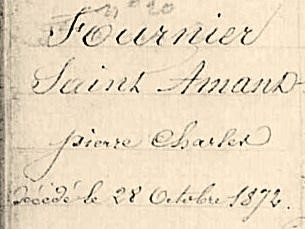
The civil registrar spelled his name
“Fournier”, and with no hyphen between “Saint”
and “Amant”.
During his time as director of Le
Palamède (December 1841 to December 1847)
Saint-Amant invariably signed each issue as
follows: “Le directeur du Palamède,
rédacteur en chef. Saint-Amant”. Frequent
contributors to the magazine, such as Alphonse
Delannoy and George Walker, referred to him
simply as “Saint-Amant” or “St-Amant”. Below
is one example, from page 9 of the 15 January
1846 issue:

The New York, 1857 tournament book (page 84)
includes “Mr Charles St Amant of Paris” among
the foreign Honorary Members of the American
National Chess Association:

Fiske’s book was not published until 1859,
but in his column on page 2 of Le Sport,
30 June 1858 Saint-Amant mentioned receiving
documentation from the Association, and he
reproduced the same list without any spelling
changes to the name “Charles St-Amant”:
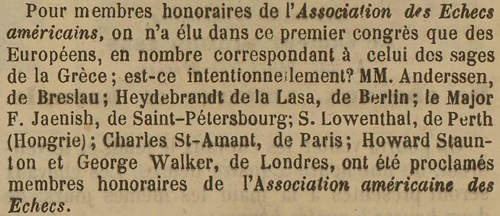
That spelling also appeared in Paris
newspapers which announced his death (e.g. Le
Gaulois, 13 November 1872, page 2, and La
Gazette des Etrangers, 14 November 1872, page
1).
To conclude, although there is much
confusion over Saint-Amant’s name and the
dates of his birth and death, no evidence has
been found that he ever used the spelling
“Fournier”, or that he included the
aristocratic particle “de” except on formal
occasions. It would seem that his record
should therefore read as follows:
Formal complete name: Pierre Charles
Fournié de Saint-Amant;
Commonly used name: Charles Saint-Amant;
Born: 4 October 1800, Château Latour,
Montflanquin, France;
Died: 28 October 1872, Château d’Hydra,
Birmandreïs, French Algeria (today Bir
Mourad Raïs, Algeria).’
12074.
Heathcote
and Chigorin (C.N. 12071)
Mate in two
From Dmitriy Komendenko (St Petersburg, Russia):
‘The Heathcote problem was published in Novoye
Vremya, issue 5454 (19 May 1891, page
3). The solution was given in issue 5481
(15 June 1891, page
3). Issue 5623 (5 November 1891, page
4) had a claim about 1 Nf2 being a
“simple solution”, as mentioned by Alain C.
White. However, in issue 5634 (16 November
1891,
page 3) that “solution” was
described as “an accidental
misunderstanding”.’
12075.
Winning and drawing
The front cover of Les Cahiers de l’Echiquier
Français, January-February 1934 ascribed the
following remark to Emanuel Lasker:
‘Si vous désirez la nullité, jouez pour le
gain.’
That advice is often seen (in various wordings,
such as, in English, ‘If you want a draw, play for
a win’), but when was it first seen?
12076.
Stalemate
Stalemate
records both Lasker and Capablanca expressing
doubts as to whether a game ending that way should
be considered drawn. Below are further thoughts
from Lasker, in his New York Evening Post
column of 8 May 1907, page 7:
‘In olden times a sanctuary was a refuge for
persecuted men who had no means of resistance.
The sanctity of the place was respected, and
often the vanquished in war escaped in this way
the cruelty of the victors. The custom has died,
but it has left a faint trace of its former
existence in the ancient game of chesse [sic].
In the Middle Ages the rule was established that
the king, in its most helpless position, when
none of its side could move without exposing the
king to capture, was safe, provided that the
opponent had made no direct attack against the
king. The position was called stalemate, and the
game originally counted a win for the stalemated
party, but is now reckoned a draw.
On account of this rule, the side that is under
a disadvantage often escapes the rigorous
punishment to which, in the logic of events, it
would be exposed. The game would be a gainer in
some respects if the rule were entirely
abolished. It would then be easier to nurse
small advantages to a win. But, as compensation,
we have numerous fine combinations that owe
their origin to the stalemate clause, and it
gives a faint glimmer of hope to the weakened
defender, even under the most desperate
circumstances.’
12077.
Moscow,
1925
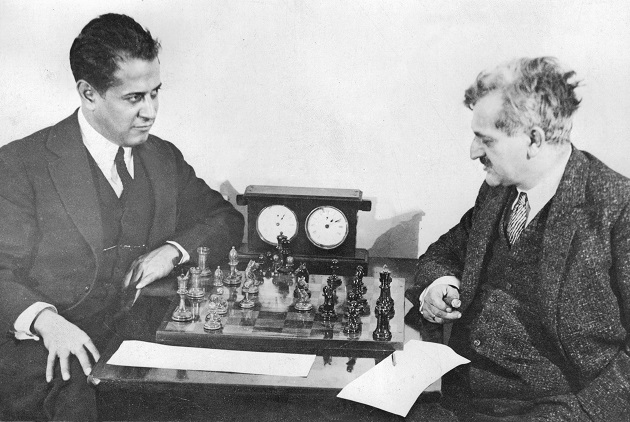
Our recent Moscow,
1925 feature article includes the above
photograph. A different one from the same occasion
is on page 318 of volume two (Berlin, 2020) of
that outstanding
series Emanuel Lasker edited by
Richard Forster, Michael Negele and Raj
Tischbierek, with this caption:
‘Capablanca and Lasker in a picture set up
during the Moscow, 1925 tournament (one of
several versions of the photograph). Their epic
encounter in round 14 of the New York, 1924
tournament was not documented by any
photographer.’
Page 164 of the co-authors’ third volume (Berlin,
2022) had a full-page, and full-length,
photograph:
‘A picture showing the two champions in
analysis has been reproduced (and doctored) in
dozens if not hundreds of publications. This
shot from the magazine Prozhektor offers
a slightly different angle and includes many
details missing from the better-known versions.’
We are looking for a high-quality version of the
seldom-seen Moscow, 1925 group photograph, shown
below in a small size for reference:
12078.
Games
compared
The first paragraph of a review of The
American Draught-Player by Henry Spayth (New
York, 1860) on page 505-506 of the Atlantic
Monthly, April 1860:
‘Almost everybody plays the game of draughts,
but few have any insight into its beauties; and
many who look upon chess as a science rather
than an amusement regard draughts as a childish
game, never suspecting what eminent ability and
painstaking research have been expended in
explaining a game which is inferior to chess
only in variety and far superior in scientific
precision.’
See Chess
and
Draughts/Checkers.
12079.
From
behind
The French cartoonist [Jacques-Armand] Cardon can
skilfully depict his subjects (often politicians)
from behind. See, for instance, Vu
de
dos.
C.N. 10217 gave this cartoon in Henry Grob:
der Zeichner und Maler by Henry Grob
(Zurich, 1965):
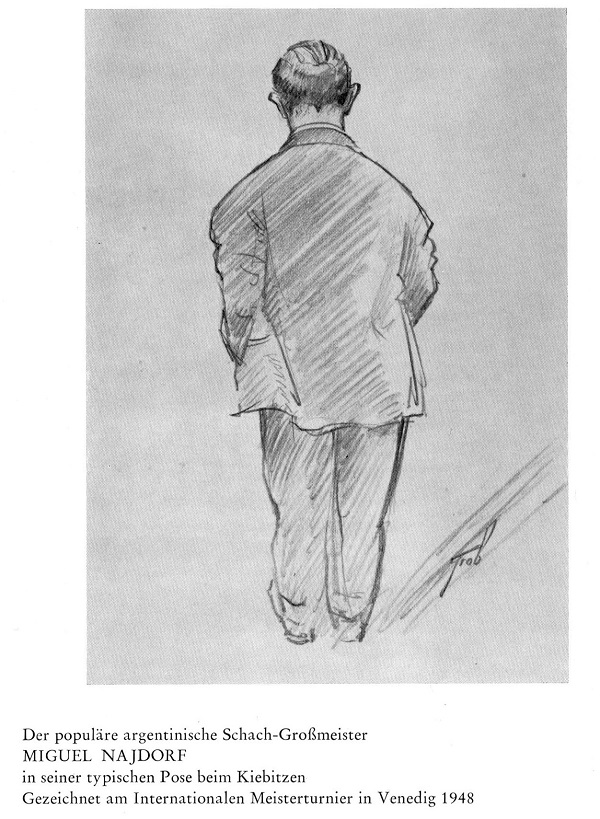
Other chess specimens are sought. One that comes
to mind shows Reshevsky, on page 52 of the June
1992 Chess Life:
12080.
The
Hague, 1928
C.N. 5637 gave a photograph from page 403 of El
Ajedrez
Americano, October 1928:
A detail has been provided by the Cleveland
Public Library:
It is a Four Knights’ Game position arising after
1 e4 e5 2 Nf3 Nc6 3 Nc3 Nf6 4 Bb5 Bb4 5 O-O O-O 6
d3 d6 7 Bg5 Ne7.
12081.
Przepiórka v von Scheve
As mentioned in C.N. 2476 (see The
Best
Chess Games), pages 222-223 of volume two of
Les Cahiers de l’Echiquier Français (issue
23, 1930) stated that Dawid Przepiórka’s favourite
game was an offhand encounter (against Theodor von
Scheve):
1 e4 e5 2 Nf3 Nc6 3 Bc4 Bc5 4 c3 d6 5 d4 exd4 6
cxd4 Bb6 7 Bg5 Nf6 8 h3 h6 9 Bh4 g5 10 Bg3 Nxe4 11
O-O O-O 12 Nc3 Nxc3 13 bxc3 Qf6 14 Nh2 Qg6 15 Kh1
Ne7 16 f4 d5 17 Be2 Bf5 18 Bh5 Qg7 19 Qd2 Be4 20
fxg5 hxg5
21 Rf6 Qxf6 22 Be5 Qf5 23 Ng4 Kh7 24 Nf6+ Kh6 25
Bg4 Qg6 26 h4
26...Nf5 27 hxg5+ Kg7 28 Nxe4+ f6 29 Nxf6 Rxf6 30
Bxf6+ Kf7 31 Qf4 Nd6 32 Rf1 Resigns.
Without stating where or when the game was
played, the Cahier included some
annotations, the source being merely ‘Rivista
Scacchistica Italiana’.
Below, courtesy of the Cleveland Public Library,
is the game’s appearance on pages 232-233 of the
November/December 1903 issue:
The game had been annotated by Przepiórka himself
on page 92 of Akademische Schachblätter,
September/October 1903:
Pages 8-9 of the booklet referred to in C.N.
5768, Dawid Przepiorka His Life and Work
by Tomasz Lissowski (Nottingham, 1999), noted what
had appeared in the Rivista Scacchistica
Italiana but dated the game 1904 (as we did
too in C.N. 2746). The correct date, 1903, was
included in a later, more detailed monograph
(mentioned in C.N. 8266): Mistrz Przepiórka
by Tomasz Lissowski, Jerzy Konikowski and Jerzy
Moraś (Warsaw, 2013). The book’s annotations to
the game against von Scheve (on pages 147-148)
refer to Akademische Schachblätter (not to
the Rivista Scacchistica Italiana), but
with a fresh assessment. In particular,
Przepiórka’s ‘21 Rf6!!’ becomes ‘21 Rf6?’.
We have a general feature article on Dawid
Przepiórka in preparation. [Addition: it was
posted on 28 December 2024.]
|
